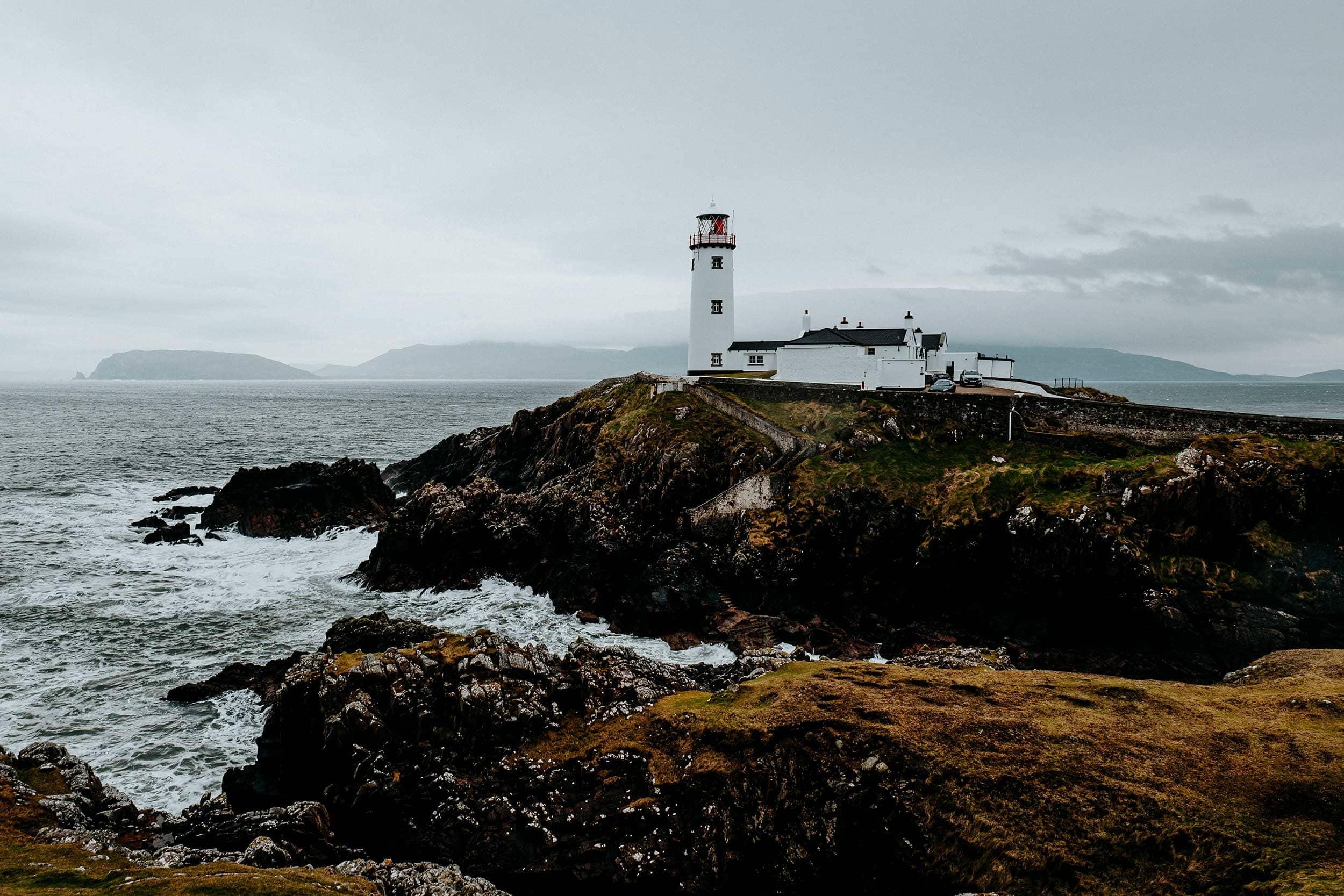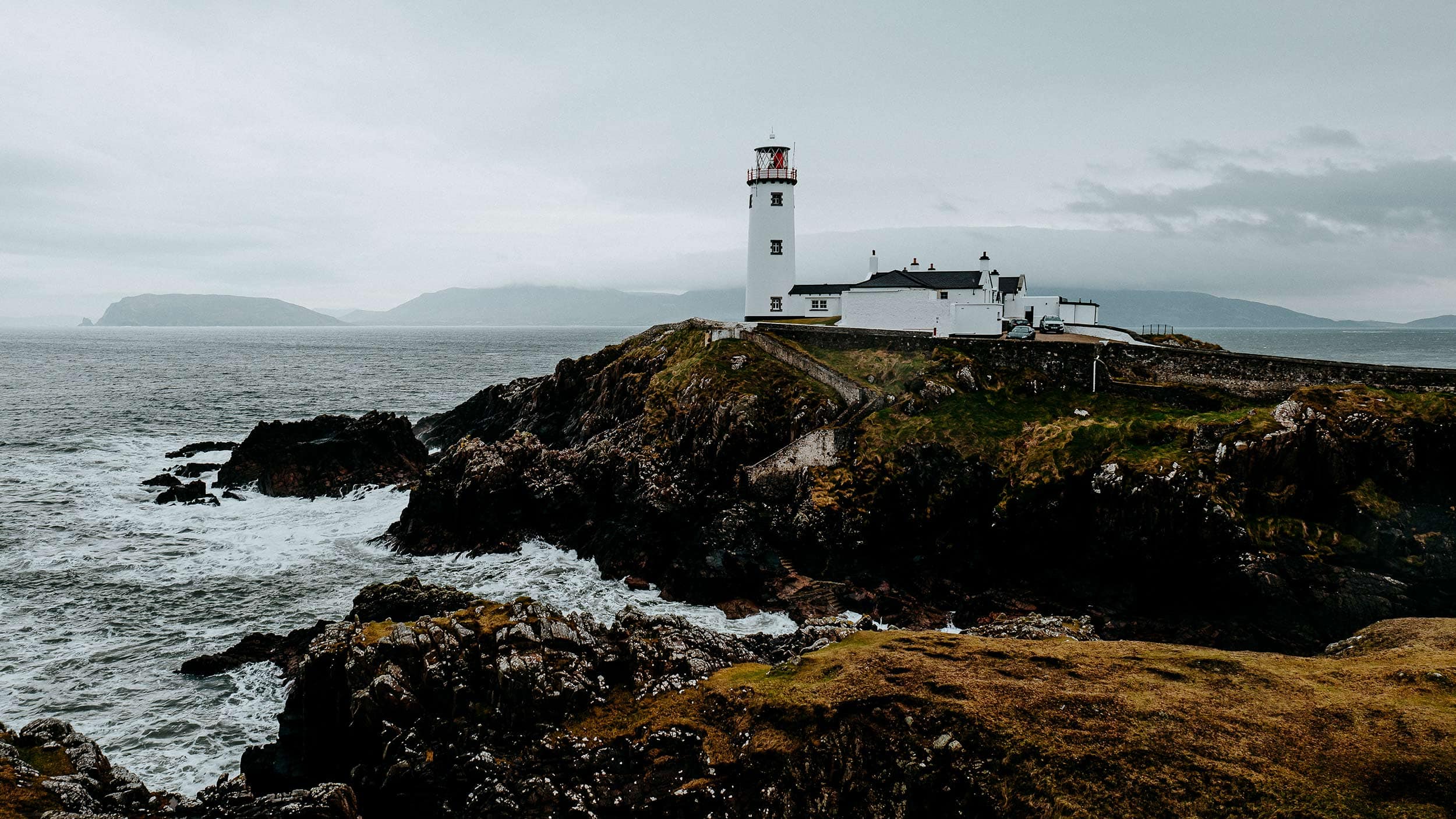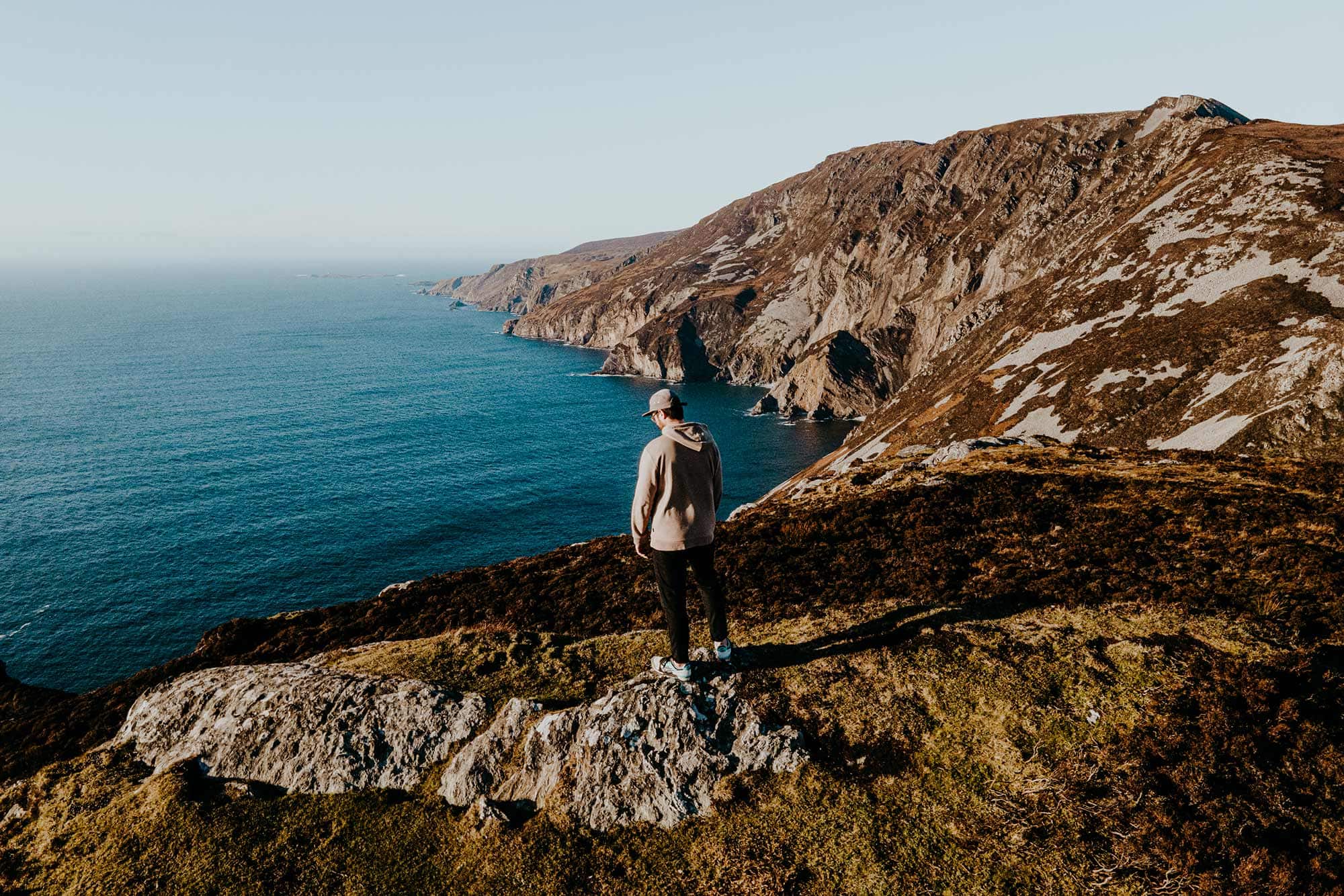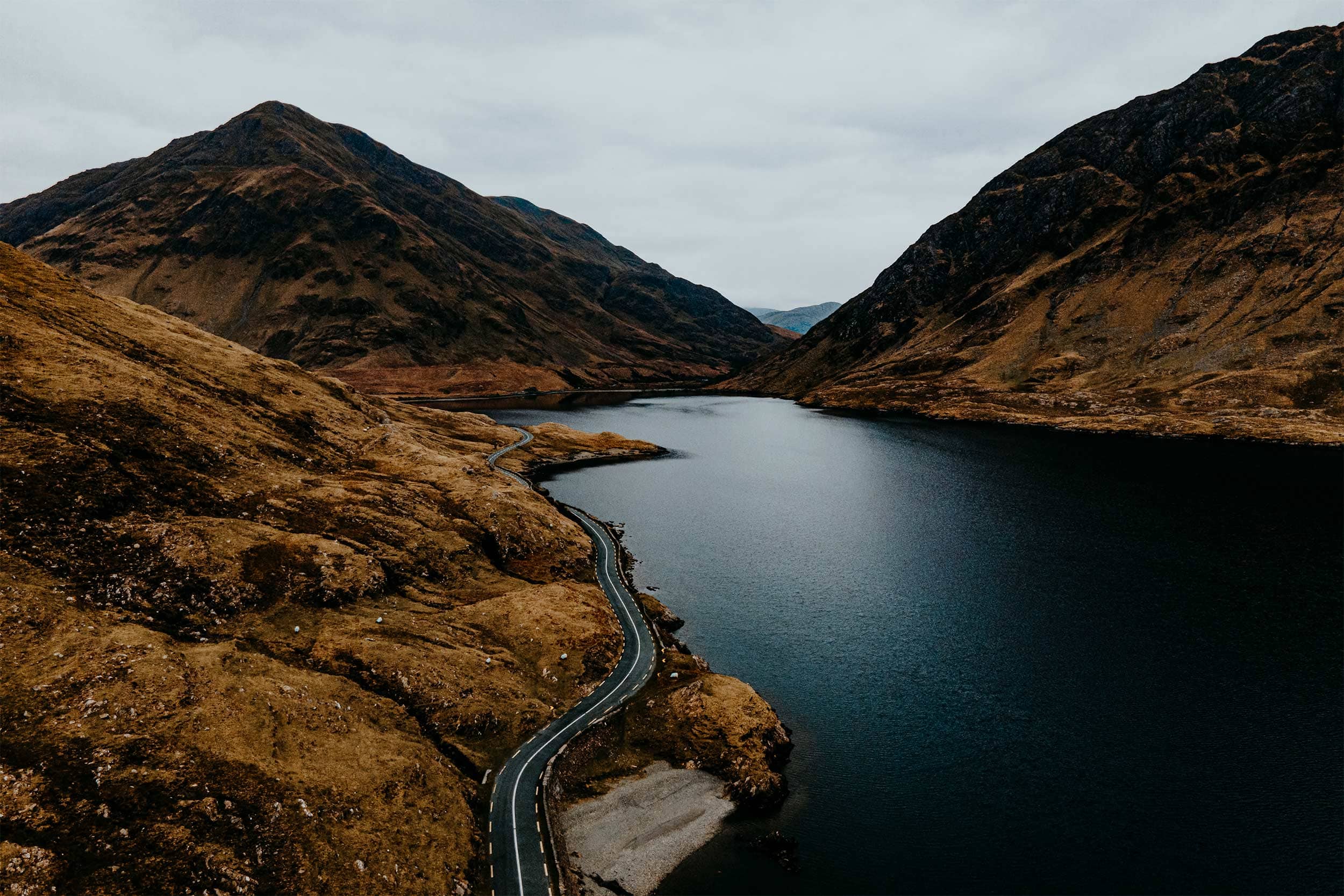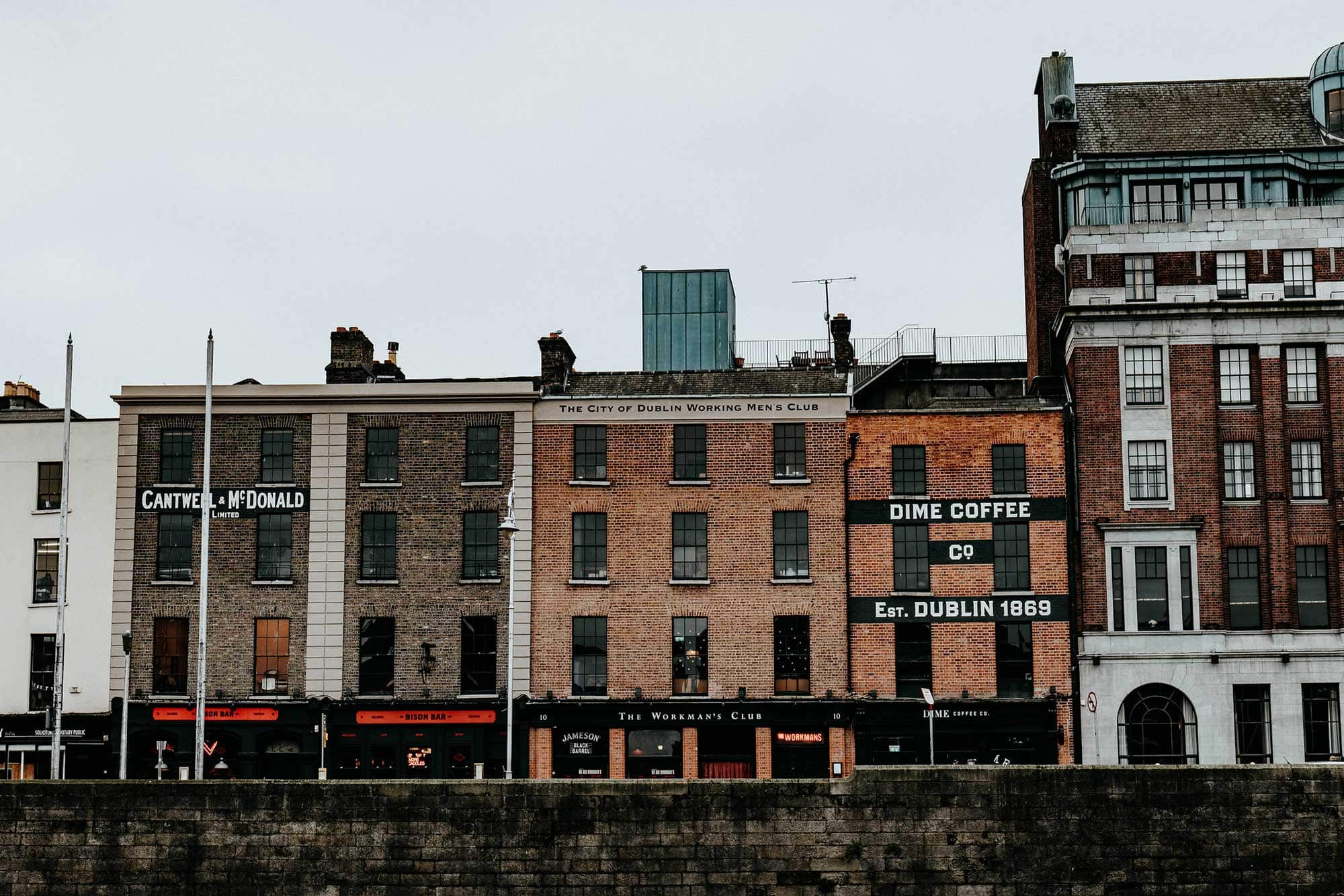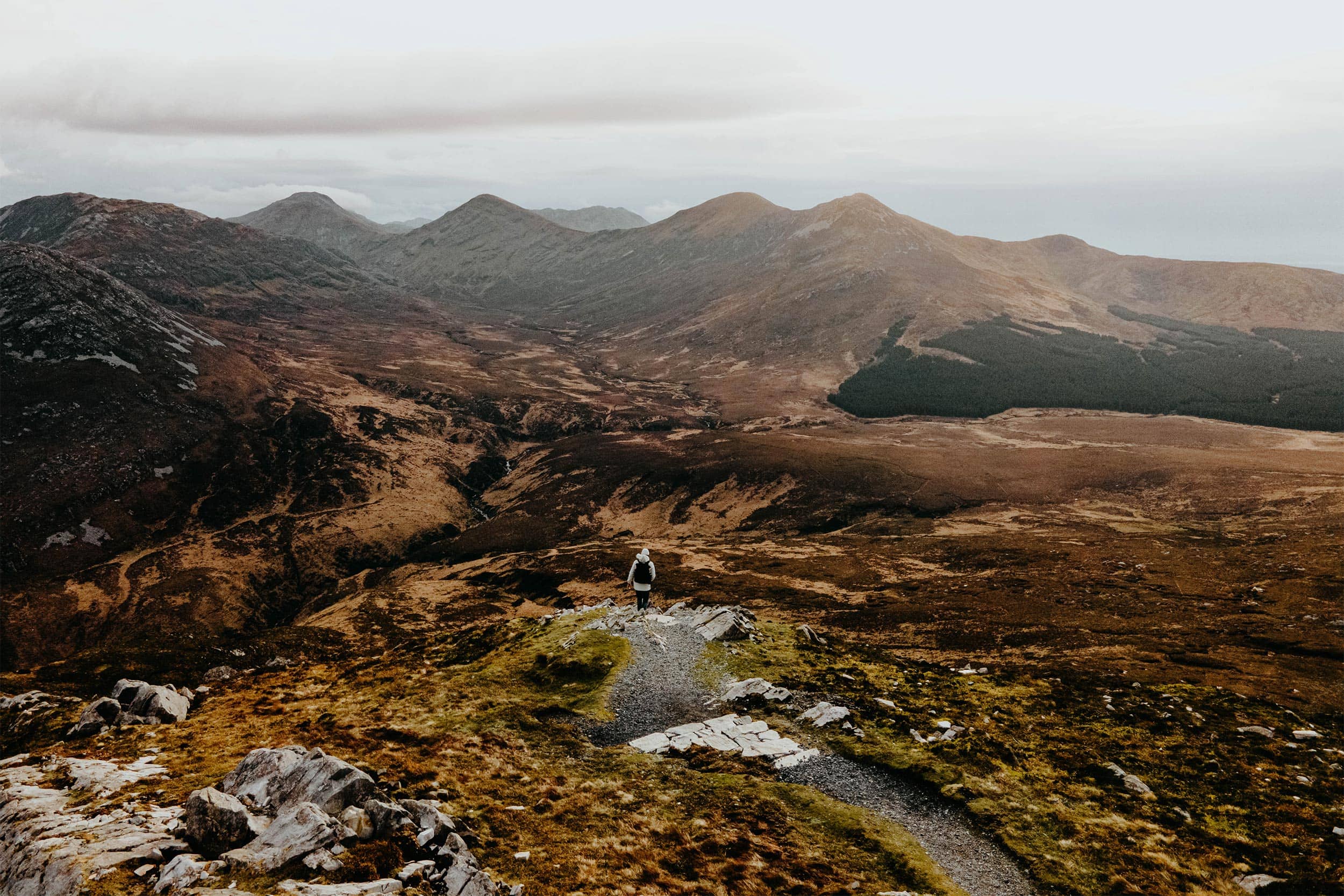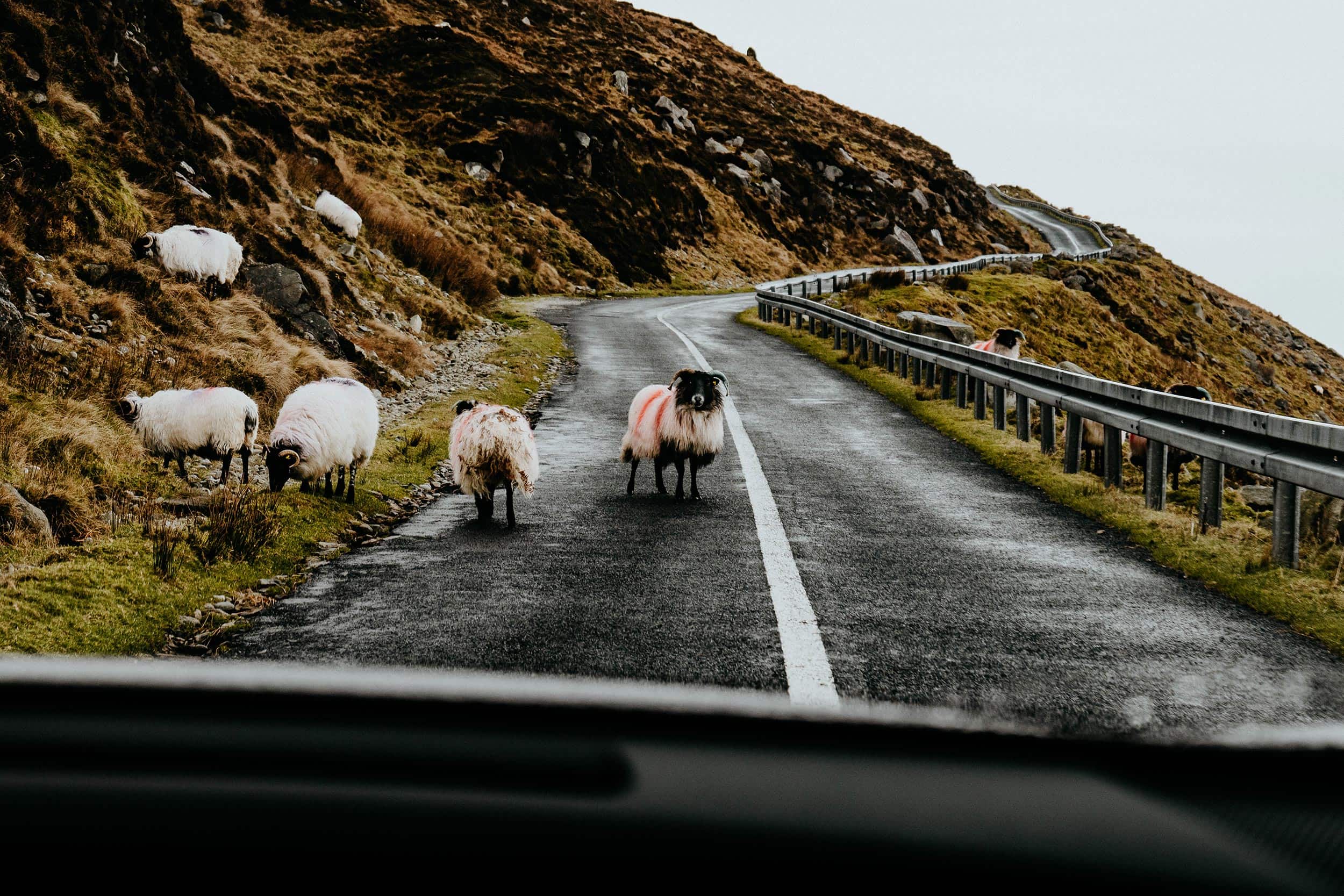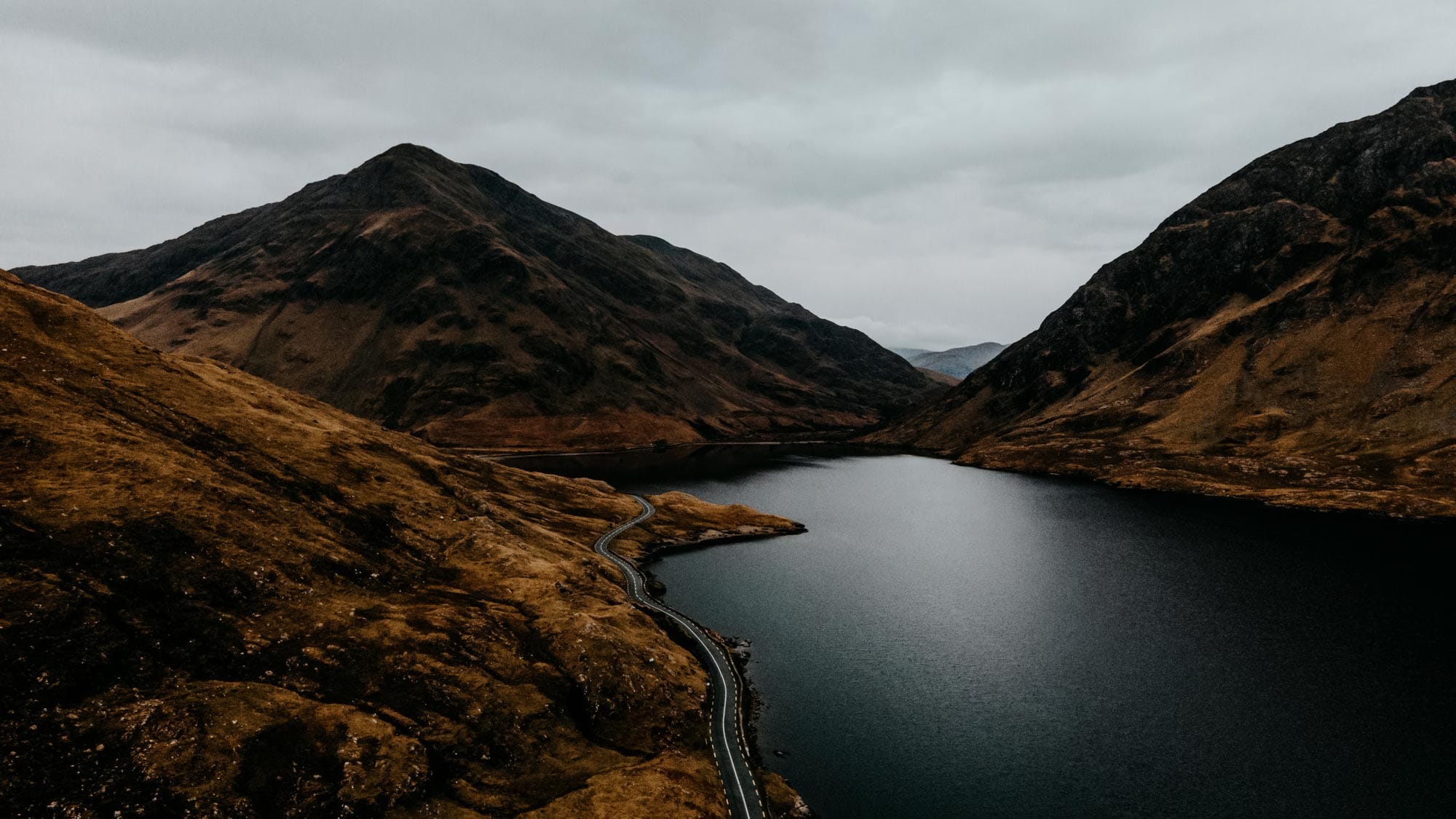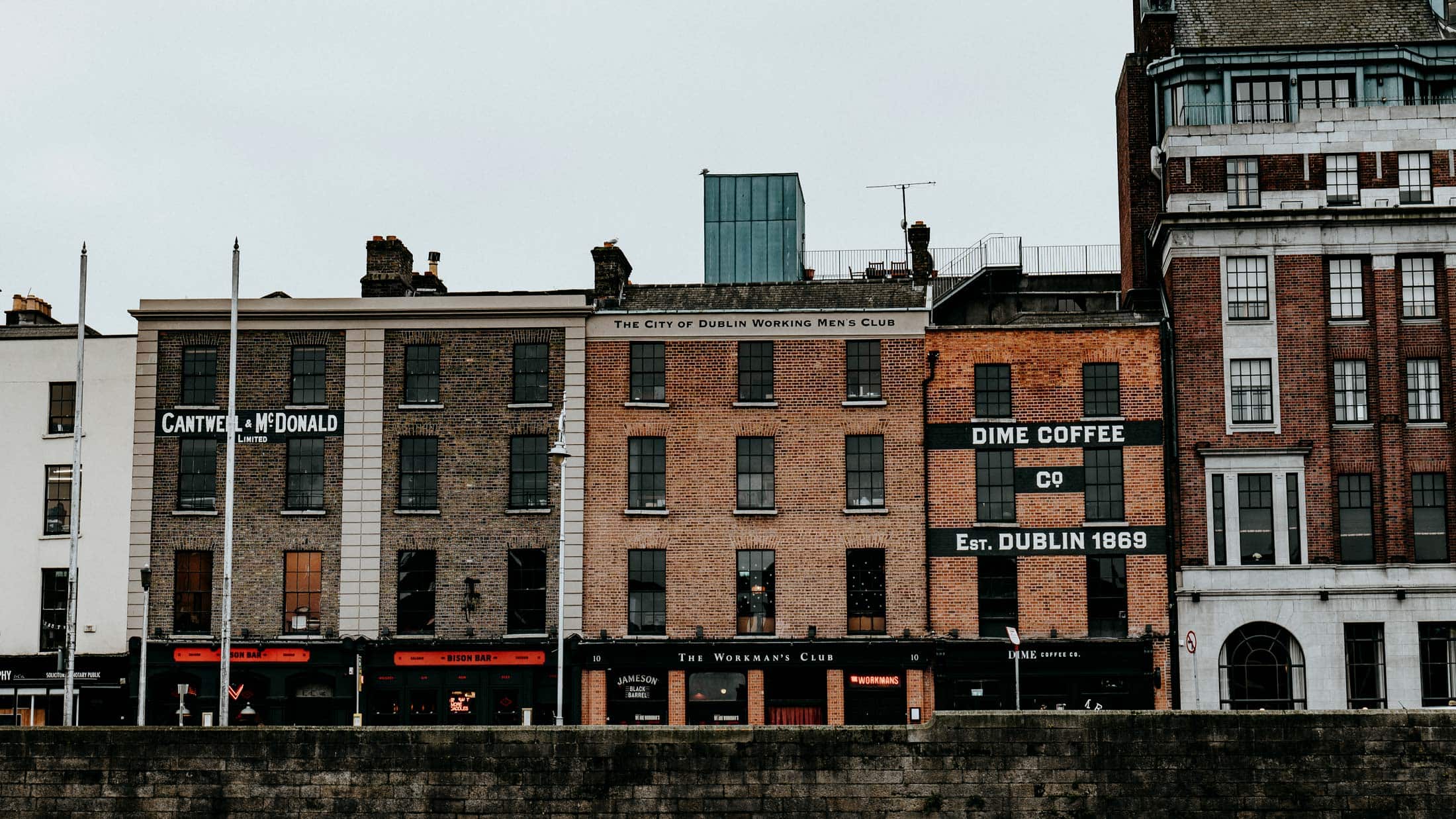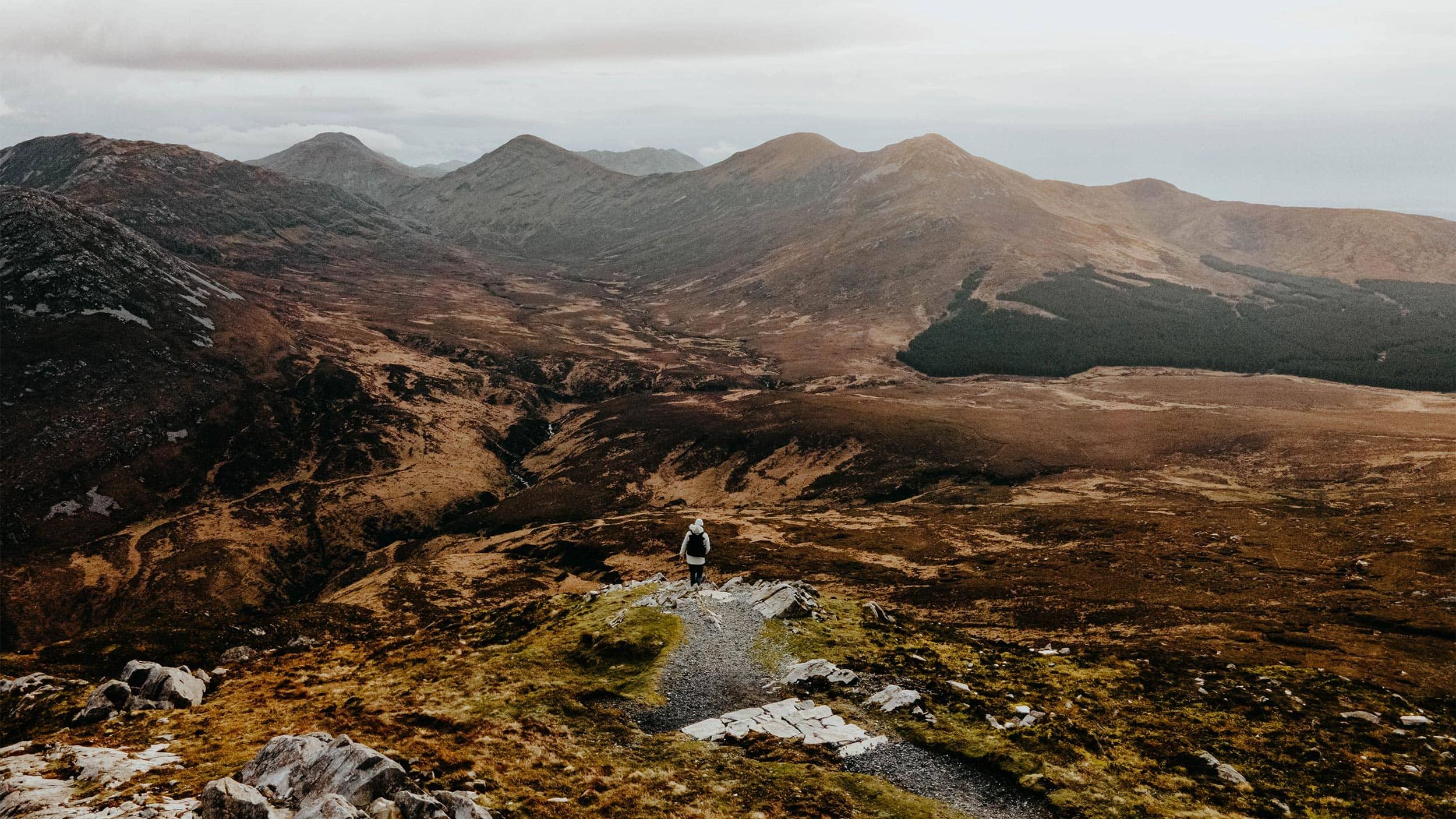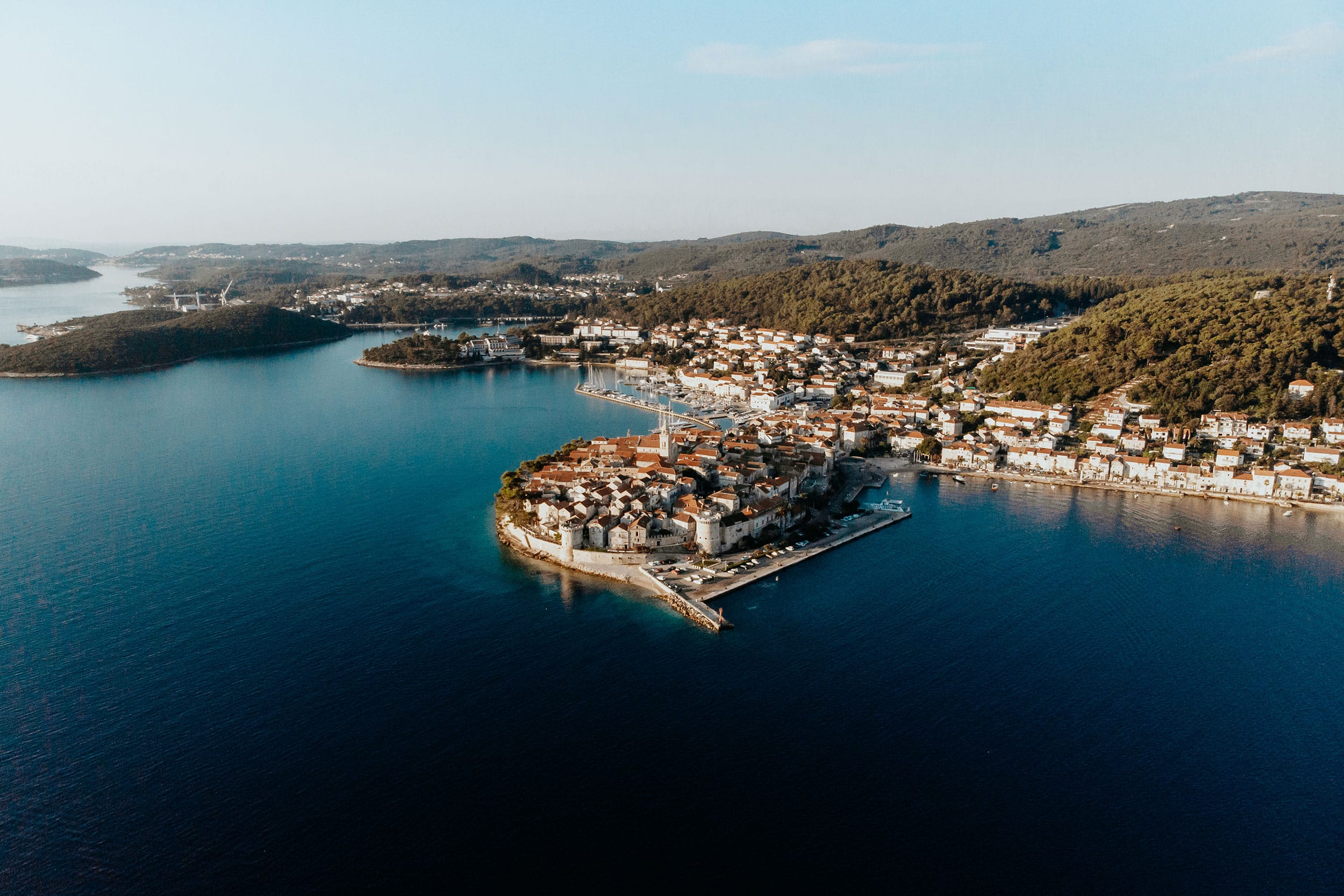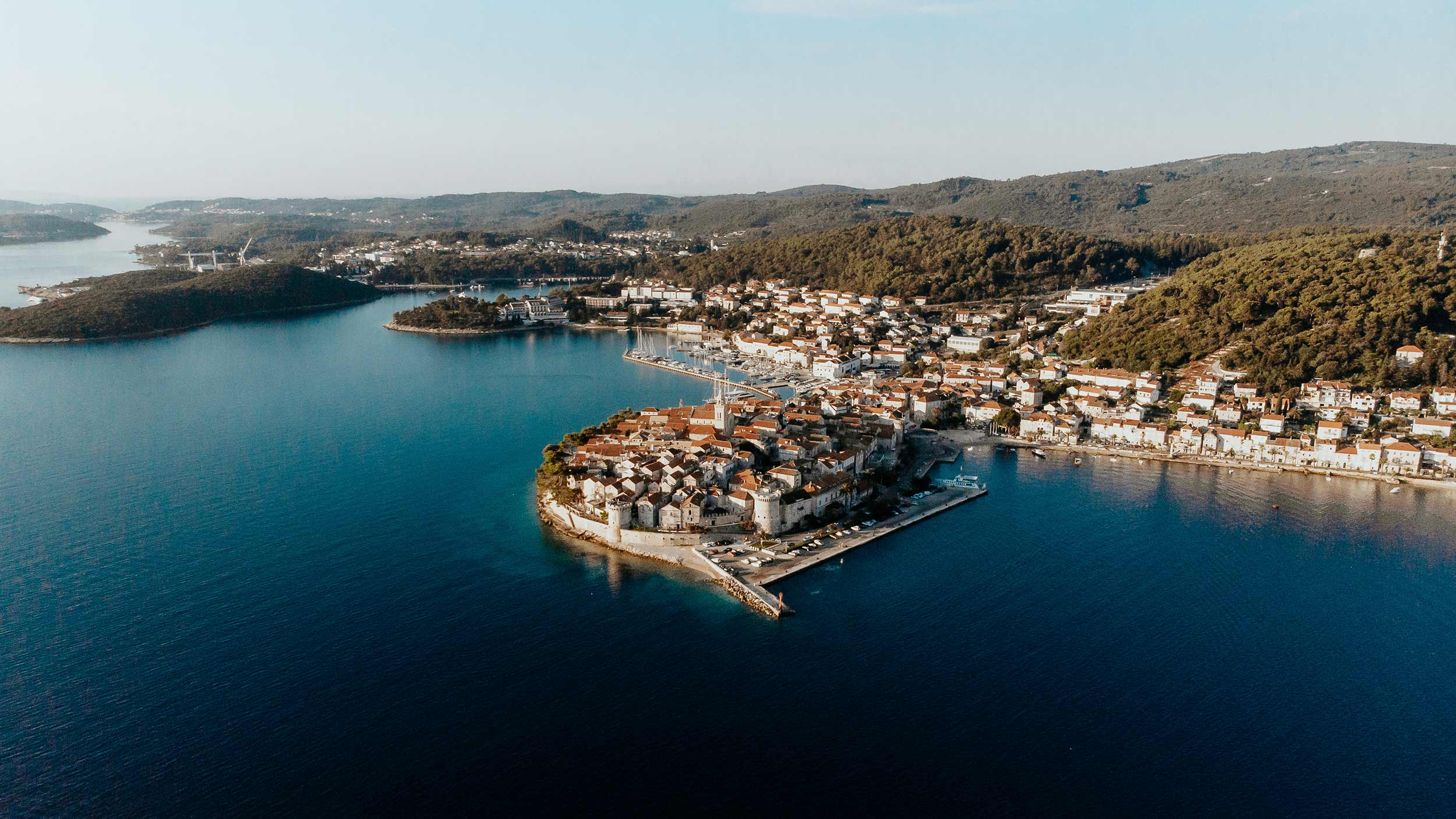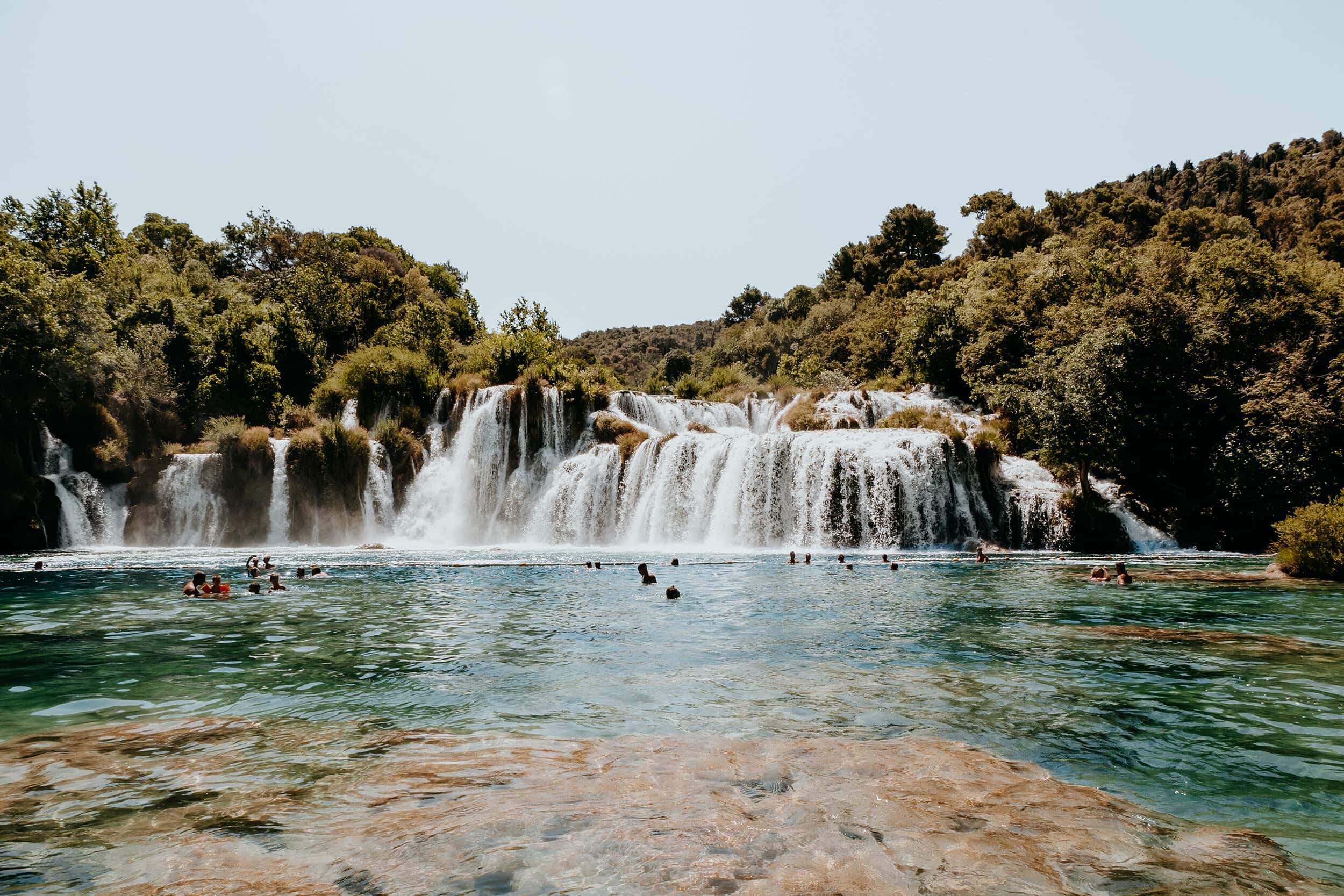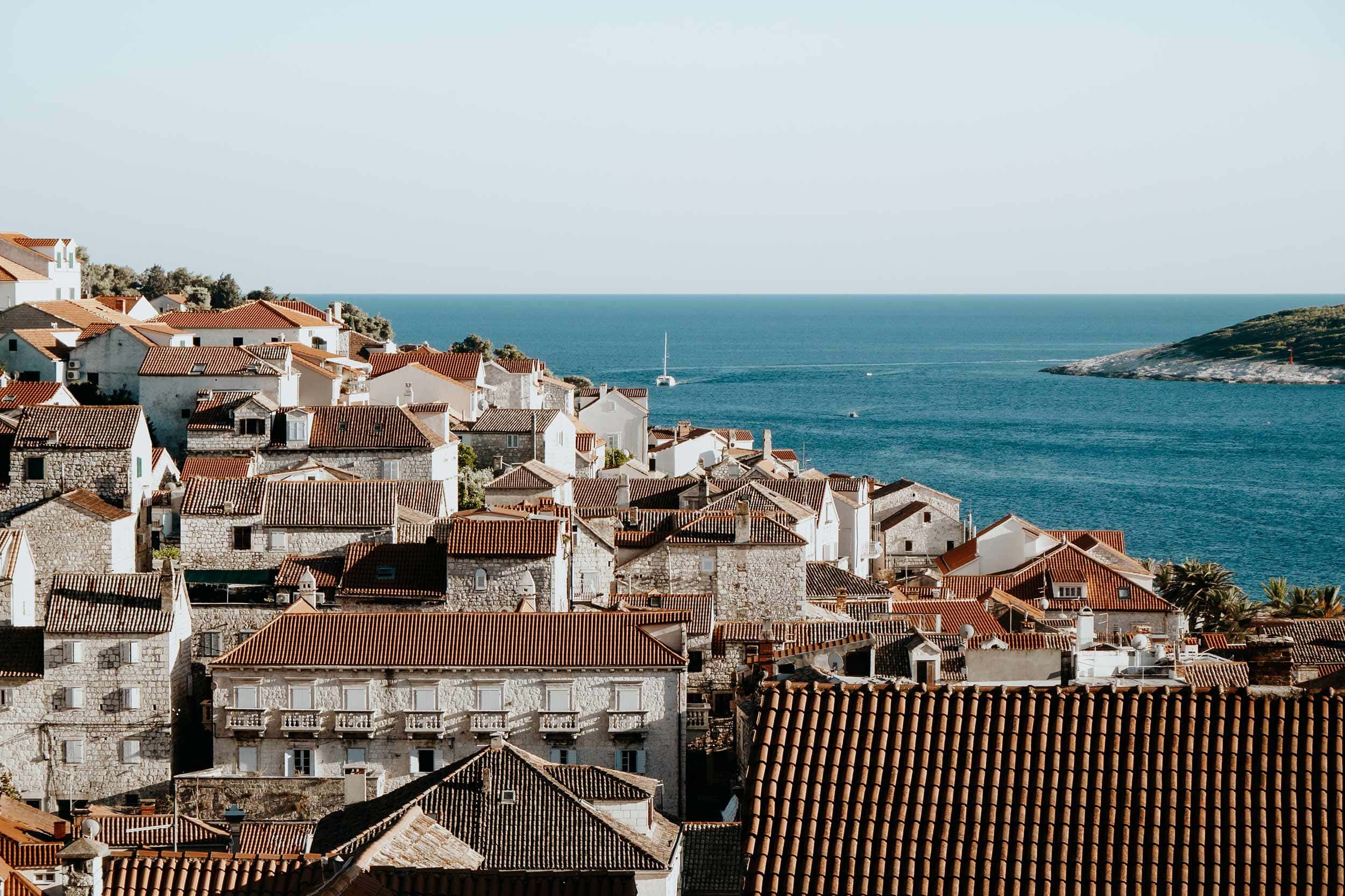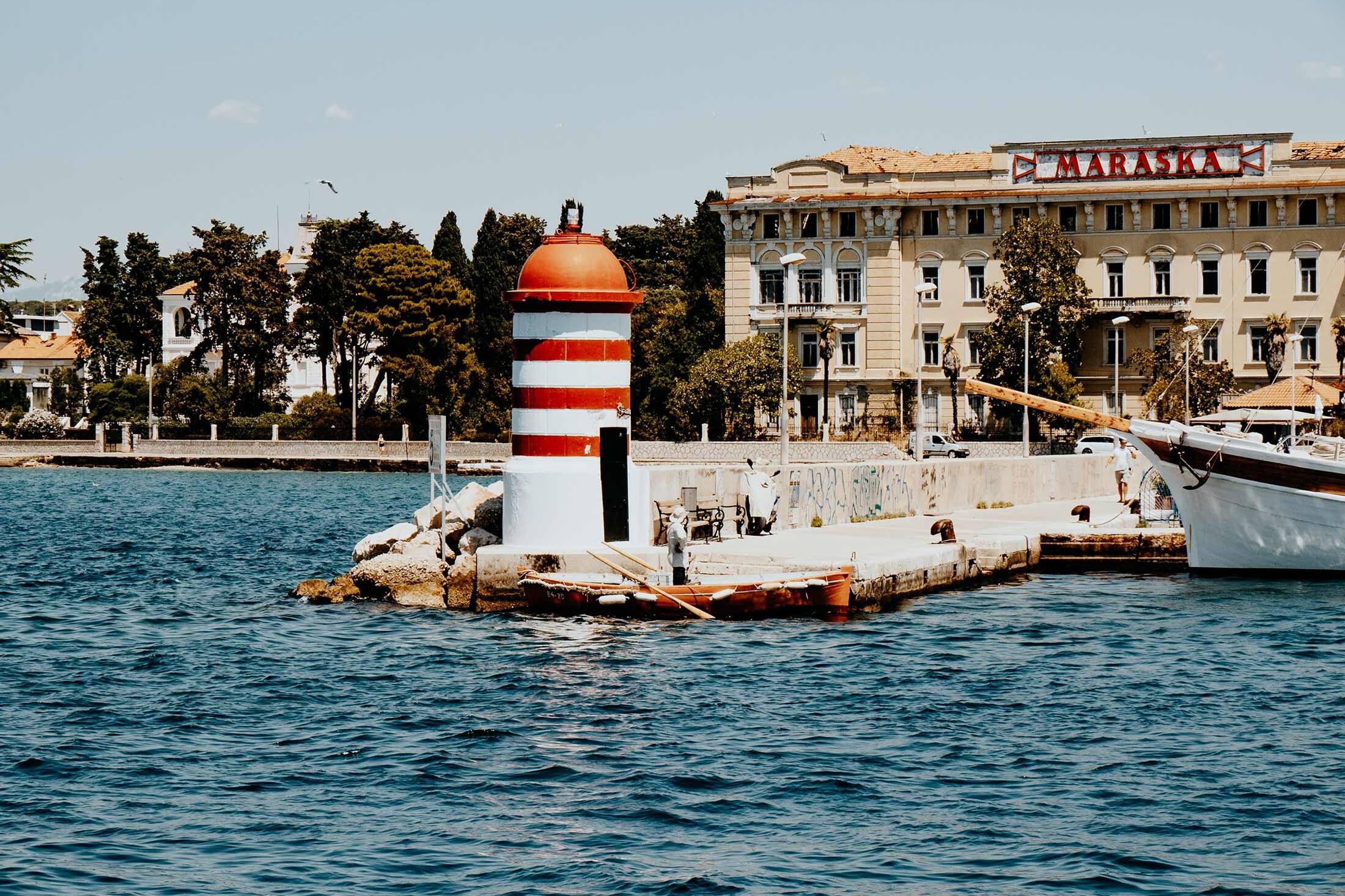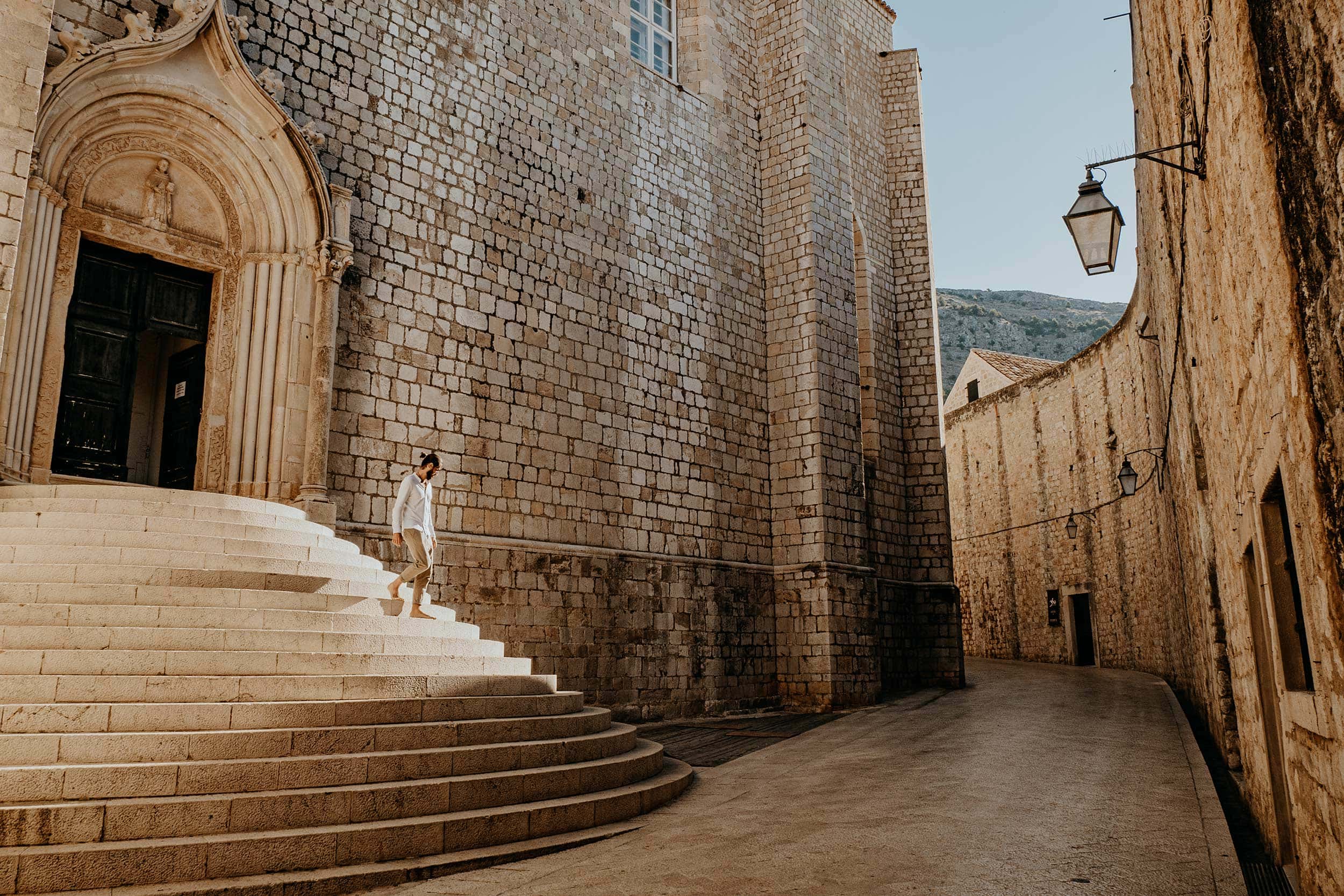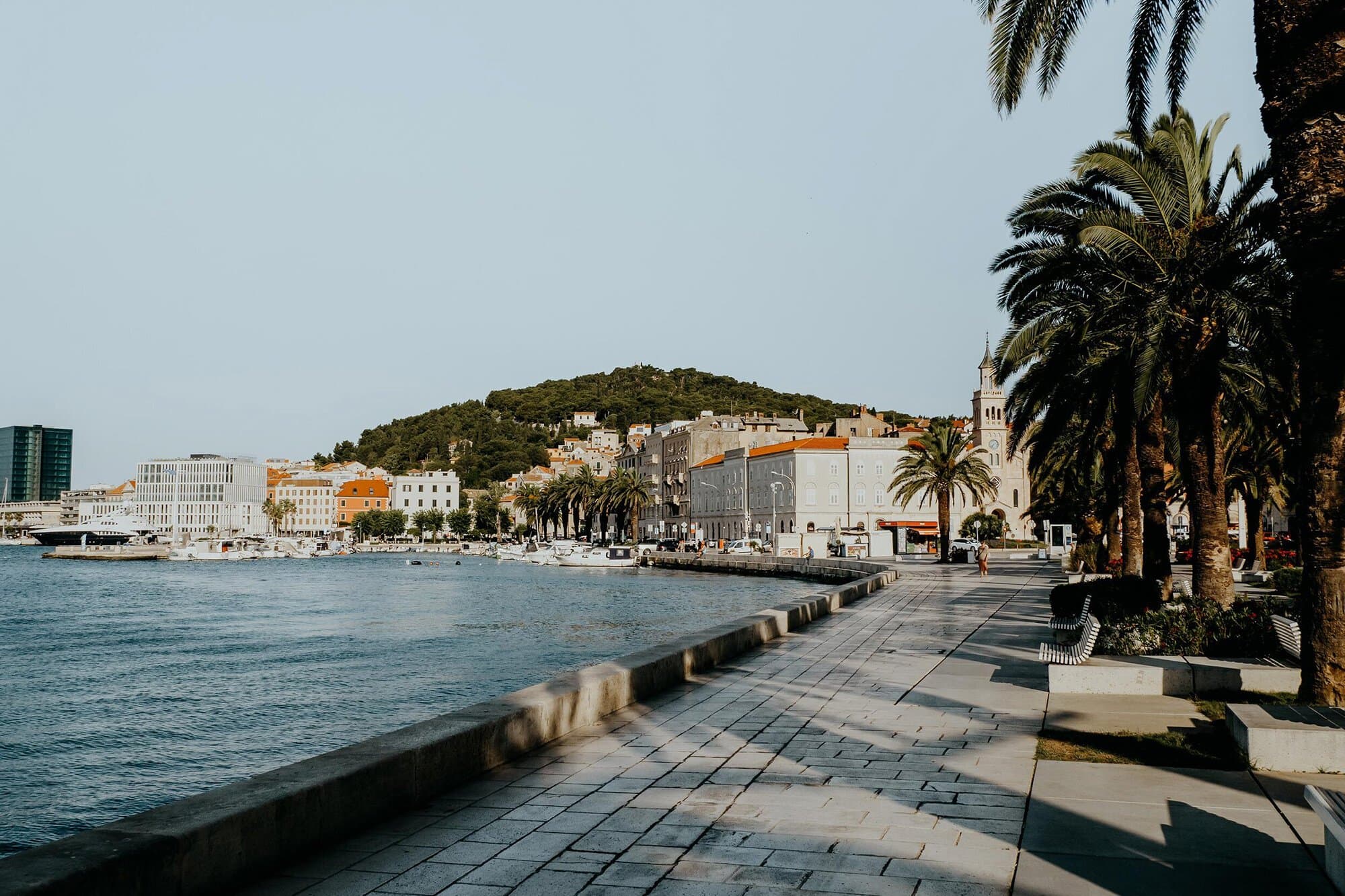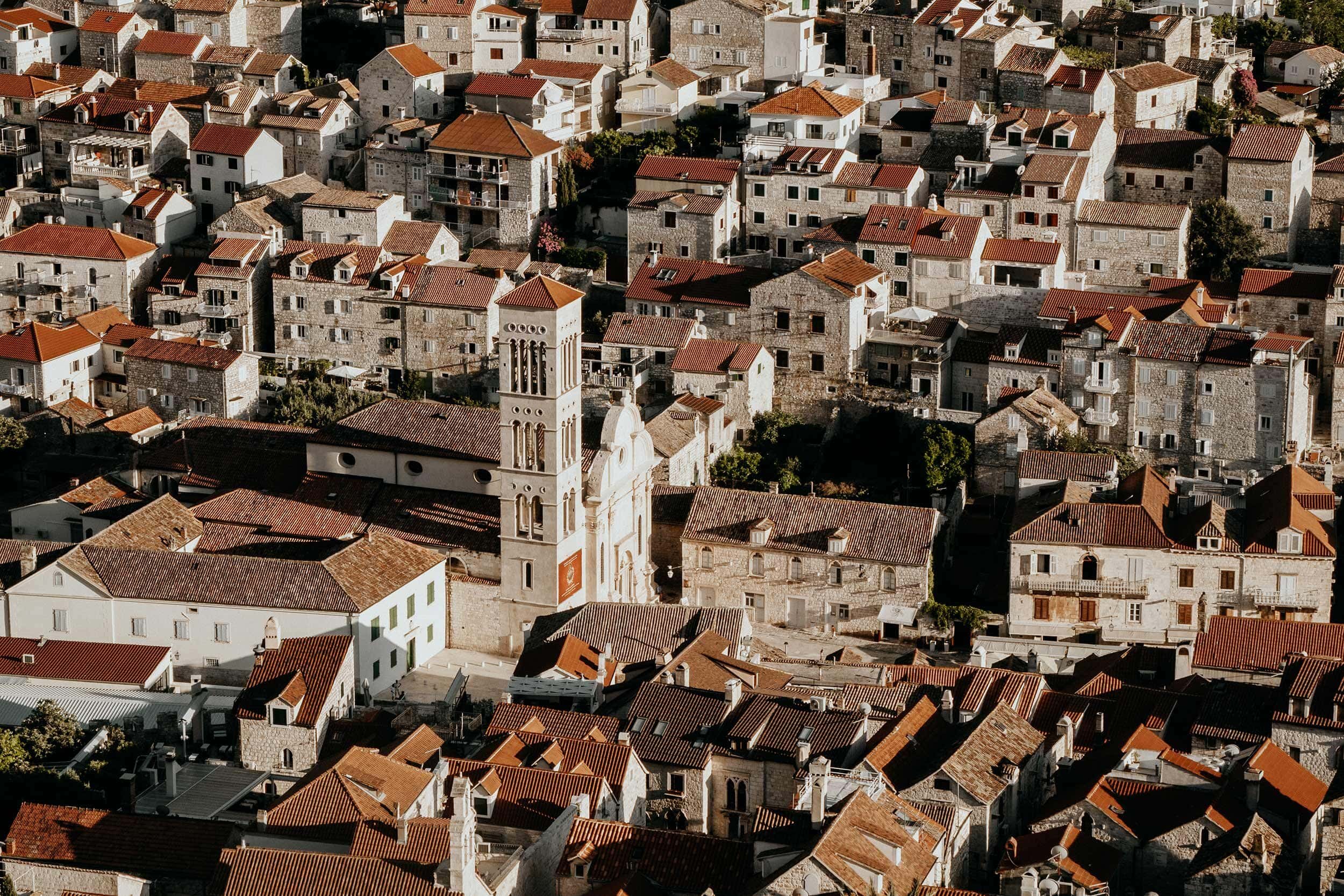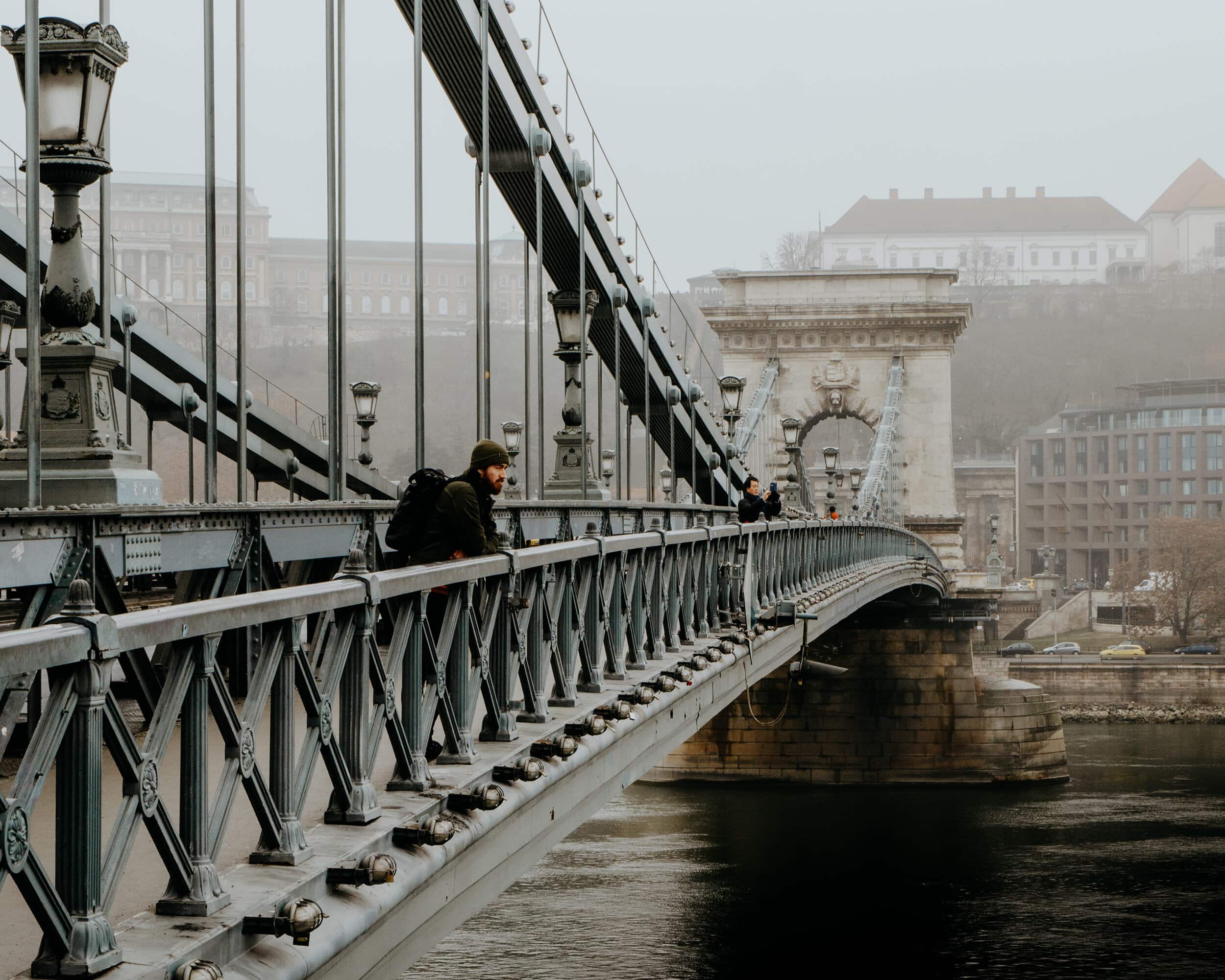What do things cost in Ireland
First things first; travelling in Ireland isn’t by any means cheap.
Whether you’re planning an adventurous road trip or solely a city break to Dublin, I’m pretty sure that this question crossed your mind; What do things cost in Ireland?
So for those planning a trip to Ireland, I wanted to show you a detailed insight in my daily budget and the average cost of the everyday expenses, such as accommodation, transport, food and activities to name a few.
To help you figure out your own travel budget, I’ve put together this short guide with all the essentials information, so you know exactly what to save for an incredible trip to Ireland.
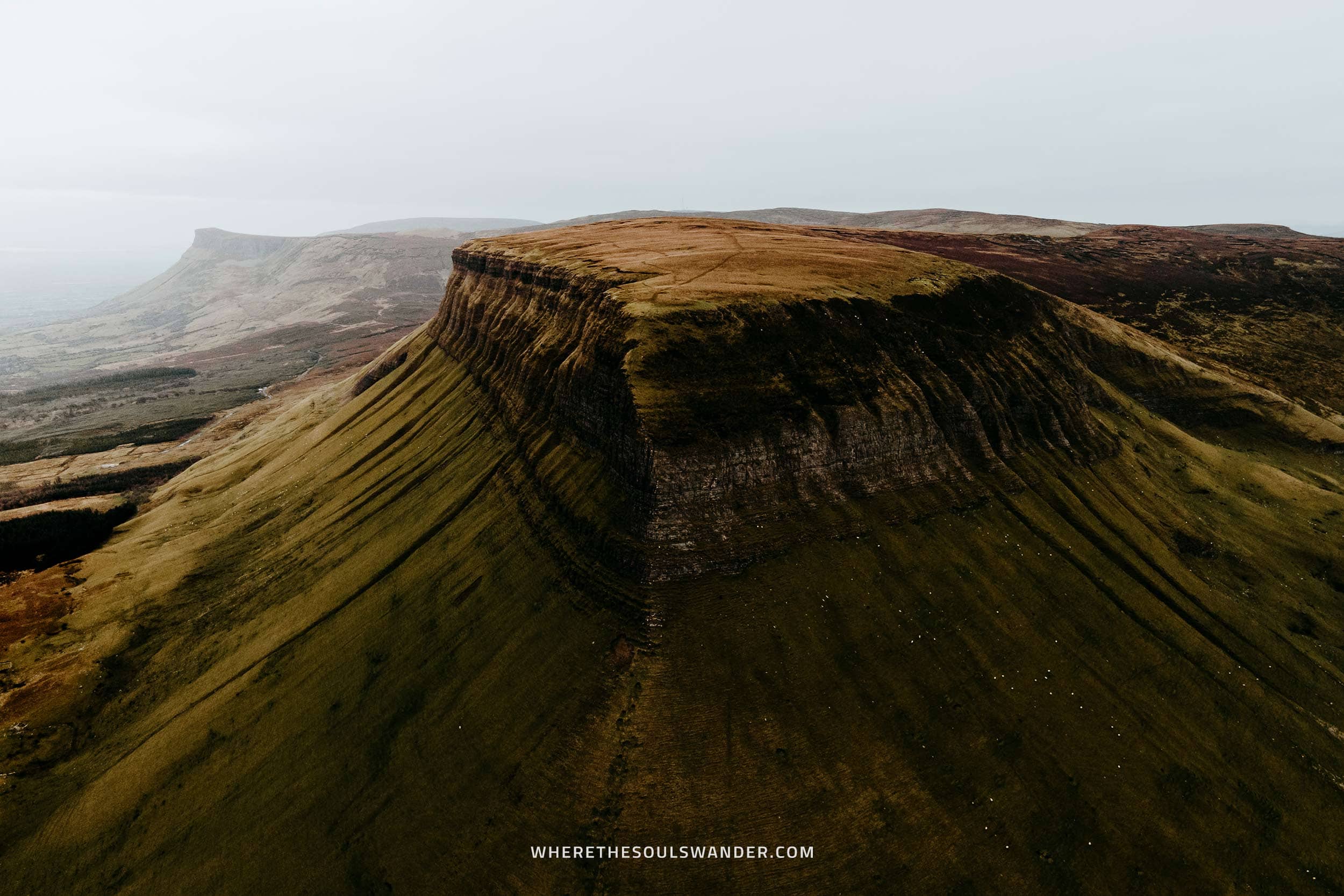
My Ireland daily travel budget
After visiting Ireland recently (Januari 2022), it is safe to say that Ireland isn’t the most appealing country for those travelling on a strict budget.
Of course, it’s possible to find cheap stays and budget-friendly restaurants, but keep in mind that the average cost of basically everything is notably higher than elsewhere in Europe.
The good news is that the largest expenses are limited to accommodation and car rental.
For my 9-day road trip through Ireland, I averaged out at a budget of around €150 per day.
To stick to that budget, I didn’t have to watch every single penny, yet I still chose to search for affordable double rooms, especially in cities such as Dublin, Galway and Sligo.
Also, this budget is based on a solo traveller who rented a car with full insurance coverage (this is by far the biggest expense when travelling in Ireland), stayed in private rooms, and dined out at least twice a day.
On top of that, this budget allowed me to visit everything I planned to visit during my road trip in Ireland, including the Cliffs of Moher, Sleeve League Cliffs, and many of the musea in Dublin too.
Accommodation
An average double room in a hotel | €60 to €90 a night
Having now spent 9 days in Ireland, I noticed that private hotel rooms are rather expensive compared to other countries in Europe.
The good news though, is that there is no shortage of incredible luxurious hotels, with prices averaging out at €60 to €90 a night.
In Dublin however, prices are slightly lower, given there’s significantly more competition.
A dorm bed in a hostel | €25 to €40 a night
Ireland is incredibly popular among backpackers, and accordingly, there’s no shortage of affordable hostels.
While I haven’t stayed in a hostel myself, a dorm bed in a hostel will cost you around €25 to €40 a night in Ireland, which is slightly above the average hostel price elsewhere in Europe.
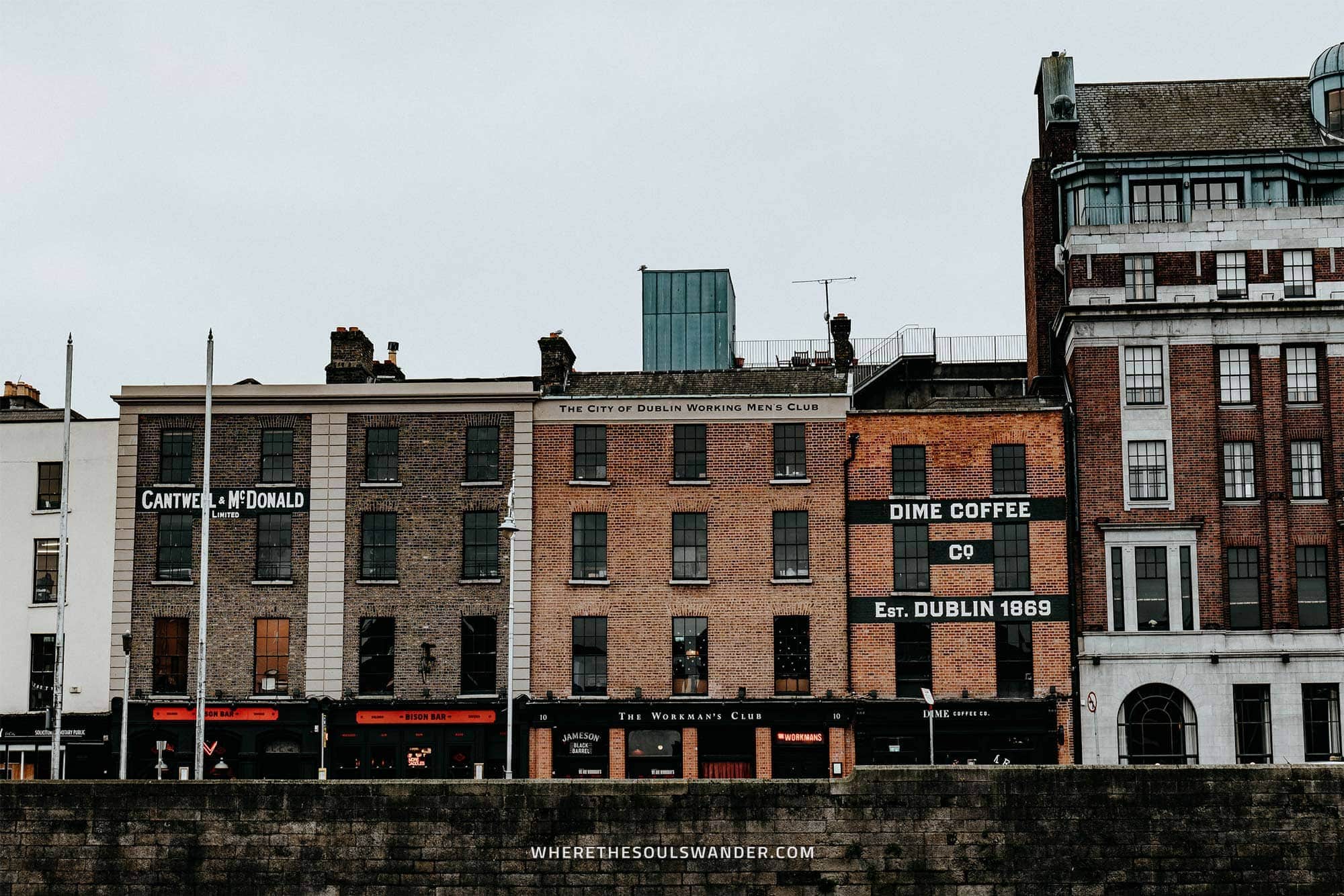
Food
A Meal out | €10 to €25 person
Contrary to other expenses in Ireland, I noticed that dining out was fairly affordable.
I had an excellent burger with fries at Featherblade in Dublin for under €15, and ate one of the best pizzas ever at the Dough Bros in Galway for only €10 – so make sure you check them out both.
Whilst prices still vary significantly from place to place, you can have an excellent meal out for anywhere from €10 to €25 per person.
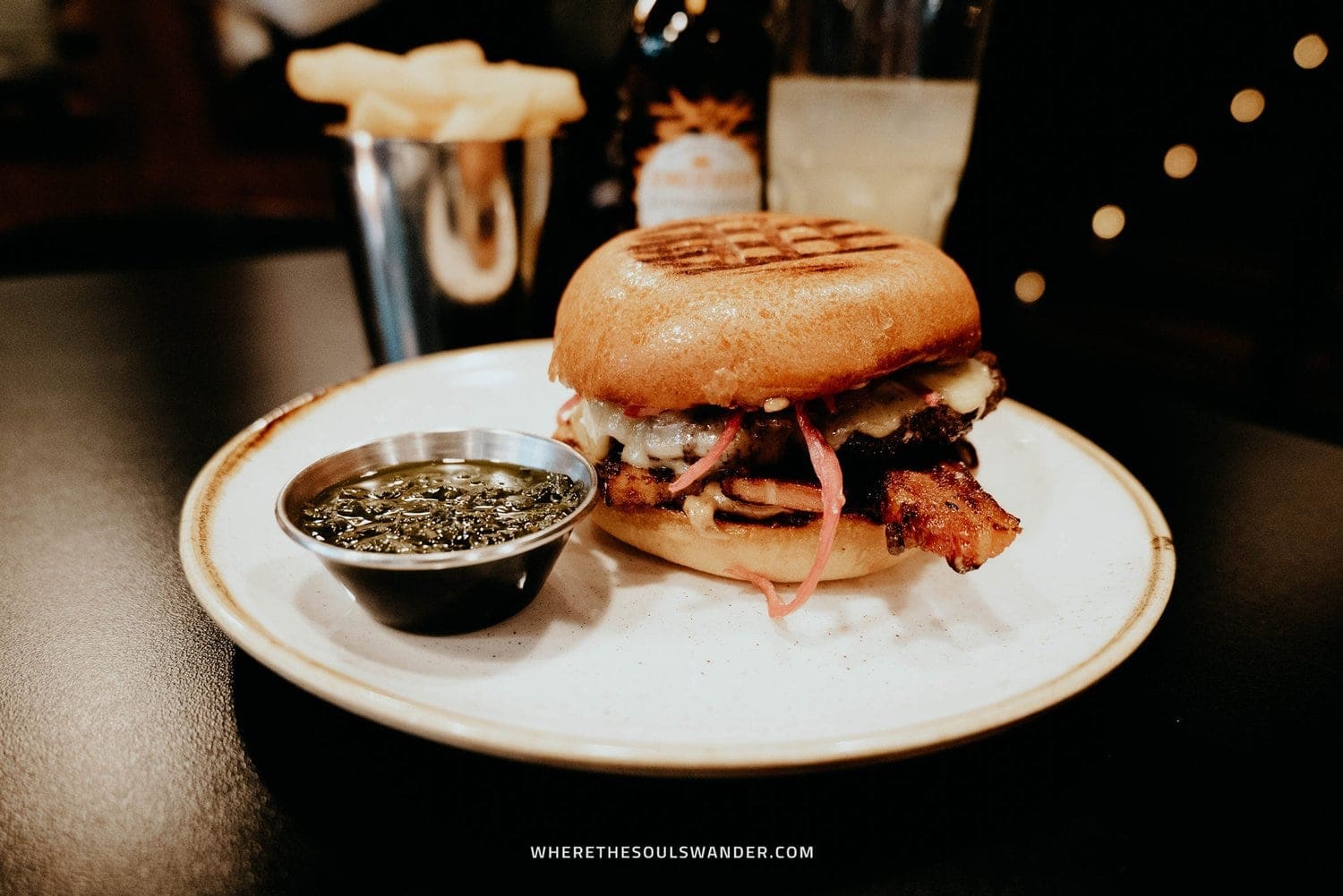
A good cup of coffee | €2,5 to €4,5
During my road trip in Ireland, I have savoured quite a few cups of brilliant coffee, especially at Brother Hubbard in Dublin, and Coffeewerk + Press in Galway.
Depending on how you prefer your coffee (there are plenty of non-dairy options available), you should take into account that a cup of rocket fuel will cost you anywhere from €2,5 to €4,5 each.
A pint of beer | €5
If there’s one thing Ireland is known for, it will be its lively pub scene and the alcoholic beverages that are served here – for that reason, you should definitely stop by at a traditional Irish pub.
Most pubs will serve large pints at a cost of roughly €5 apiece. However, if you’re in Dublin and decide to go to Temple Bar, prepare to pay significantly higher prices.
Also, it’s good to note, that since 2013, the happy hour specials in terms of alcoholic beverages were forbidden by the Irish government.
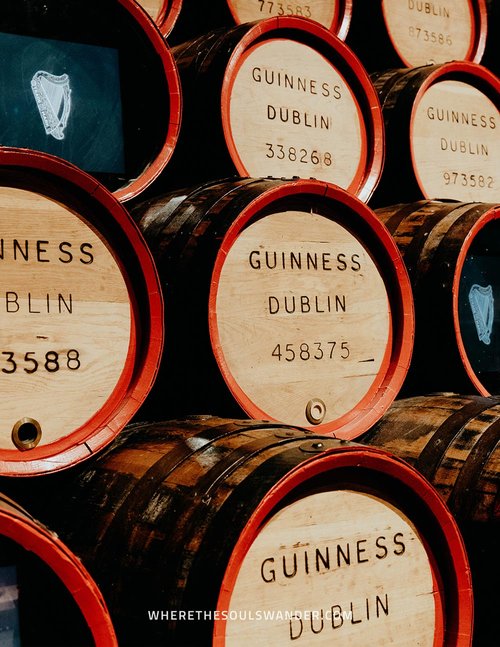

Entrance fee to a museum or national park | Around €15 per activity
Ireland had plenty of awesome things to see and do, and luckily for us, the average prices for a museum or national park are relatively low or free of charge, with an average price of €15 per activity.
Some examples include;
€10 | Cliffs of Moher
€22 | Guinness Storehouse
Free | Benbulben Forest Walk
€18 | The Book of Kells and Trinity College Dublin
Free | Slieve League Cliffs
Free | Connemara National Park
€25 | Jameson Distillery
Free | Fanad Lighthouse
Free | Downpatrick Head
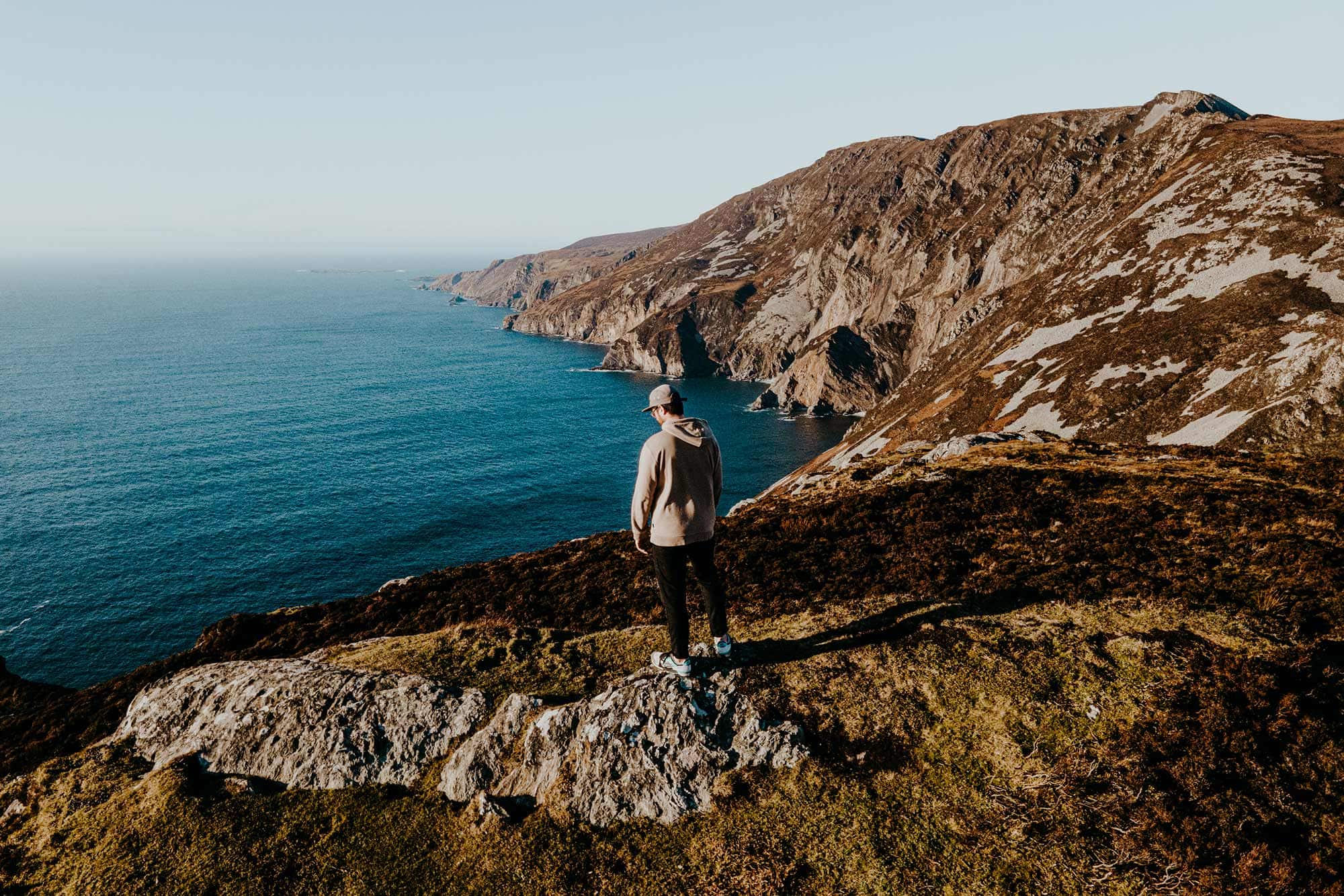
Car rental | €60 to €90 per day
All in all, a road trip in Ireland is far from cheap, and with the above in mind, I’d advise booking your rental car well in advance to save a significant amount of money.
Whilst car rental is clearly the largest expense when travelling in Ireland, I noticed that it is still the most affordable, convenient, and fastest manner of transport here.
The price for car rental in Ireland ranges from €60 to €90 per day – this includes free cancellation, theft protection and collision damage waiver.
For car rental in Ireland, I’d highly recommend Rentalcars.com. They offer brilliant service, additional insurance options, as well as a wide selection of cars to choose from. Prices and availability here.
Continue reading | A guide to driving in Ireland: 11 tips to kick-start your road trip
Fuel | €1,84 per litre
As with car rental, the fuel in Ireland isn’t cheap either.
At the moment of writing (April 2022), the fuel price in Ireland is slightly below average in Europe, with gasoline at €1,84 per litre and diesel at €1,94 per litre.
If you follow my Ireland road trip, which involves a lot of driving, taking you to plenty of the country’s absolute highlights, you will use around €150 to €200 worth of fuel.
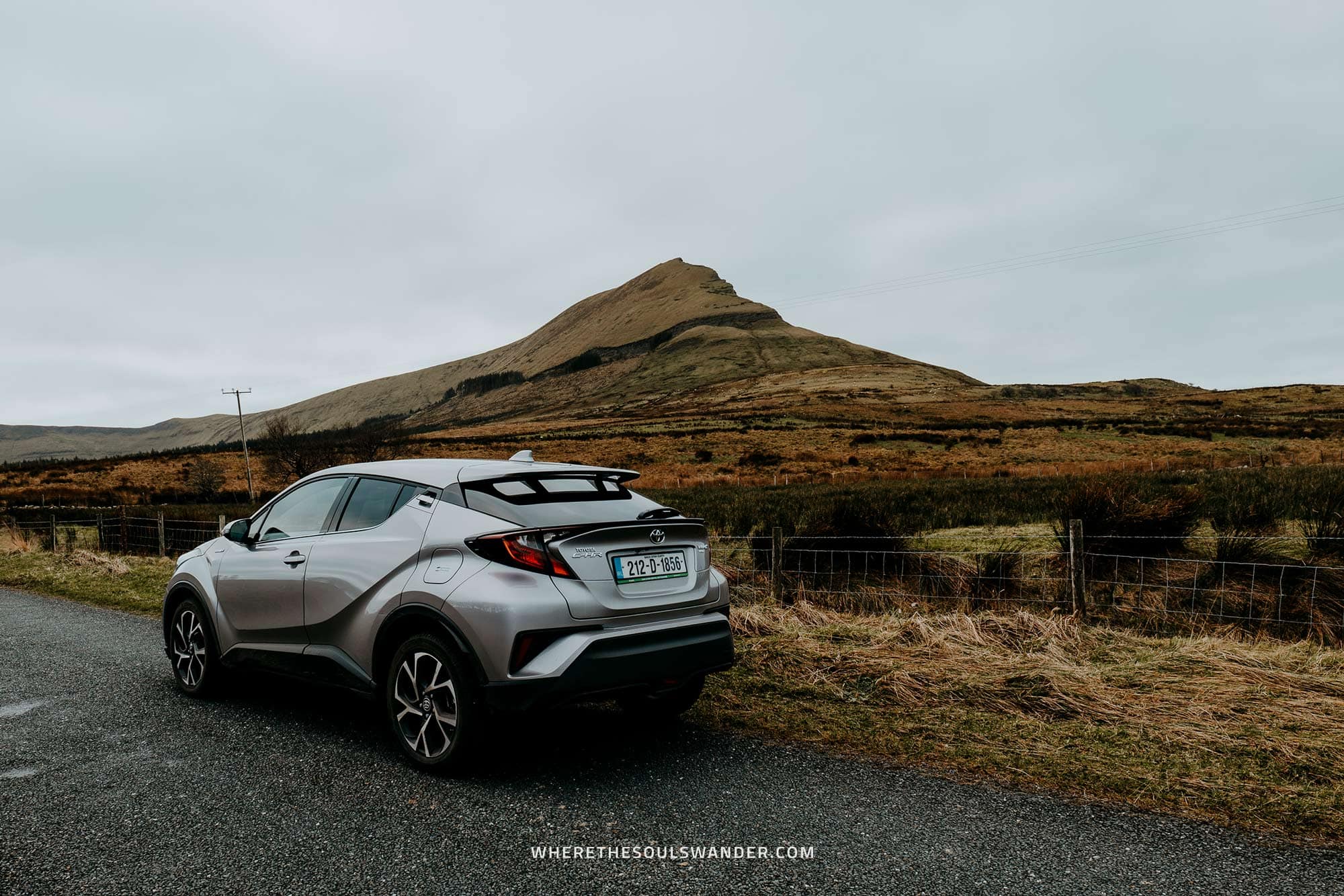
Toll charges | +/- €2,50
Another expense that you will most likely overlook when planning a trip to Ireland, are the toll charges that you’re required to pay on certain roads.
Depending on your route, you will cross several toll roads, with different rates, depending on your vehicle. For more information about the rates, check the official EToll website here.
Parking | €35 to €40 per day
If you somehow choose to rent a car before visiting Dublin, note that the cost of parking in the city centre will add up relatively quickly.
I had my rental car parked in one of the many parking lots for the night and paid around €25, which if you ask me now, is a waste of money.
On average, the parking in Dublin will cost around €35 to €40 per day.
If you’re keen to see my best tips on driving in Ireland, make sure you read my detailed guide here.
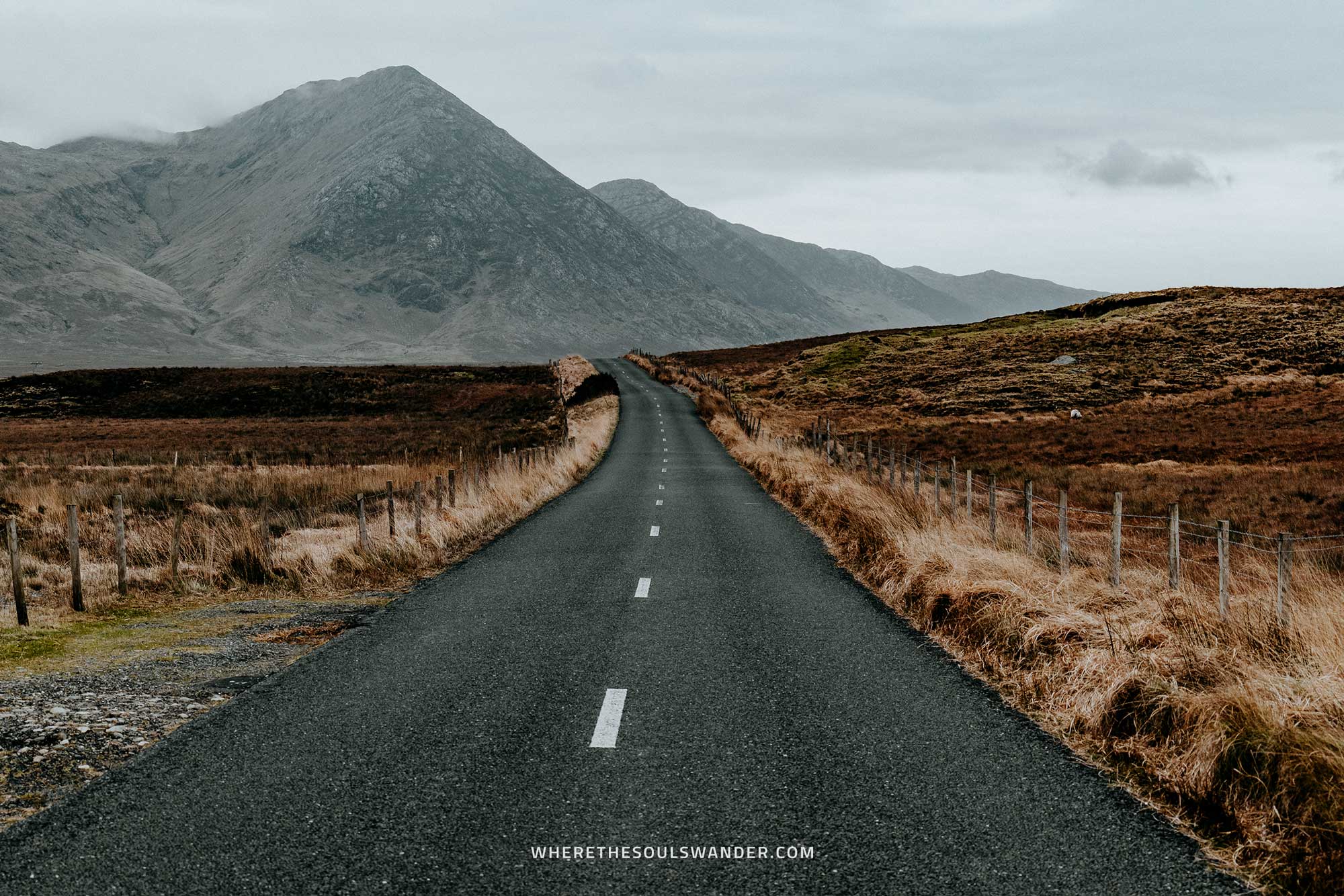
Bus from the airport to Dublin | €10
Whether you’re going solely on a city trip to Dublin or planning out an in-depth itinerary, I highly advise starting your Ireland journey in Dublin either way.
The best way to get there is by jumping aboard the Dublin express, which will take you to the city centre in under half an hour – a return ticket will cost you only €10.
After you’re done in Dublin, head back to the airport where you will either catch your flight back home or pick up your rental car.
PLAN YOUR IRELAND ITINERARY WITH THESE ESSENTIAL READS
A guide to driving in Ireland: 11 useful tips to kick-start your road trip
With driving on the left-hand side, narrow country roads, and 5.5 million sheep to dodge, driving in Ireland can be quite an adventure.
At the same time, this adventure is extremely convenient, stunningly picturesque, and by far the best way to experience this exceptional country and the spectacular scenery it has to offer.
After driving to some of Ireland’s absolute highlights and some of the hidden gems too, I’ve come to the conclusion that there are only a few places more suitable for an adventurous road trip than Ireland.
It’s rugged, a tad unpredictable, and most of all, exceptionally beautiful, making it a dream destination for those who crave off-the-beaten-path adventure and untouched wilderness.
Add to that that the roads are easy to navigate and in excellent condition, and Ireland is the road trip destination you’ve been searching for all along.
To kick-start your own road trip, I’ve curated a list of useful tips for driving in Ireland – plus all the essentials in terms of car rental, costs, insurance and more.
Why rent a car in Ireland?
Ireland is an incredibly picturesque country and exploring it as part of a road trip is easily the best way to see everything it has to offer.
By renting your own car, you also have the possibility to cruise to some of the most secluded areas of the country, which to me, is an absolute must for anyone road-tripping Ireland.
Add to that, that you have all the freedom to explore at your own pace, and that public transport is slightly limited in some bits of the country, and it’s easy to understand why a road trip is the best way to experience this amazing island in the North Atlantic Ocean.
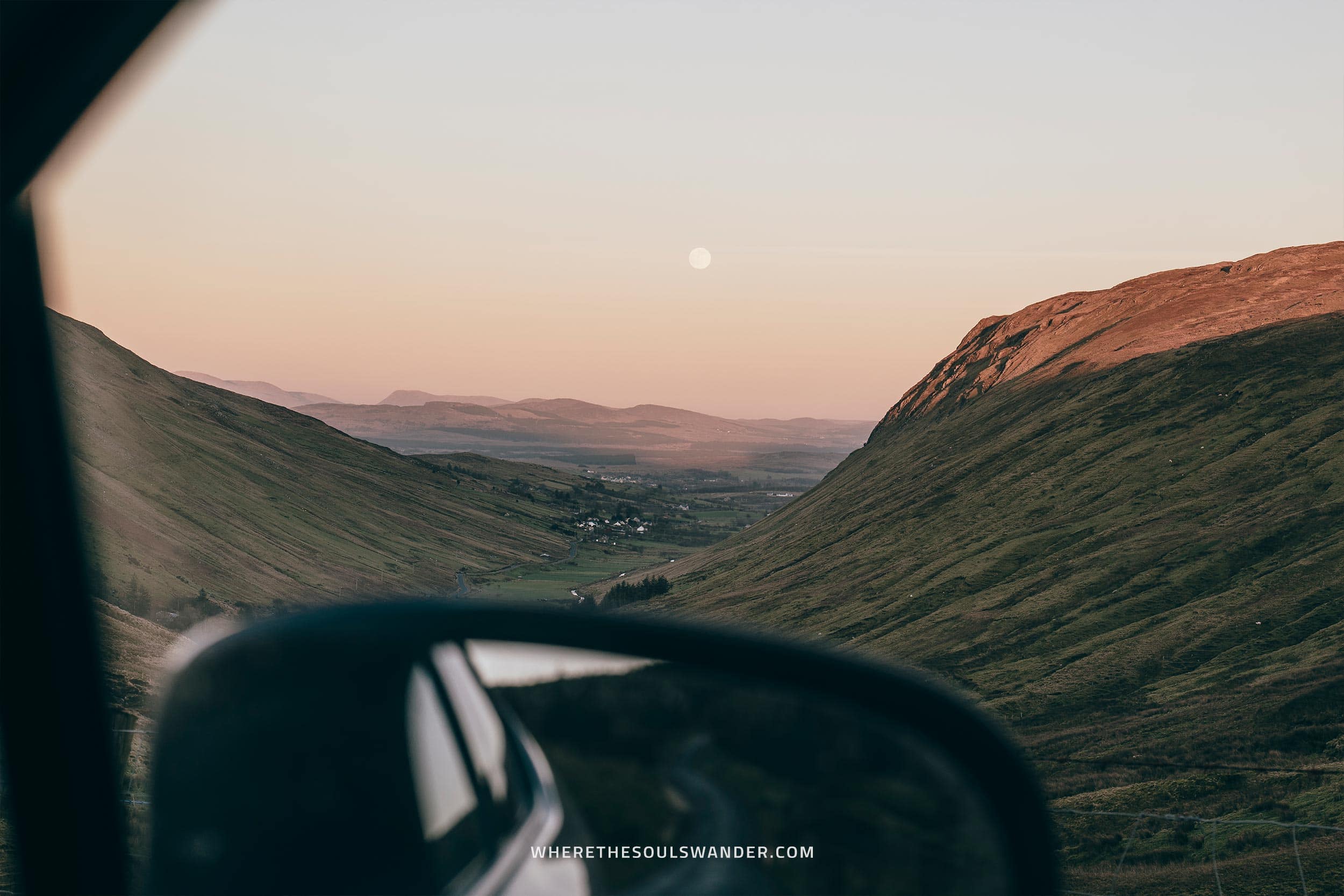
Cost of renting a car in Ireland
First things first; renting a car in Ireland isn’t by any means cheap.
I’ve rented cars in many different countries over the last few years, and the costs of renting a car in Ireland were some of the highest I’ve ever seen – which kinda shocked me at first.
However, after doing some proper research, I noticed that renting a car is still the cheapest, fastest and most convenient means of transport in Ireland.
Having said that, the price for car rental ranges from €400 to €600 per week in the high season, which comes to approximately €60 – €90 per day. This includes free cancellation, theft protection and collision damage waiver.
If you choose to opt for a car with automatic transmission (which I highly recommend if you haven’t driven on the left before), the costs of car rental will average out at €600 to €800 per week.
All in all, a road trip in Ireland is far from cheap, and with the above in mind, I’d advise booking your rental car well in advance to save a few bucks.
For car rental in Ireland, I’d highly recommend Rentalcars.com. They offer brilliant service, additional insurance options, as well as a wide selection of cars to choose from. Prices and availability here.
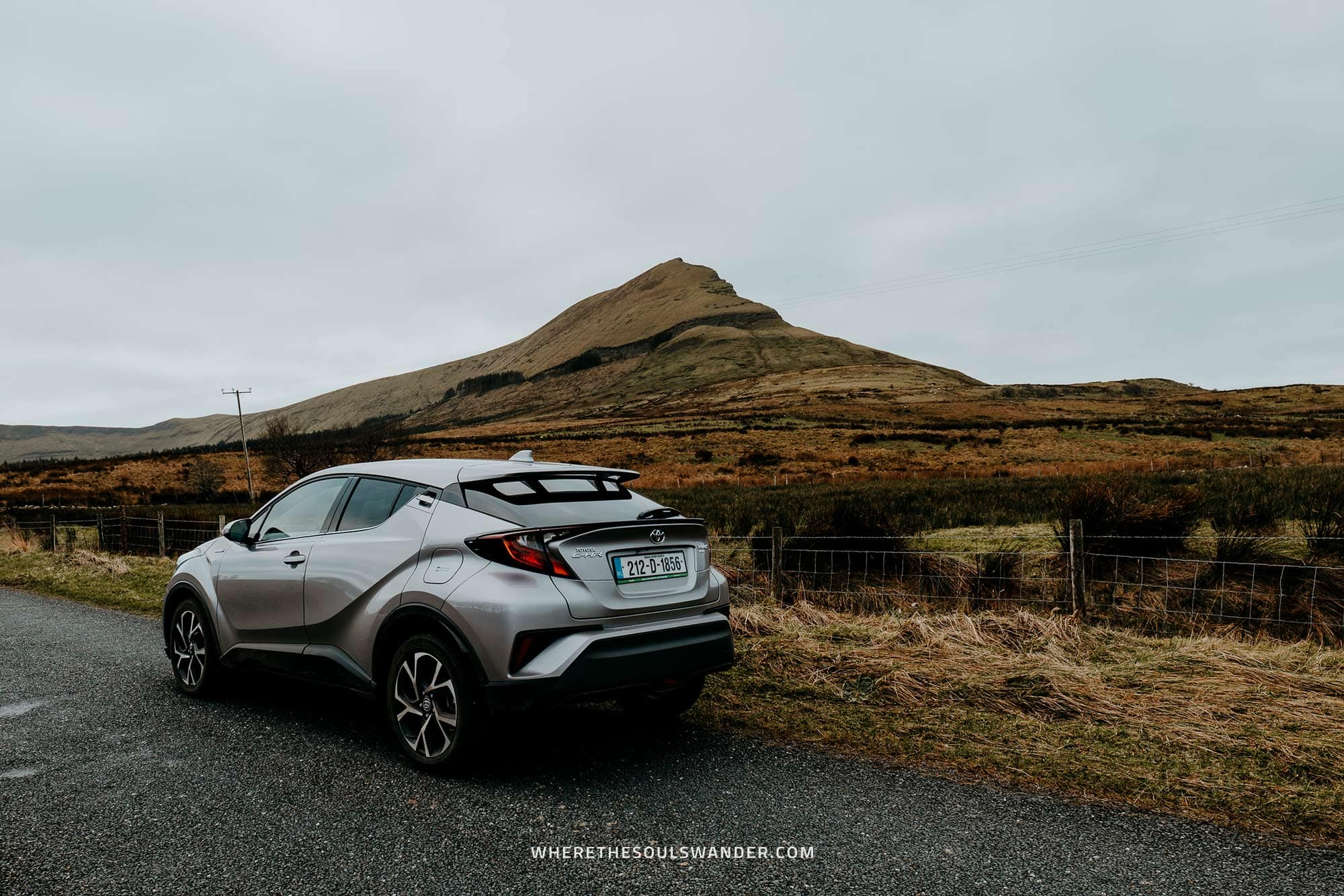
11 Useful tips to kick-start your Ireland road trip
1 | Drive on the left-hand side of the road
To me, the idea of driving on the left-hand side of the road sounded kinda frightening at first, but after a short phase of acclimatisation, it actually felt quite logical.
But it isn’t like this for everyone, so I’d highly recommend anyone to take it slow since it takes at least a couple of days to become fully accustomed to your new driving situation.
If it’s your first time driving on the left, make sure you do some test drives at the parking lot of your rental car supplier, as it will give you some time to get a feel for the car, while you also practice your new driving habits.
If you’re not completely comfortable with driving on the left, hiring an automatic car will make things a lot less complicated, as you don’t have to stress about changing the gears all the time.
Those preferring to drive automatic, be sure to book a car in advance since renting an automatic car is wildly popular within Ireland.
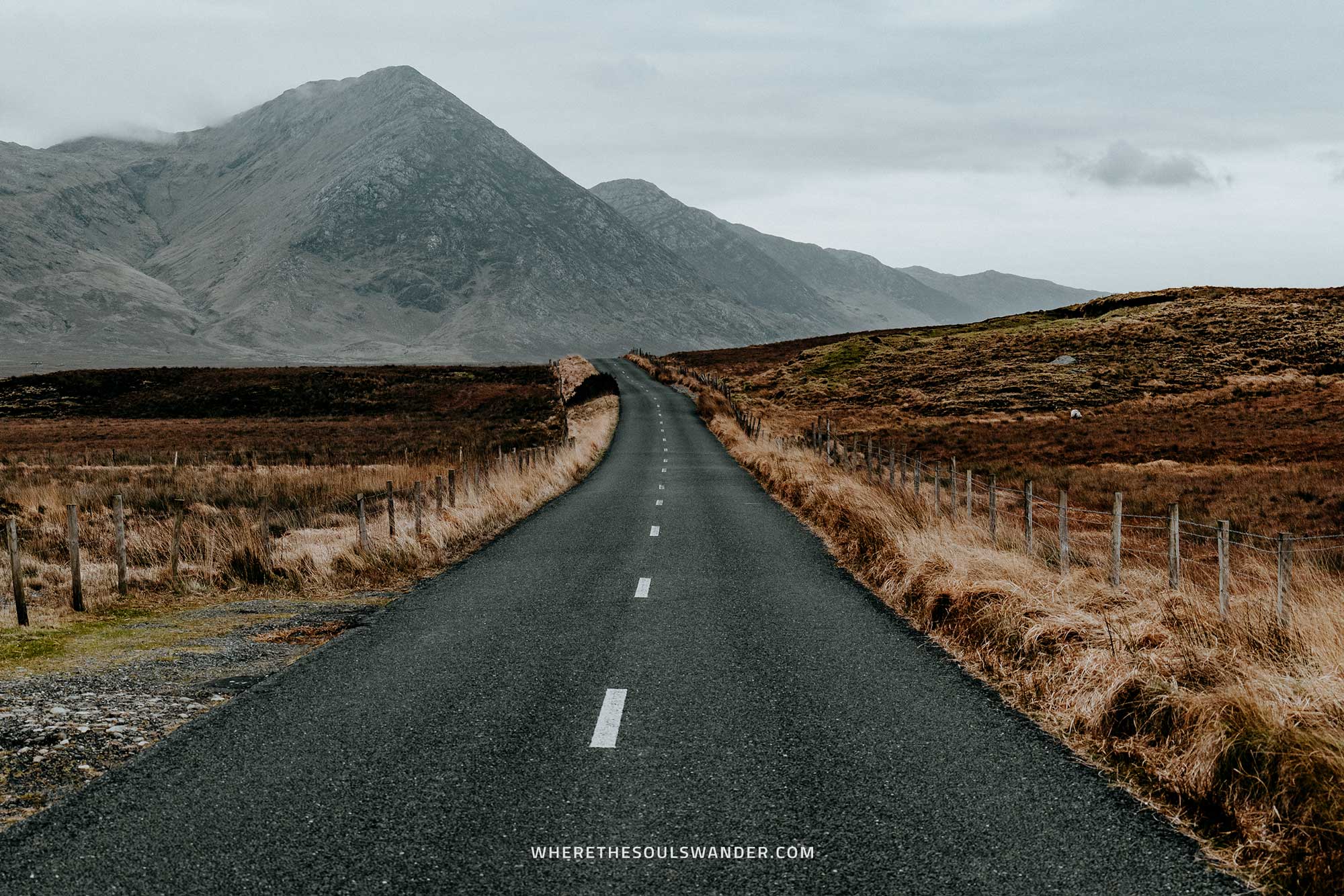
2 | Rent and drop off your car at Dublin Airport
Since there’s plenty of rental car companies established in Dublin Airport, there’s also significantly more competition, meaning you could find a rental at notably cheaper rates here.
However, it’s essential that you reserve your rental car online and in advance, and pick it up as soon as your flight touches down on Irish soil.
For the above reasons, I’d advise anyone to sort out their own rental car as soon as their flight confirmation pops up in their mail inbox – given that last-minute rates can be quite a shock, especially during the peak summer months.
When it comes to international car rental, I always make use of RentalCars; an excellent online car rental service that holds over 900 of the world’s leading rental car suppliers.
Additionally, if you do however wish to book a rental car spontaneously, make sure you check at the reception of your hotel, as it’s likely that they can offer your a small discount.
3 | Try to avoid parking your car in Dublin
If there’s one thing I’ve learned during my time in Ireland, it will be that you should try to avoid parking your car in Dublin at all times.
While some of the best day trips from Dublin are reached by car, I’d highly recommend bringing back your car to the rental car company before exploring the city itself.
Simply put, the parking fees in Dublin can add up quickly, especially if you park around museums or in one of the parking garages in the city centre.
I had my rental car in the garage for one night and paid around €25, which is a complete waste of money in my eyes.
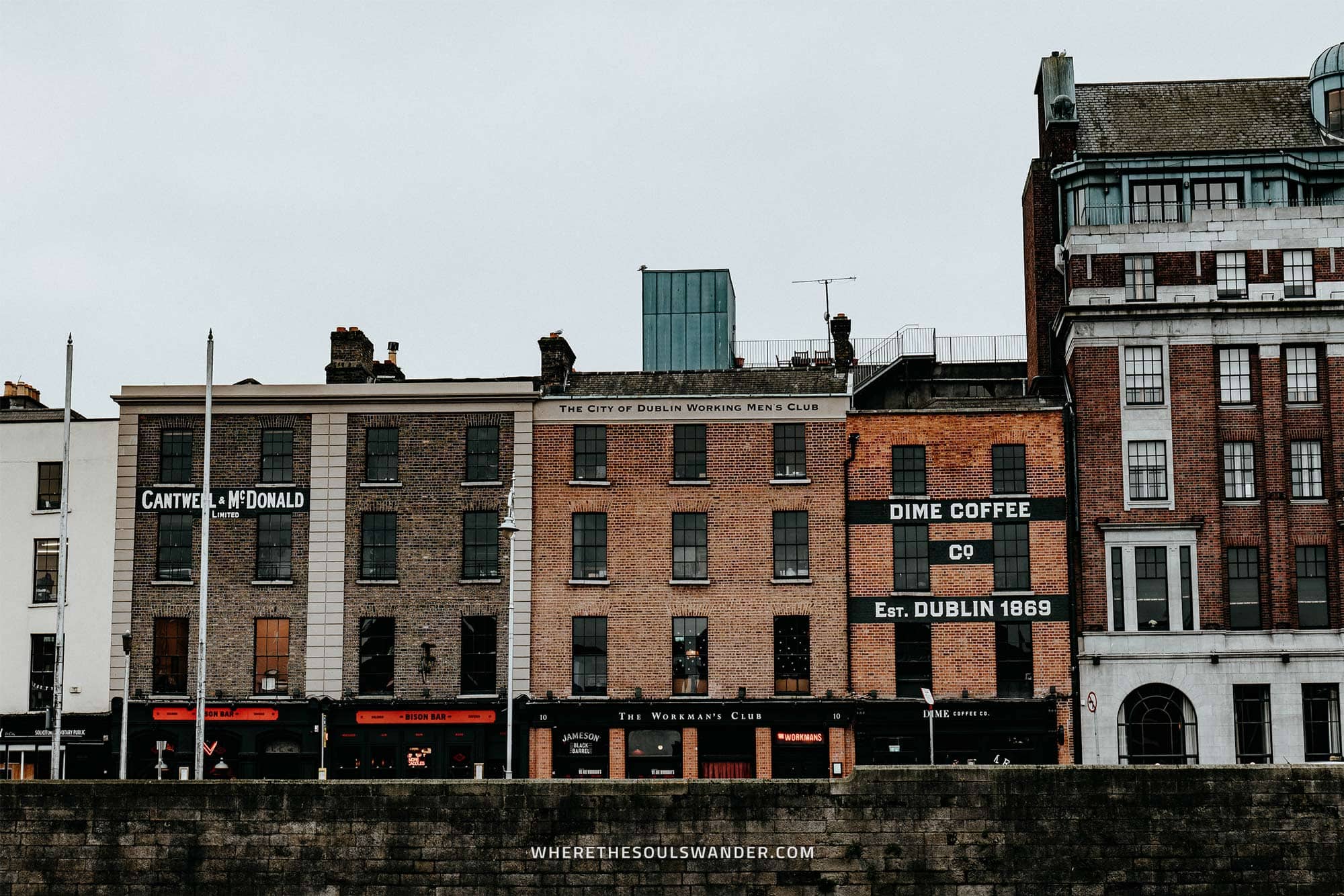
4 | Mind the sheep
As you’ve likely seen on the cover of my Ireland itinerary, Ireland is teeming with sheep, and they often don’t give a damn about the traffic.
Instead, these sheep tend to wander on the side of the road, so make sure you keep an eye out when passing a herd – they have a tendency to cross the road without warning.
Lastly, with over 5.5 million sheep, Ireland is home to more sheep than humans, meaning there’s simply no way around this fact when driving through the Irish countryside yourself.
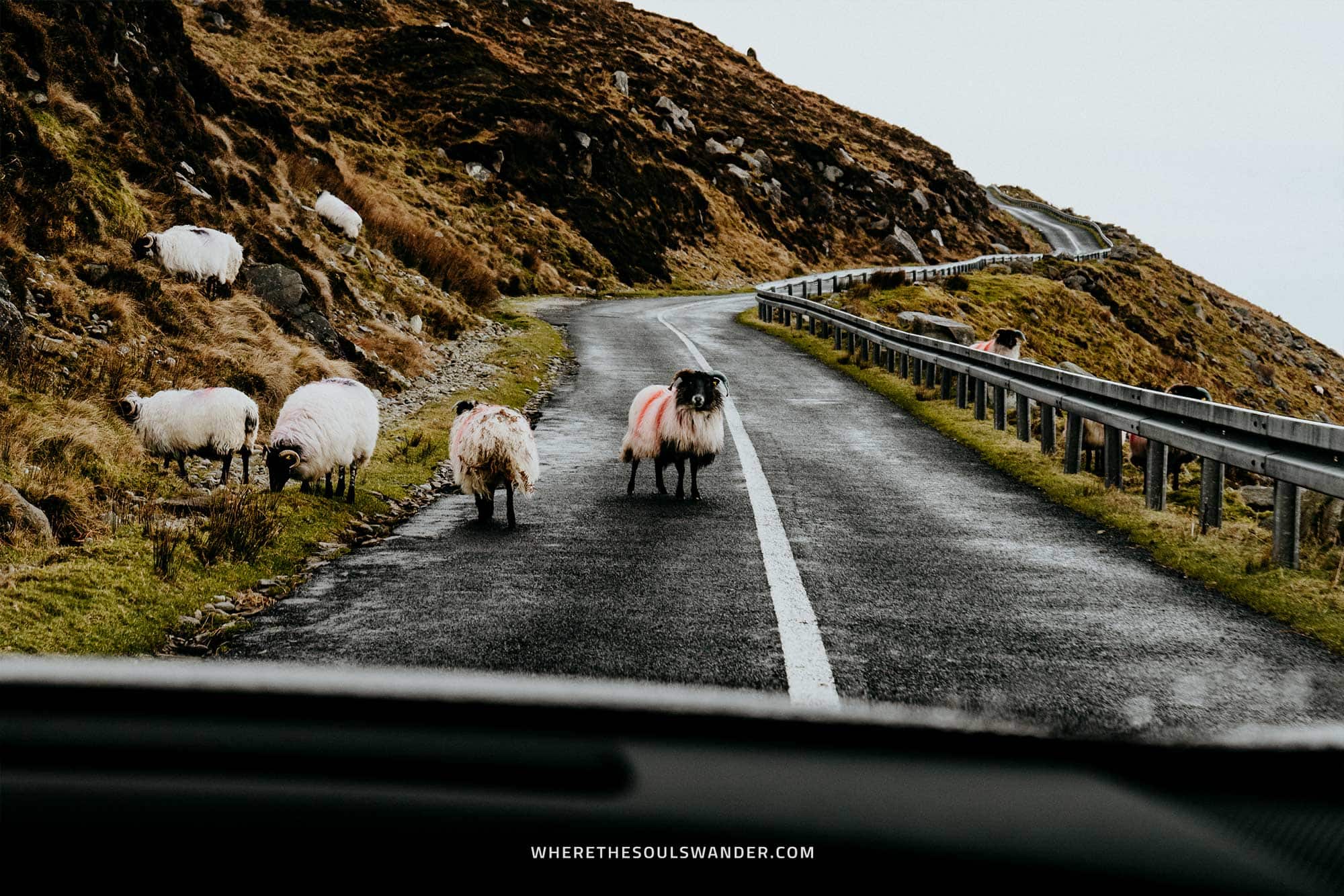
5 | Don’t forget to pay the M50 toll
First things first, make sure you put a reminder on your phone now to pay the M50 toll.
When renting a car from the Dublin Airport (which I’d highly advise you to do), odds are that you will pass the barrier-free tolling system on Dublin’s M50 motorway.
This innovative system grants drivers the ability to simply pass through, instead of stopping over to pay the toll at the booth, which makes the journey along this crowded area significantly faster.
The only thing that you’ll have to do is pay the toll online at Eflow by 8 PM the next day.
While this sounds pretty straightforward, I can tell from first-hand experience that it’s extremely easy to forget about the toll – I paid mine at home since I totally overlooked it.
If you forget to pay in time like me, don’t worry, you’re still able to pay it a few days later, just be aware that you will pay a small fine atop the initial toll.
6 | Consider renting a smaller car
While your rental car supplier will most likely present you with an upgrade that offers extra comfort when driving bumpy roads, I’m here to say that it’s better to stay with a slightly smaller car.
I say this because Ireland has no shortage of narrow country roads, and navigating these is far more easy in a smaller car rather than a huge SUV.
I opted for the Toyota C-HR, a medium-sized hybrid car, and had an easy time navigating the narrow country roads, while also having enough power to handle the steeper parts of my road trip through Ireland.
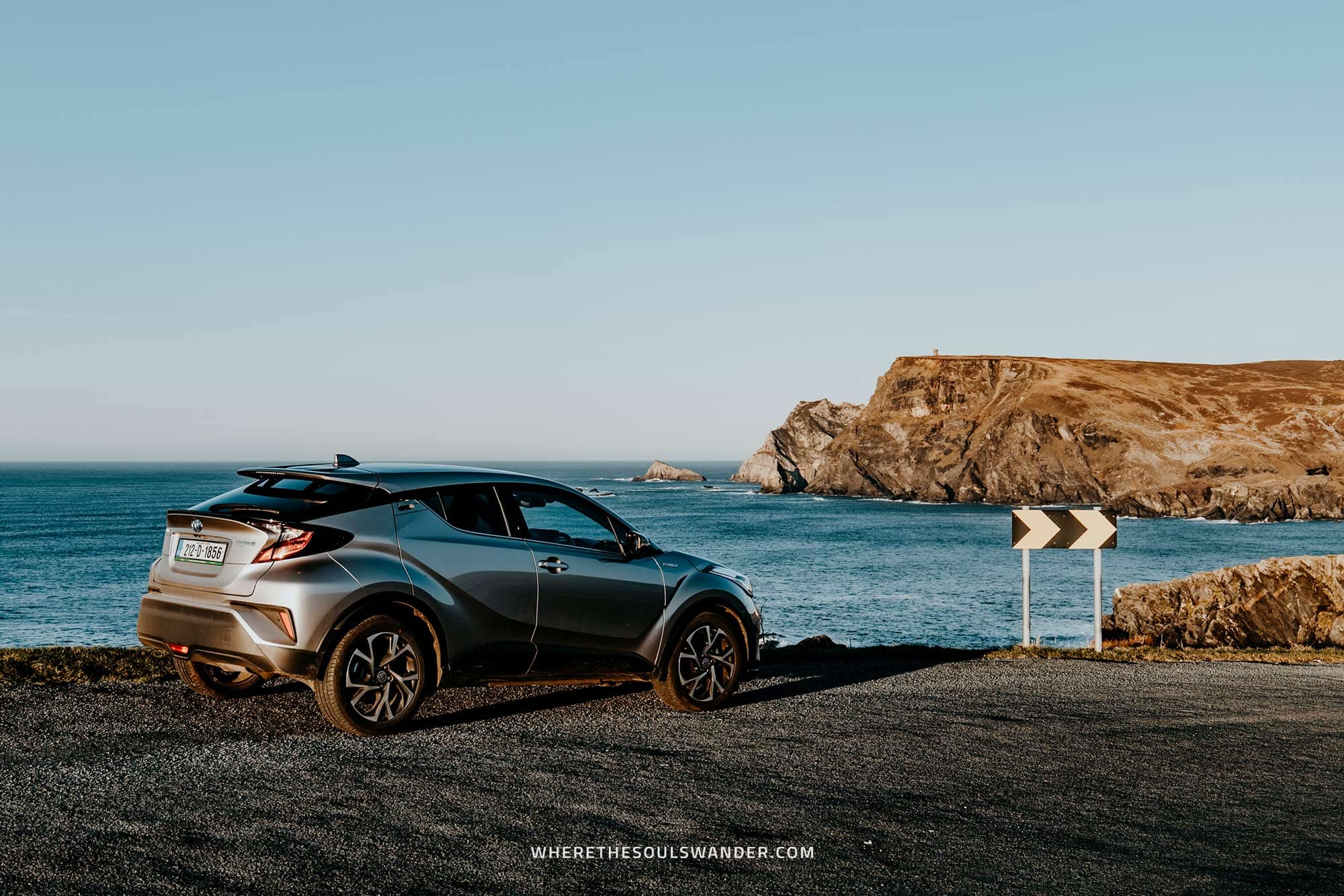
7 | The famous Irish weather conditions
Given Ireland’s position in the North Atlantic Ocean, the weather conditions can change rapidly, meaning all four seasons could occur in the blink of an eye.
One moment the sun is out and blazing, and the other moment, the rain is pouring from the skies.
While it doesn’t necessarily sound like an issue when sitting inside your car, it does requires some adjustment in the way you approach the roads.
For that reason, I’d highly recommend driving with your lights on at all times, since unpredicted rain or fog can easily restrict the sight of you and your fellow road users.
Lastly, when it starts raining or turns foggy, make sure you adjust your speed limits accordingly.
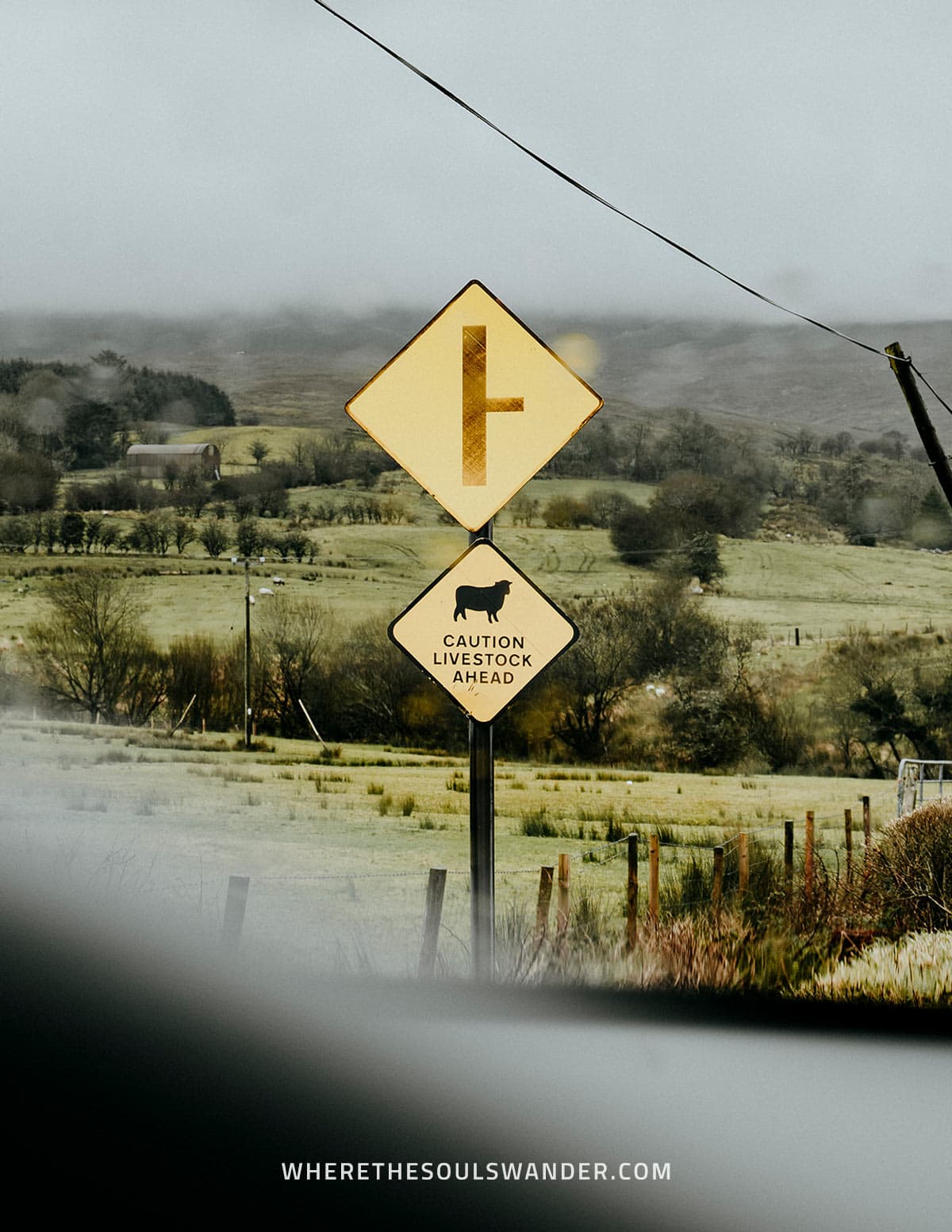

8 | Know your limits
Throughout Ireland, the speed limits include 50 km/h within urban areas, 80 km/h on secondary or regional roads, 100 km/h on national primary routes, and 120 km/h on motorways.
While it’s allowed to drive 80 km/h or faster on most roads, I highly suggest you to slow down a tad, especially when driving along narrow country roads.
Secondly, if it’s your first time driving on the left-hand side of the road, take your time and don’t mind letting local drivers pass you – your Ireland road trip isn’t a race.
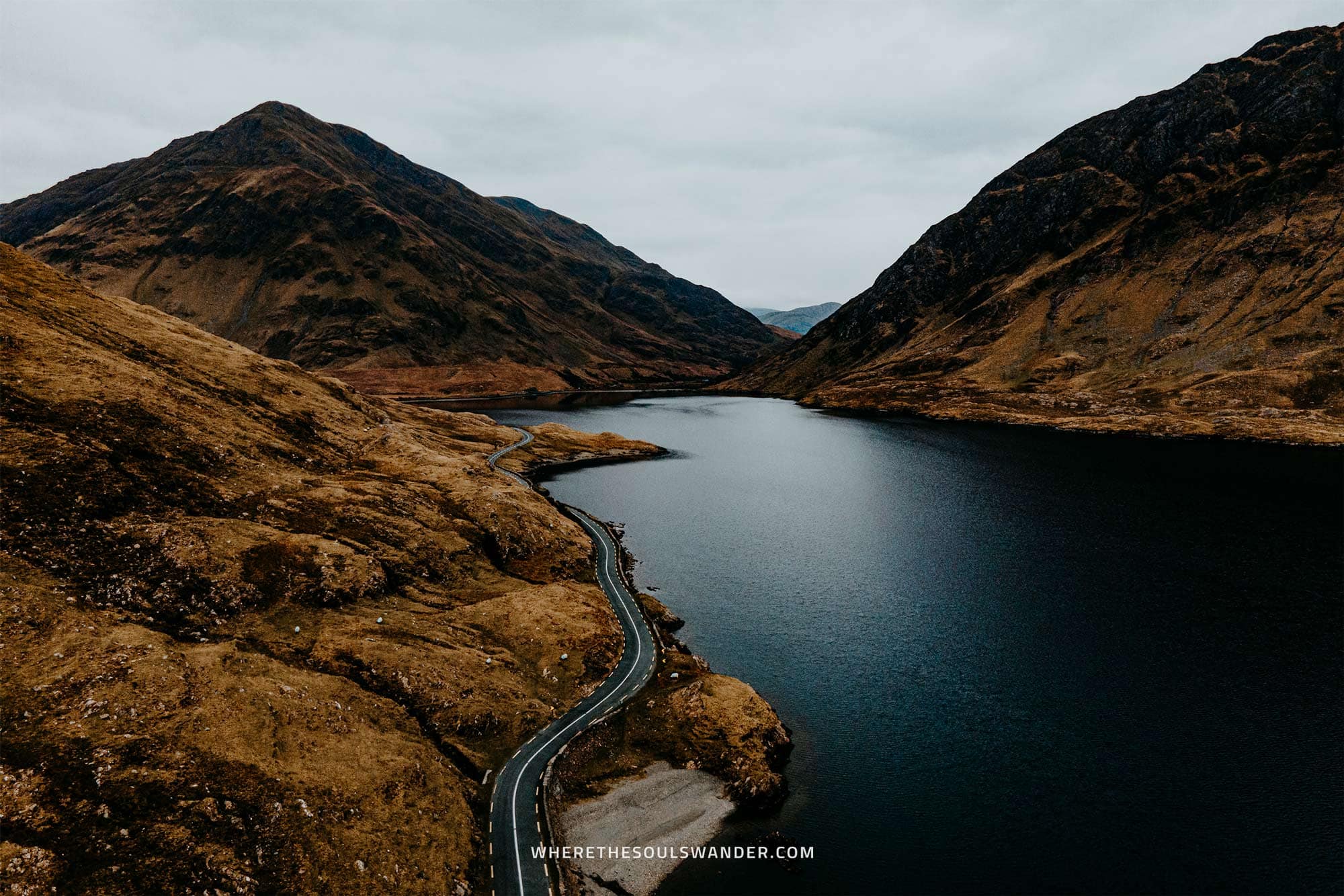
9 | Plan your route in advance
As with all road trips, the best thing to do is plan out your route in advance, so you have a clear overview of how many kilometres you be driving each day.
While you should always keep some time and space for spontaneous stops, it is pretty damn convenient (and time-saving) if you thoroughly research the highlights, and then bundle them in a logical day-to-day itinerary.
However, if you’re not from the planning side of things, don’t worry – I’ve put together a pretty awesome 9-day Ireland road trip itinerary, so be sure you give that a read too.
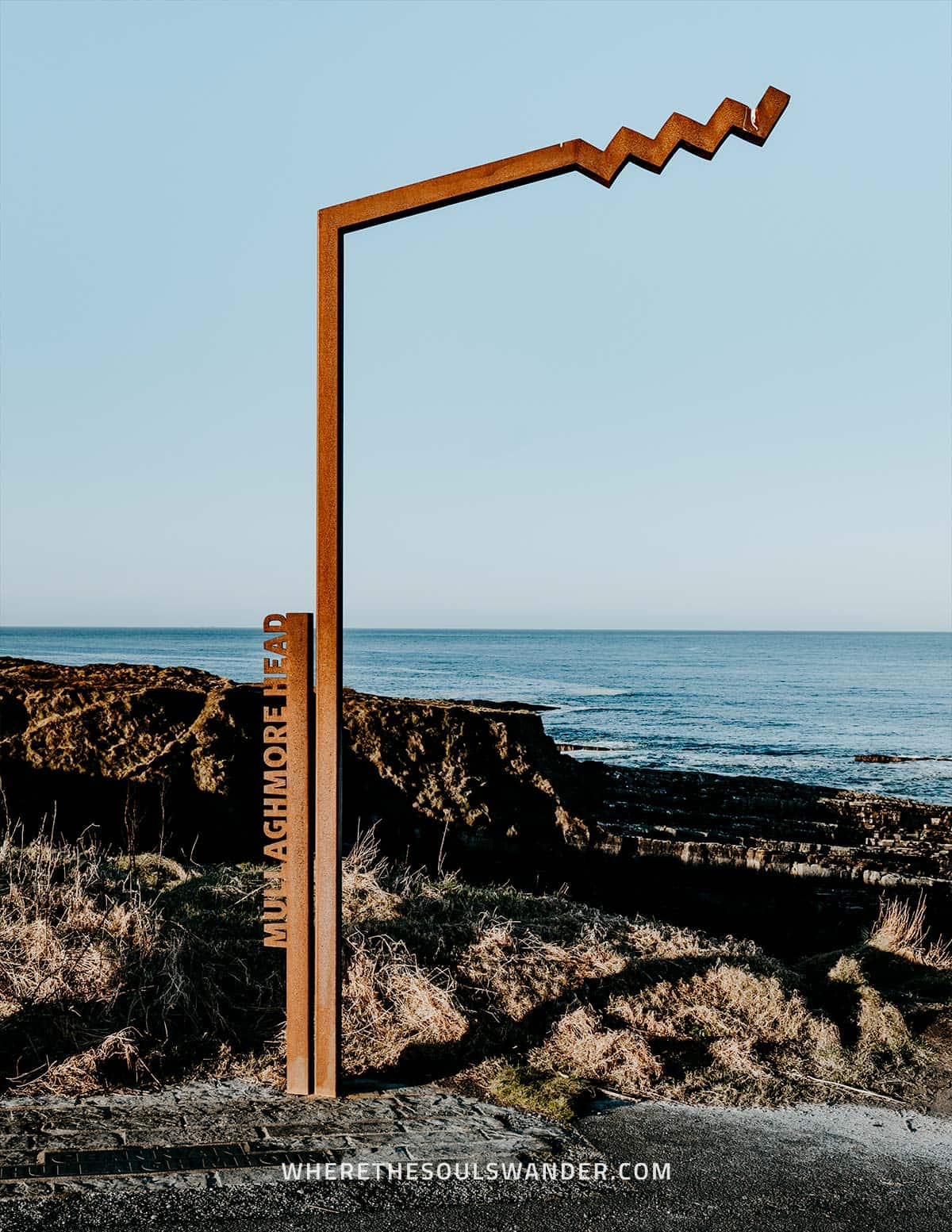
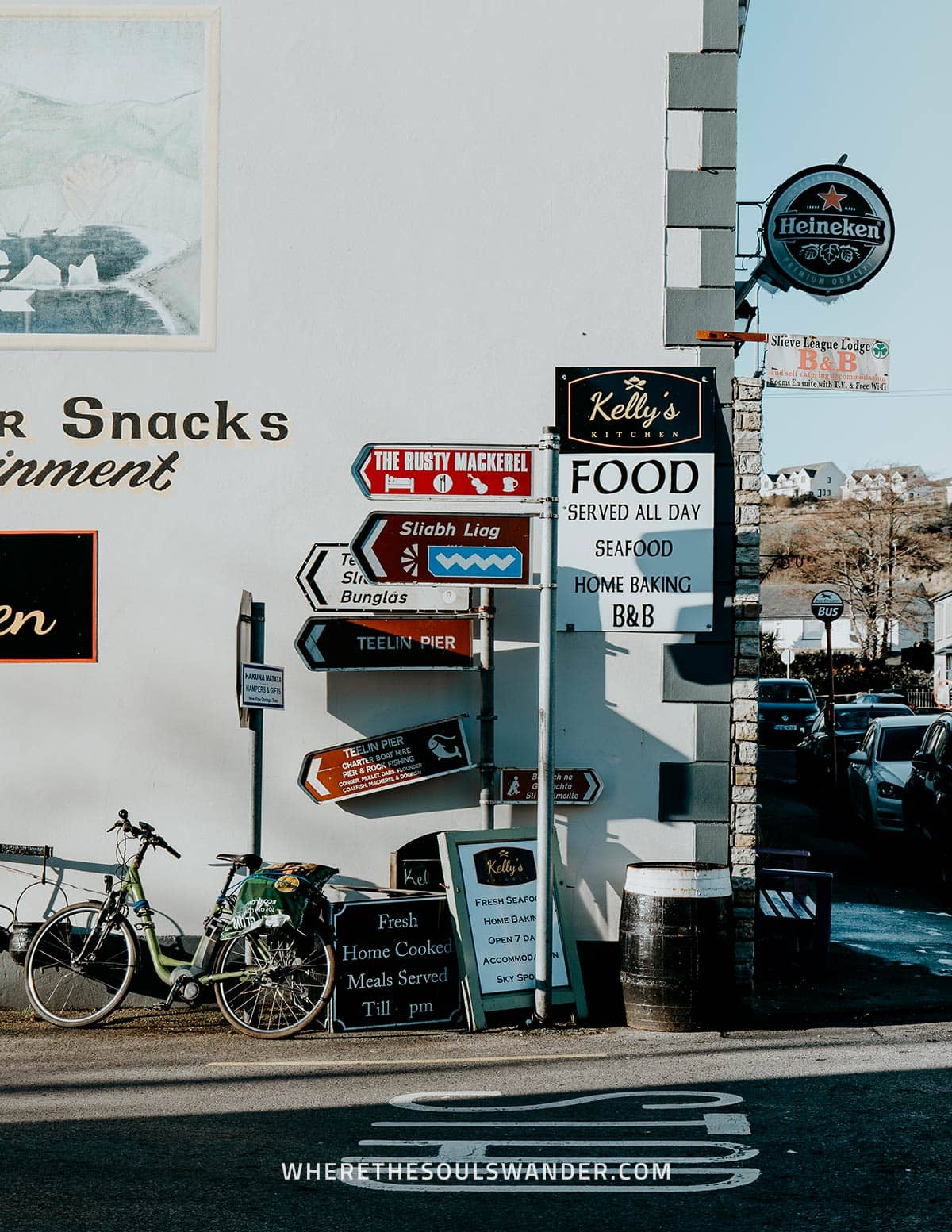
10 | Fill up often
While the distances in Ireland are completely manageable, keep in mind that a lot of Ireland is merely countryside with not a single petrol station in sight.
To avoid stranding on the side of the road, make sure you live by the following rule of thumb; always fill up your car when driving long distances or stretches that take you through the countryside.
Not only is running out of gas a bummer, but ending up on the side of the road in the middle of nowhere, waiting for another car to pass is simply a waste of time.
By filling up on time, you will also never disrespect the golden road trip rule – never let your fuel tank go lower than ⅓.
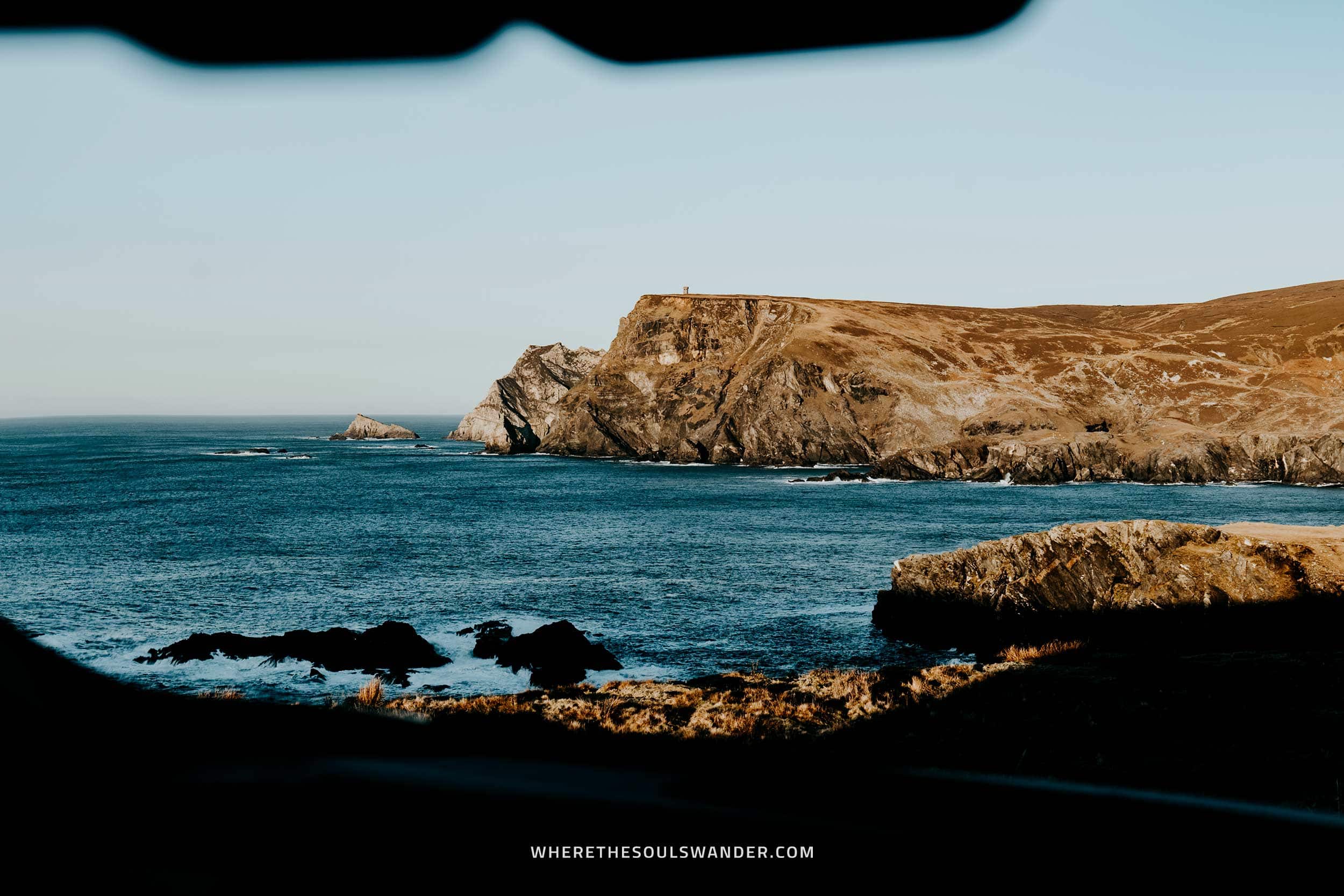
11 | Sort out your insurance
As I would mention in all my road trip guides, it is wise to travel with your essential insurance sorted out, this also involves the full coverage of your rental car.
Though you might save some money when leaving out the full insurance of your car, these few bucks wouldn’t outweigh the benefits of the full insurance option, as it fully covers the car’s excess, as well as damage to the windows, mirrors, wheels and tyres.
On top of that, I also advise you to do a thorough inspection of the car afore taking it out on the road. If you don’t do this, chances are that you have to pay for pre-existing damage and that would be a pity.
Then there is your travel insurance, which, I believe, you should always purchase when travelling abroad, this is also highly recommended when doing a road trip in Ireland.
For travel insurance, I use Heymondo, as they offer full covid-19 coverage, as well as a handy app with 24-hour medical assistance. Make sure you check it out – readers of WTSW receive 5% off any insurance policy. Additionally, I also recommend World Nomads.
PLAN YOUR IRELAND ITINERARY WITH THESE ESSENTIAL READS

13 Incredible things to do in Dublin, Ireland's vibrant capital
When it comes to unique city trip destinations in Europe, I believe Dublin should always be a topic of conversation.
Nestled at the mouth of the River Liffey that splits the city in two, is Dublin, Ireland’s vibrant capital city and for many travellers the starting point of their Ireland itinerary.
From cobbled streets filled with vibrant art and historic buildings to trendy cafes and traditional ‘Old Man Pubs’; the whiskey-inspired museums to enchanting literature and opulent libraries, Dublin is simply put, the perfect place to get a feel for Irish culture and its ways.
A city of its own accord, given its rich history and cultural diversity, Dublin is packed with impressive things to see and do, while it’s also surrounded by some of Ireland’s most striking natural sceneries, including the rough mountains of Wicklow – Vikings fans, this one’s for you!
What’s more, is that the streets of Dublin are slightly less overrun by foreign travellers in comparison to other cities in Europe, which adds even more authenticity to the experience.
To help you have a wonderful time here, I’ve put together this guide, including my favourite things to do in Dublin – plus my personal accommodation suggestions, advice on the Dublin Pass and more.
The Dublin Pass
While I realize that you’re here for my list of things to do in Dublin, there’s one particular thing that I want to inform you about first; the Dublin Pass, a digital tourist pass that grants access to over 35 attractions.
Since Dublin is home to a great number of things to see and do, you might want to get your hands on this pass, especially if you’re planning to visit most of the highlights.
Benefits of the card include free entrance to some of Dublin’s major sights, including the Guinness Storehouse, Jameson Distillery, and the Saint Patrick’s Cathedral, as well as a 1-day ticket of the Dublin hop on hop off bus tour.
The Dublin Pas | Book your Dublin Pass here.
13 things to do in Dublin
1 | Trinity College
2 | Ha’Penny Bridge
3 | Feather blade
4 | Guinness Storehouse Factory
5 | Kilmainham Gaol prison
6 | Brother Hubbard
7 | St. Patrick’s Cathedral
8 | Temple Bar
9 | Murphy’s ice cream
10 | Lough Tay
11 | Cliffs of Moher
12 | Jameson Distillery
13 | Hill of Tara
1 | Roam around at Trinity College
As if lifted straight out of a Harry Potter movie, Trinity College is Ireland’s oldest university and captivates its visitors with its enchanting appearance.
Established in 1592, the university schooled several renowned authors and poets, including Oscar Wilde, Bram Stoker and Jonathan Swift to name but a few.
At present, Trinity College is home to the famous Book of Kells, a 9th century illuminated manuscript that contains all four Gospels of the New Testament.
But the real attraction is the Long Room, an opulent library marked by gorgeous oak bookcases and the roughly 200,000 ancient books that fill up the shelves.
After wandering around the library myself, it’s easy to understand why J.K. Rowling got excited to use it as an inspiration for Hogwarts in Harry Potter.
THE ESSENTIALS
Where | Trinity College
Opening hours | Monday to Saturday 0830 – 1700, Sunday 0930 – 1700
Cost | €18,- per person
Tickets | Buy your tickets online here

2 | Take a walk over the Ha’Penny Bridge
There are only a few places in Dublin as iconic as the Ha’Penny Bridge.
Built back in 1816, this white-picketed bridge was the first-ever pedestrian bridge to span over the River Liffey, which came as a welcoming relief for those living on either side of the river.
It’s also worth mentioning that the bridge owes its name to the toll that was required to cross it, namely half a penny.
At present, the Ha’Penny Bridge has become an absolute must-see attraction in Dublin, and I believe, every visitor should cross the bridge at least once while in Dublin.
THE ESSENTIALS
Where | Ha’Penny Bridge
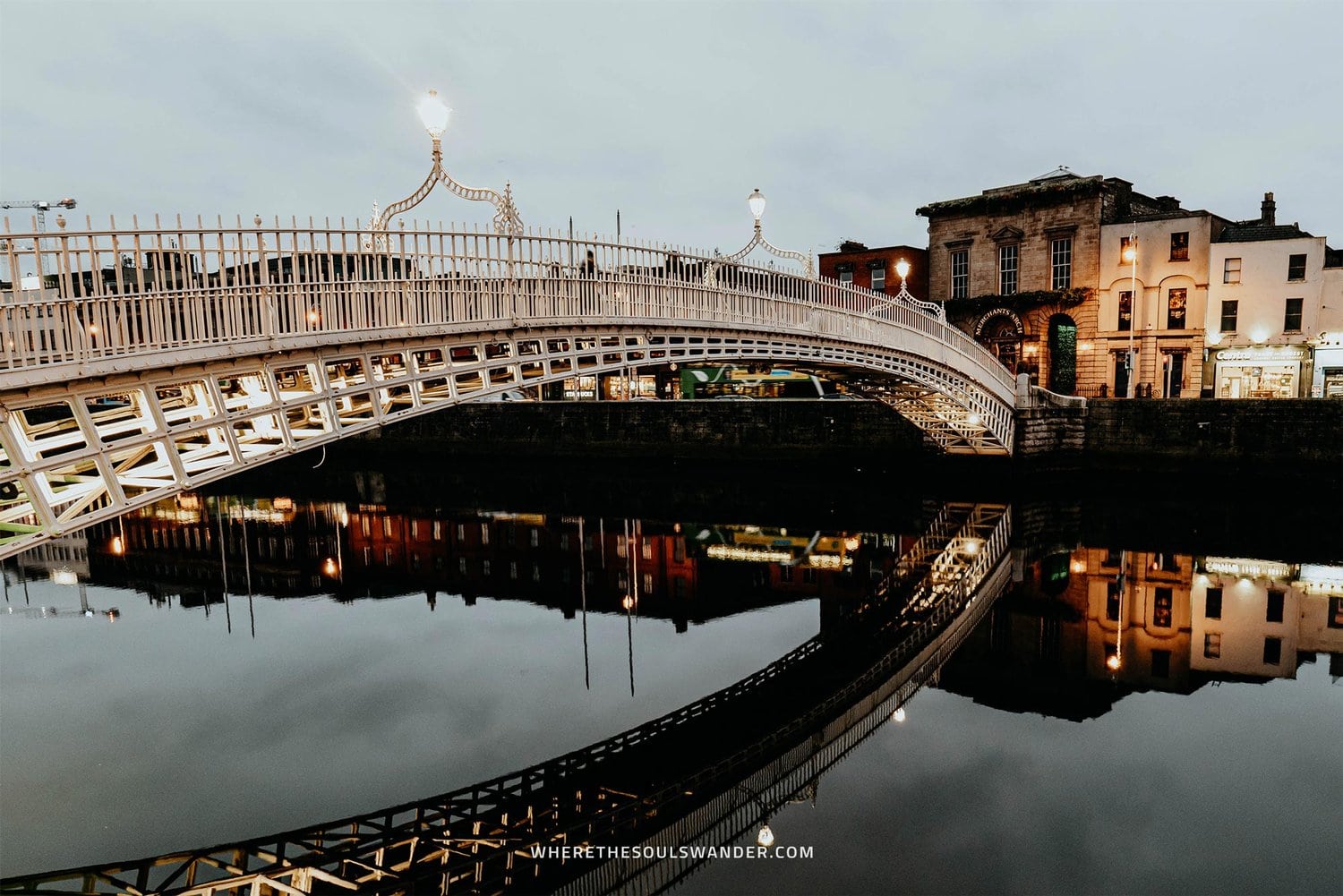
3 | Sample Dublin’s best burger at Feather blade
As soon as I heard SpottieOttieDopaliscious by Outkast bumping through the speakers, I realized that I arrived in the right place.
Situated smack bang in the middle of Dublin, Featherblade is a trendy burger joint that I would consider the number one spot if you’re after a top-notch burger in Dublin.
Their signature bacon cheeseburger is crafted to perfection, with top-notch quality from Irish beef Patty to artisan bun, with its crisp and juicy bacon pieces as the absolute centrepiece.
Seriously, this burger, which was voted ‘best burger’ in 2020, was so tasty that it’s up there with the best burgers I’ve ever eaten.
Add to that a trendy atmosphere, good music and a great overall dining experience, and Featherblade has become a must-visit for anyone spending time in Dublin.
THE ESSENTIALS
Where | Feather blade

4 | TAKE A TOUR OF THE GUINNESS STOREHOUSE FACTORY
Ireland is known as the motherland of Guinness, and therefore there’s no better place to taste this than in the country’s bustling capital city.
Situated in the heart of the St. James’ Gate Brewery, the Guinness Storehouse Factory is where lays the origin of one of Ireland’s national pride; Guinness beer, or as the Irish would say; a pint of gat.
Today, the storehouse factory accommodates a fun and informative museum that tells the tale of one of Ireland’s most famous alcoholic beverages, which made it become one of the most popular tourist attractions in the country.
The Guinness Storehouse Factory is only visited as part of a self-guided tour and takes you through seven floors of Irish brewing history, where you learn all about the brewing process, as well as the history of this cherished stout beer.
At the end of the tour, you’ll reach the 7th, and last floor, where it’s finally time to sample a pint of Guinness while enjoying an epic panoramic view of the Dublin skyline.
THE ESSENTIALS
Where | Guinness Storehouse Factory
Opening hours | Monday to Friday 1000 – 1700, Sunday 1200 – 1700
Recommended tour | Get your Guinness Storehouse Entrance Ticket here
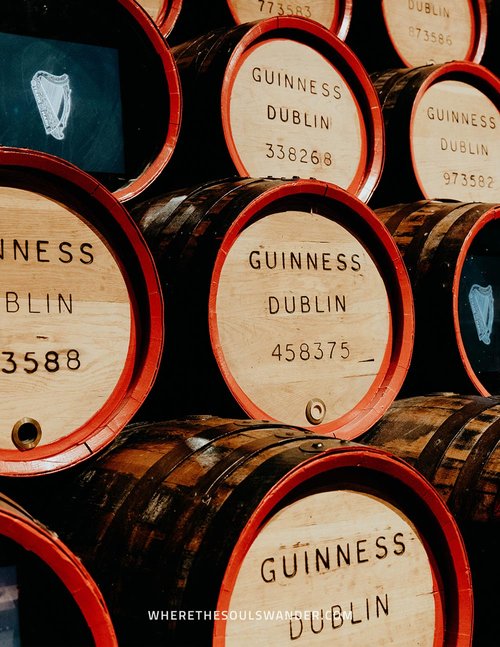


5 | VISIT THE KILMAINHAM GAOL PRISON
When I prepared for my trip to Ireland, I’d knew I wanted to learn more about Ireland’s fight for independence, so the first thing I did was place the Kilmainham Gaol Museum on top of my list of things to do in Dublin.
Situated just a few kilometres outside Dublin, the Kilmainham Gaol Prison is now turned into a museum, with one clear goal; to educate and inform those who visit this former jail.
It’s good to note, that you should purchase your ticket in advance, since visiting the Kilmainham Gaol Museum is only possible in the form of a guided tour.
During the 1-hour tour, the guide will take you through the former prison blocks, courtyard and old chapel, while he also informs you about the prison’s gruelling history.
Do be aware though, it can be pretty upsetting to hear how many revolutionaries and prisoners were executed between 1796 and 1924, including the famous political and military leaders Robert Emmet and Charles Stewart Parnell.
After the prison tour, you will have time to look at an impressive exhibition that covers three levels, each telling the stories of different periods of time. I’d highly recommend taking your time to see what’s on display, as it holds more than 10.000 objects.
Since Kilmainham Gaol houses some aesthetically pleasing features, the prison has also been used as a set for several films, including the original ‘Italian Job’, and more recently so; Paddington 2.
THE ESSENTIALS
Where | Kilmainham Gaol Museum
Opening hours | Daily 0930 – 1800
Recommended tour | The Kilmainham Gaol Museum can only be visited as part of a guided tour. Prices and availability here
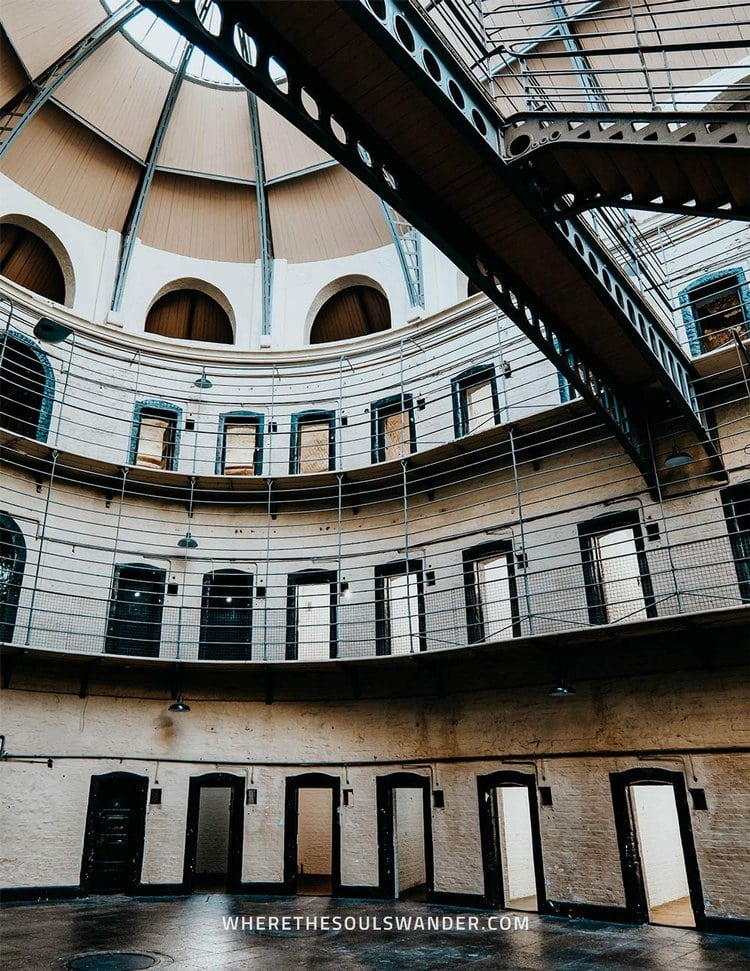
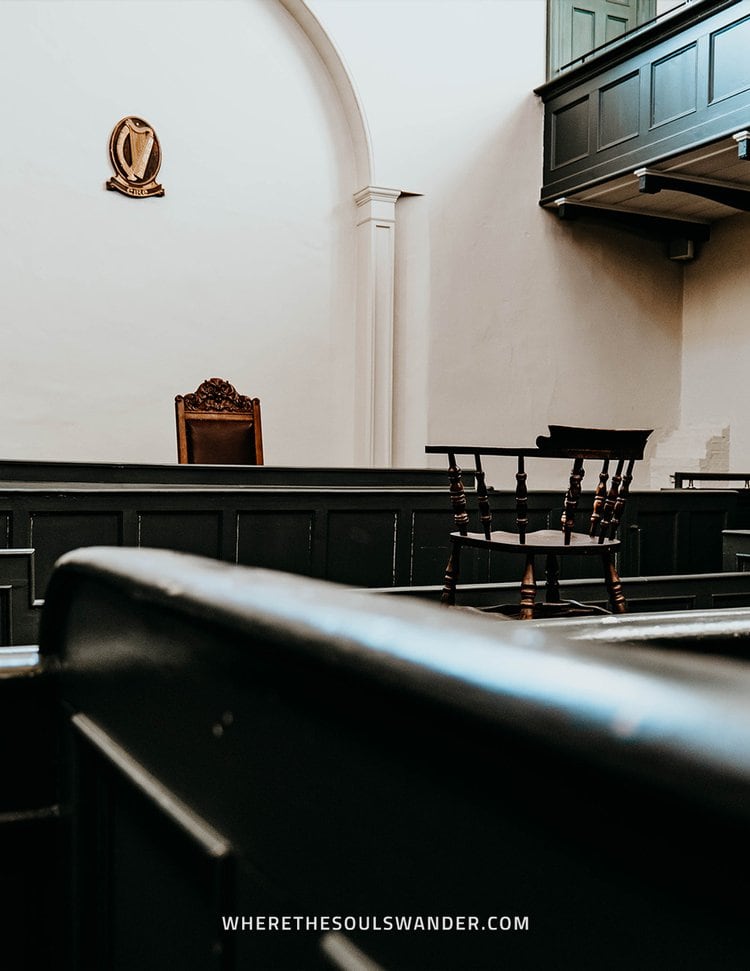
6 | Have breakie or lunch at Brother Hubbard
After seeing Brother Hubbard featured in an episode of Somebody Feed Phill, I instantly realized I had to drop by for some coffee and lunch.
Now renowned throughout the whole of Dublin, Brother Hubbard opened its doors in 2012, which initiated the transformation of Dublin’s somewhat dull café culture.
Situated at different locations throughout the city, Brother Hubbard is a trendy cafe that serves excellent dishes with a subtle Middle Eastern touch to it.
I opted for the basic; two eggs, grilled bacon and a chunky warm roast tomato sauce, served with homemade Georgian-style sourdough toast and the most flavoursome Irish butter on the side – it was indeed basic, yet incredibly delicious.
While the menu is relatively small, it is extremely creative, with a focus on freshness, quality and local produce, which is always a good thing.
So if you’re seeking a trendy lunch or brunch spot that serves excellent coffee too, look no further, you have just stumbled upon the right place.
THE ESSENTIALS
Where | Brother Hubbard North
Opening Hours | See opening hours here
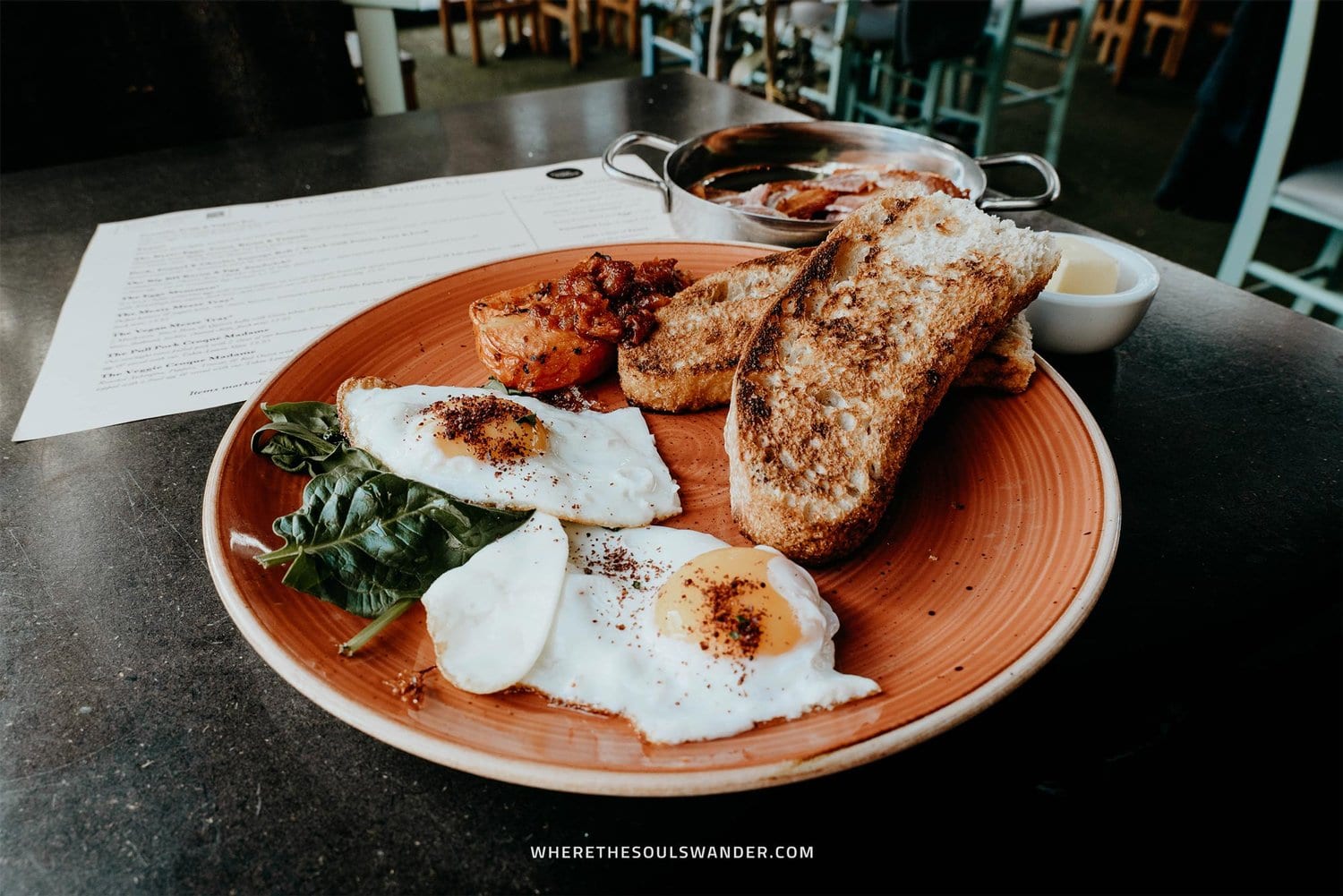
7 | Admire the St. Patrick’s Cathedral
Founded in 1191, St. Patrick’s Cathedral is the largest Church in the whole of Ireland and is therefore named the National Cathedral of the Church of Ireland.
Part of Ireland’s history for over 800 years, St. Patrick’s Cathedral remains one of the most fascinating buildings in Dublin, and strolling through its lush gardens is certainly a must when visiting the city.
It’s truly a stunning place from the inside and out and the opulent interior reflects various periods of its lengthy historical timeline – so be sure to have a peek inside too.
One thing worth mentioning is that it isn’t the only cathedral on Dublin soil, no, it shares this reputation with the neighbouring Christ Church Cathedral, which was initially built just outside of Dublin.
THE ESSENTIALS
Where | St. Patrick’s Cathedral
Opening hours | Monday to Saturday 0930 – 1630, Sunday 0845 – 1015 and 1300 – 1700
Cost | €8,- per person – St. Patrick’s Cathedral is also included in the Dublin Pass.
Recommended tour | This self-guided tour of St. Patrick’s Cathedral. Prices and availability here
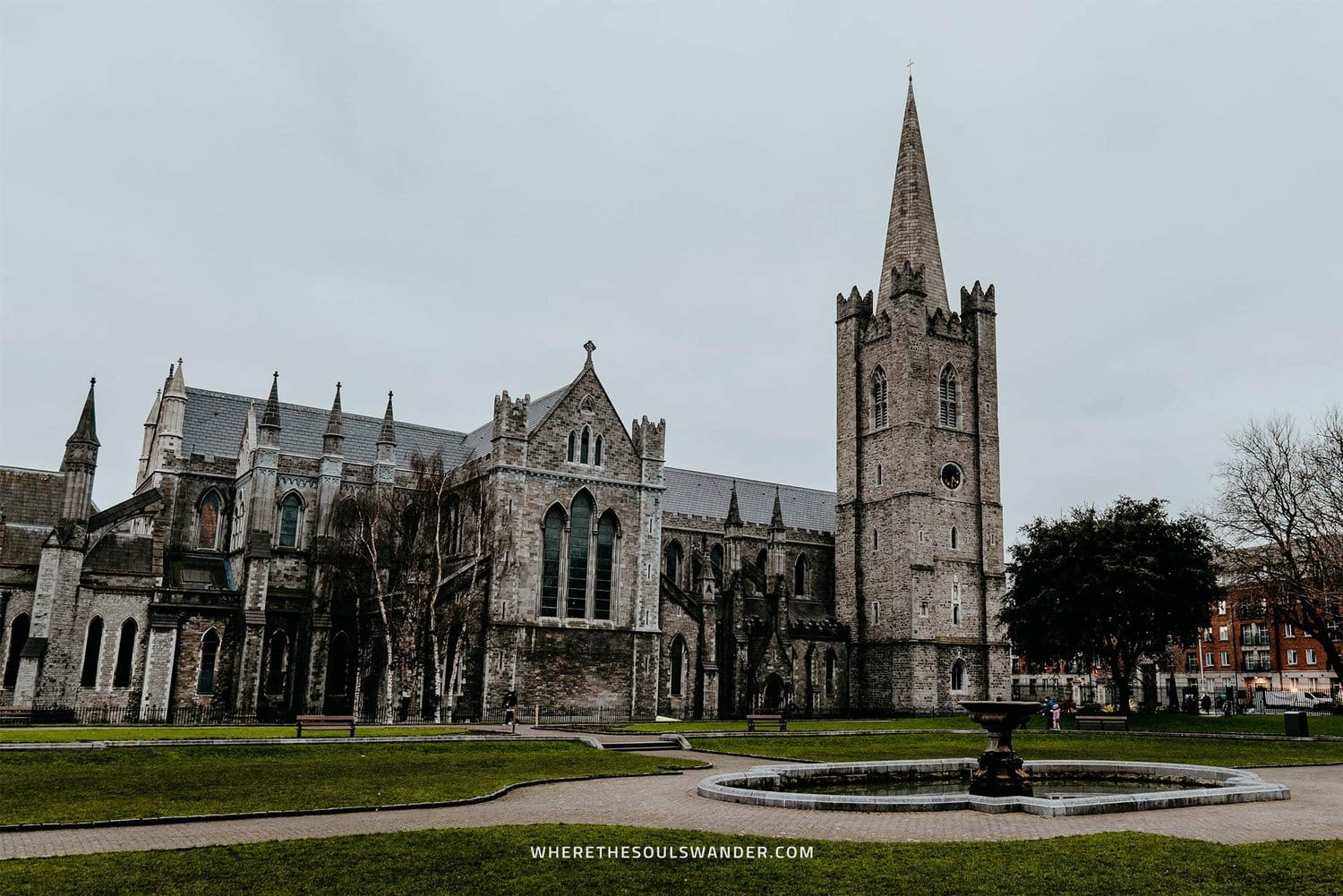
8 | Have a pint at Dublin’s iconic Temple Bar
When people talk about Dublin, the iconic Temple Bar will always be a topic of conversation.
Nestled in the eponymous Temple Bar District, this iconic bar on the south side of the River Liffey is one of the oldest areas in Dublin and is often high on the bucket list of those visiting the city.
The district itself is a maze of cobbled streets with heaps of lively pubs, hosting some of the country’s best musicians, which makes it a must-see for those who want to experience Dublin’s buzzing nightlife.
The pubs come alive after 5, when both locals and travellers gather to sample a pint of Guinness or a good glass of Irish whiskey while enjoying live music and an authentic atmosphere – it’s a successful combination for a unique travel experience.
Ooh, and be cautious, the locals are capable to drink you under the table too – just kidding!
THE ESSENTIALS
Where | The Temple Bar
Opening hours | Daily 1030 – 0100
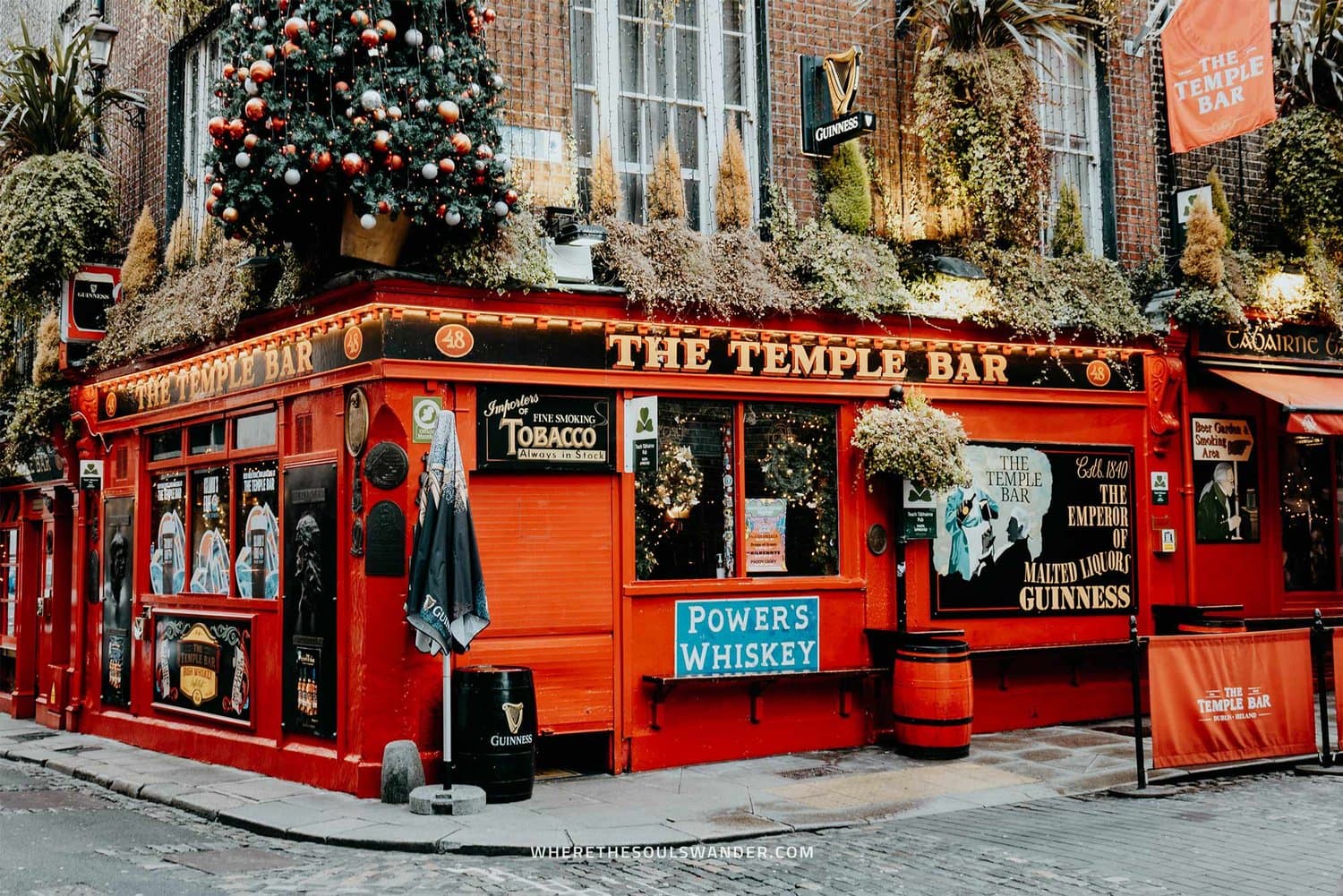
9 | Have a scoop or two at Murphy’s ice cream
Originated in Dingle, Co. Kerry in 2000 is Murphy’s ice cream, an artisanal ice cream shop that started with one clear goal; making the best ice cream in the world – and believe me, they’ve come pretty close!
Luckily for us, Murphy also opened its doors in Dublin.
Set within Wicklow street, Murphy’s serves a great variety of ice cream, made from Ireland’s finest local produce, including the milk of the rare, indigenous Kerry cow.
I opted for 3 scoops of the following flavours; Dingle Sea Salt, Irish Brown Bread and Honeycomb Caramel and was blown away not only by their flavours but also by their exceptional texture and creaminess.
If you’re looking for something more adventurous, Murphy’s also serves uncommon flavours such as Dingle Gin and Pink Peppercorn, Irish Coffee and Rum Raisin.
I’m not gonna lie, it can be quite the struggle to choose from their unique and inviting flavours. Fortunately, this shop is so awesome, that they let you sample the flavours before making your final selection – winner!
THE ESSENTIALS
Where | Murphy’s ice cream
Opening hours | Daily 1200 – 2200
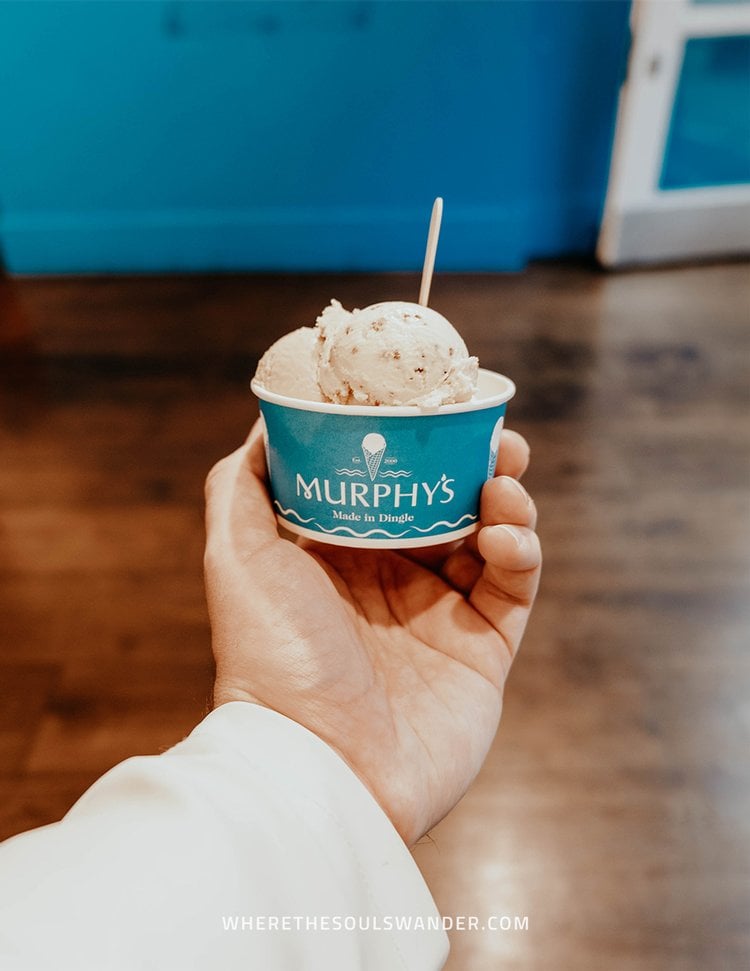
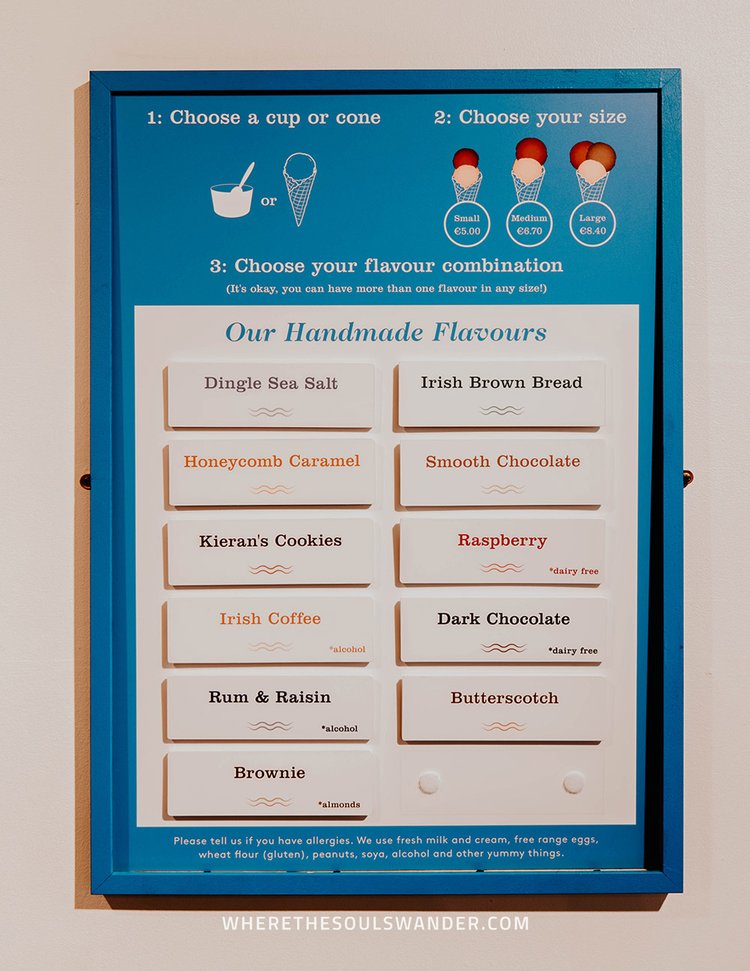
10 | Visit Lough Tay and the Wicklow Mountains
Nestled in the heart of the Wicklow Mountains, Lough Tay is a stunning lake that has become famous for its appearance as ‘Kattegat’ in History’s blockbuster series ‘Vikings’.
While its shores are now private property, and therefore no longer accessible by the public, you will stumble upon plenty of interesting viewpoints, all offering the iconic views that made the ‘Guinness Lake’ famous.
With a whopping 20,483 hectares of ground, the Wicklow Mountains National Park is a true natural paradise and that at only a stone’s throw away from the hustle and bustle of Dublin.
Also, the Wicklow Mountains National Park is considered the number one national park in the whole of Ireland, which isn’t a surprise to me given its untouched nature and endless tranquillity.
Visiting the Wicklow Mountains is in many ways one of the best day trips out of the city – and easily one of the most exciting things to do on your trip to Dublin.
THE ESSENTIALS
Where | Lough Tay, County Wicklow
Recommended tour | This full-day Wicklow Mountains Tour takes you to the Wicklow Mountains, as well as the 6th-century monastery complex of Glendalough. Prices and availability here
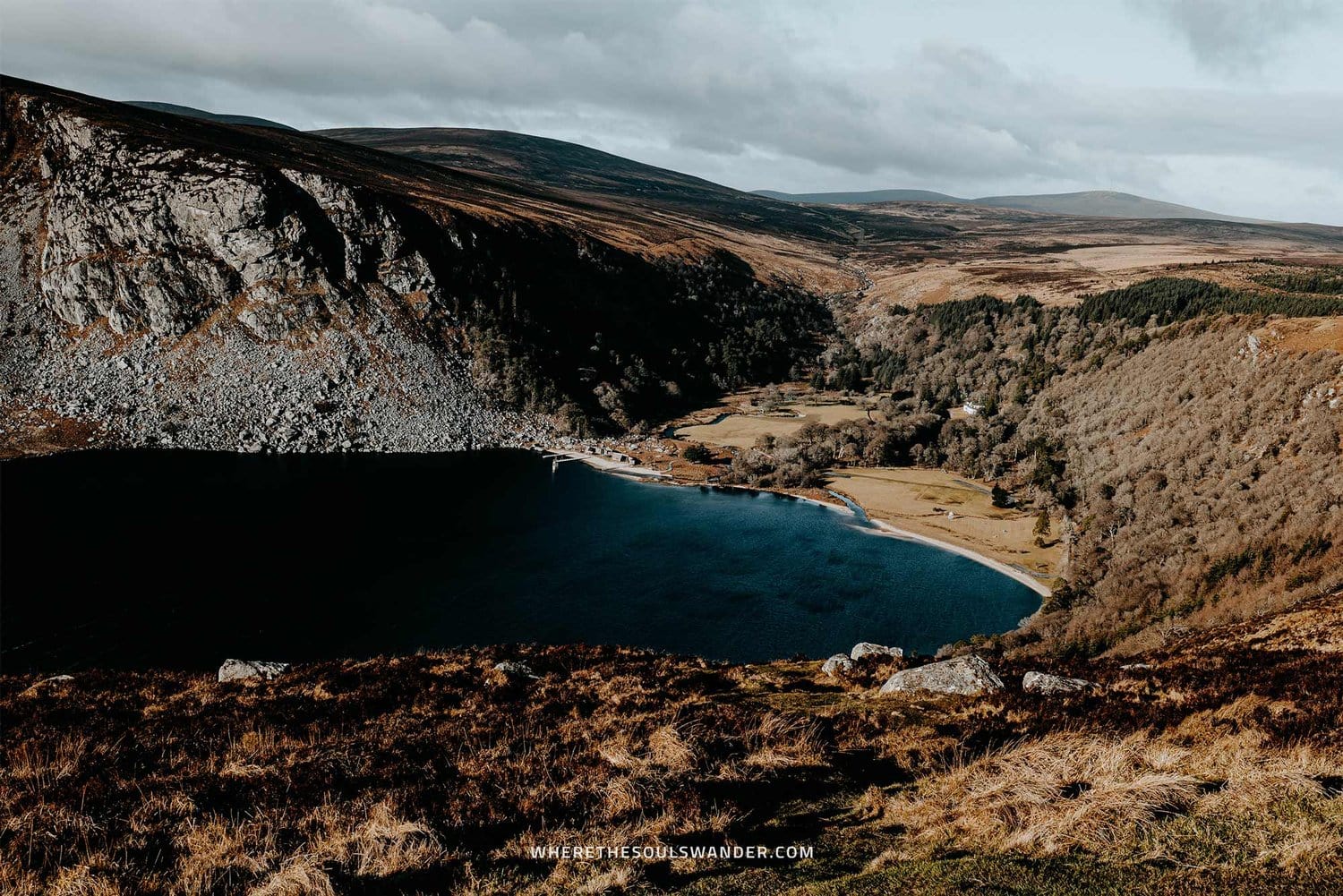
11 | GO ON A DAY TRIP TO THE CLIFFS OF MOHER
From the moment I started preparing for my travels to Ireland, I told myself that I wanted to see the insanely stunning Cliffs of Moher at all costs.
Located roughly 3,5 hours drive from Dublin, the Cliffs of Moher are considered the most famous cliffs in Ireland, reaching a whopping height of 214m at their highest point.
With safe, paved pathways, several incredible viewpoints and an award-winning Visitor Centre, the famous Cliffs of Moher has now become the country’s second most visited tourist attraction.
While there are lots of popular day trips to the Cliffs of Moher, I would highly recommend visiting it as part of a road trip through Ireland. If you’re in Dublin on a city trip, opt for this full-day trip to the Cliffs of Moher instead.
THE ESSENTIALS
Where | The Cliffs of Moher
Opening hours | See opening hours here
Recommended tour | This full-day guided tour of the Cliffs of Moher is an excellent way to behold the impressive landscape that defines the area.
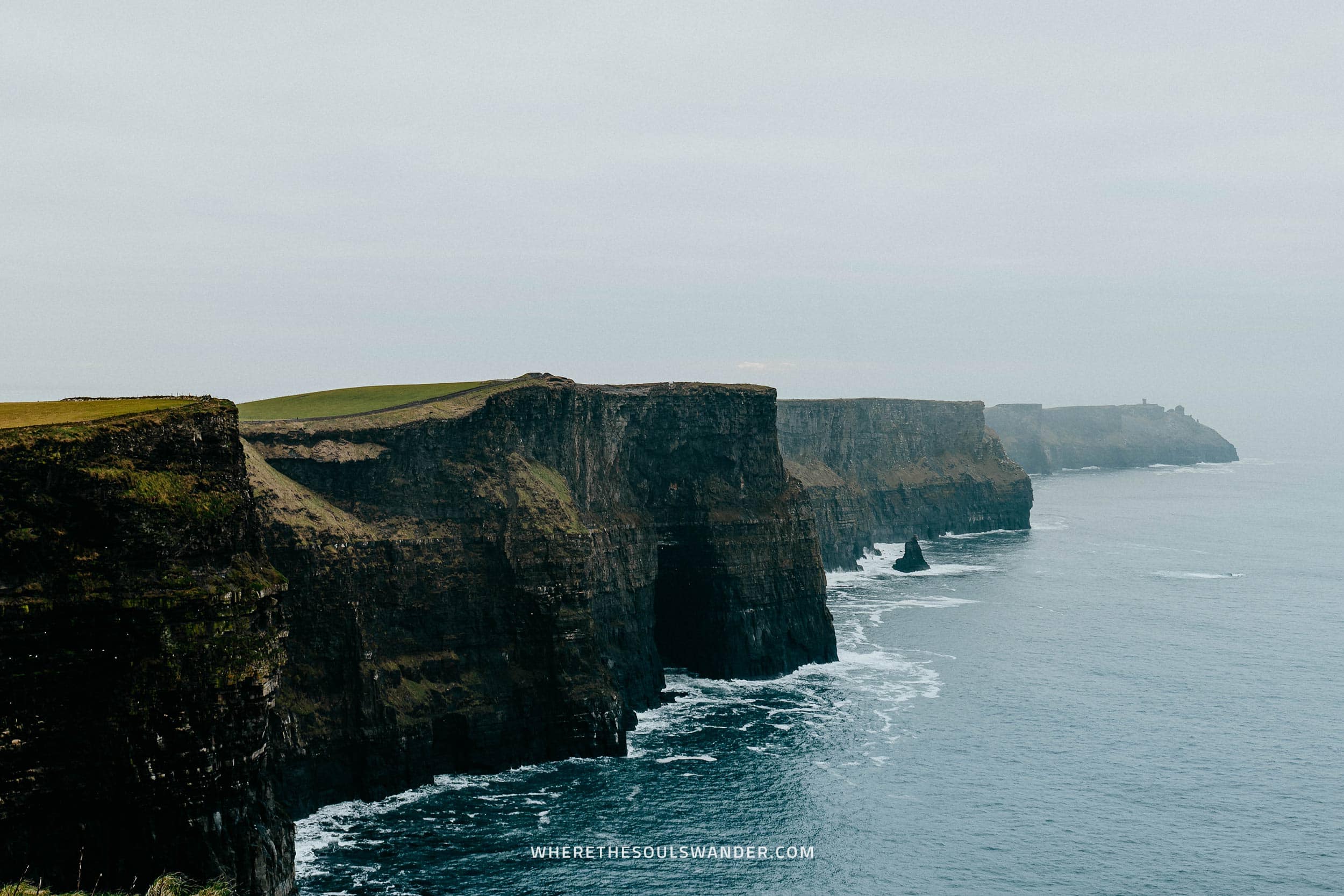
12 | Taste Irish whiskey at the Jameson Distillery
Besides Guinness, there’s one thing that the Irish produce exceptionally well too – whiskey!
Hands down the best way to learn about Irish whiskey and its rich and captivating history (Ireland has been making whiskey for well over 200 years), is by joining the famous Bow Street Experience Tour in the Jameson Distillery.
Awarded ‘The World’s Leading Distillery Tour Award’ three years in a row, the Jameson Distillery offers visitors a unique experience by giving them a peek inside the production process of one of the world’s most famous whiskey brands.
The tour also includes a unique comparative whiskey-tasting experience, learning you to understand the differences between Scotch whisky, American bourbon, and Irish whiskey.
On top of that, you’ll receive a Jameson Whiskey tasting certificate, so you can show off your whisky knowledge to family and friends at home.
THE ESSENTIALS
Where | Jameson Distillery
Opening hours | Monday to Thursday 1100 – 1800, Saturday 1100 – 1900, Sunday 1200 – 1800
Cost | €25,- per person
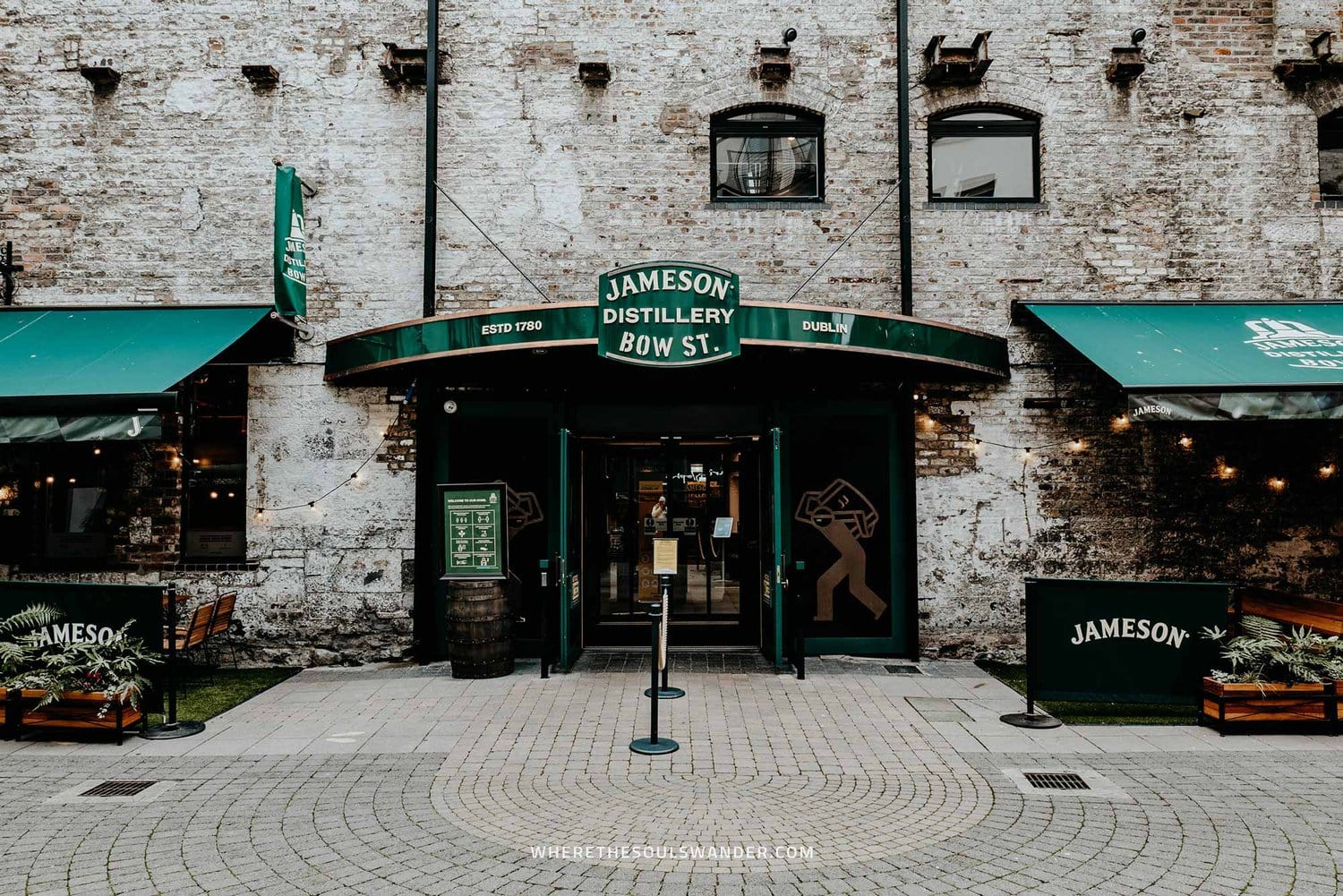
13 | Visit the Hill of Tara
Situated a roughly 45-minute drive from Dublin, the Hill of Tara is considered Ireland’s most sacred stretch of land and the soul of Ireland’s history, legend and folklore.
Legend has it, that the site has been in use for more than 5.000 years, and that it was once the ancient seat of power in Ireland.
It is also said that during both prehistoric and historic times, a total of 142 kings reigned over the Hill of Tara, which makes this place even more impressive
While I’d have to admit that it’s not the most scenic place, I believe its long and captivating historical timeline is enough reason to include the Hill of Tara in this guide of things to do in Dublin.
THE ESSENTIALS
Where | The Hill of Tara
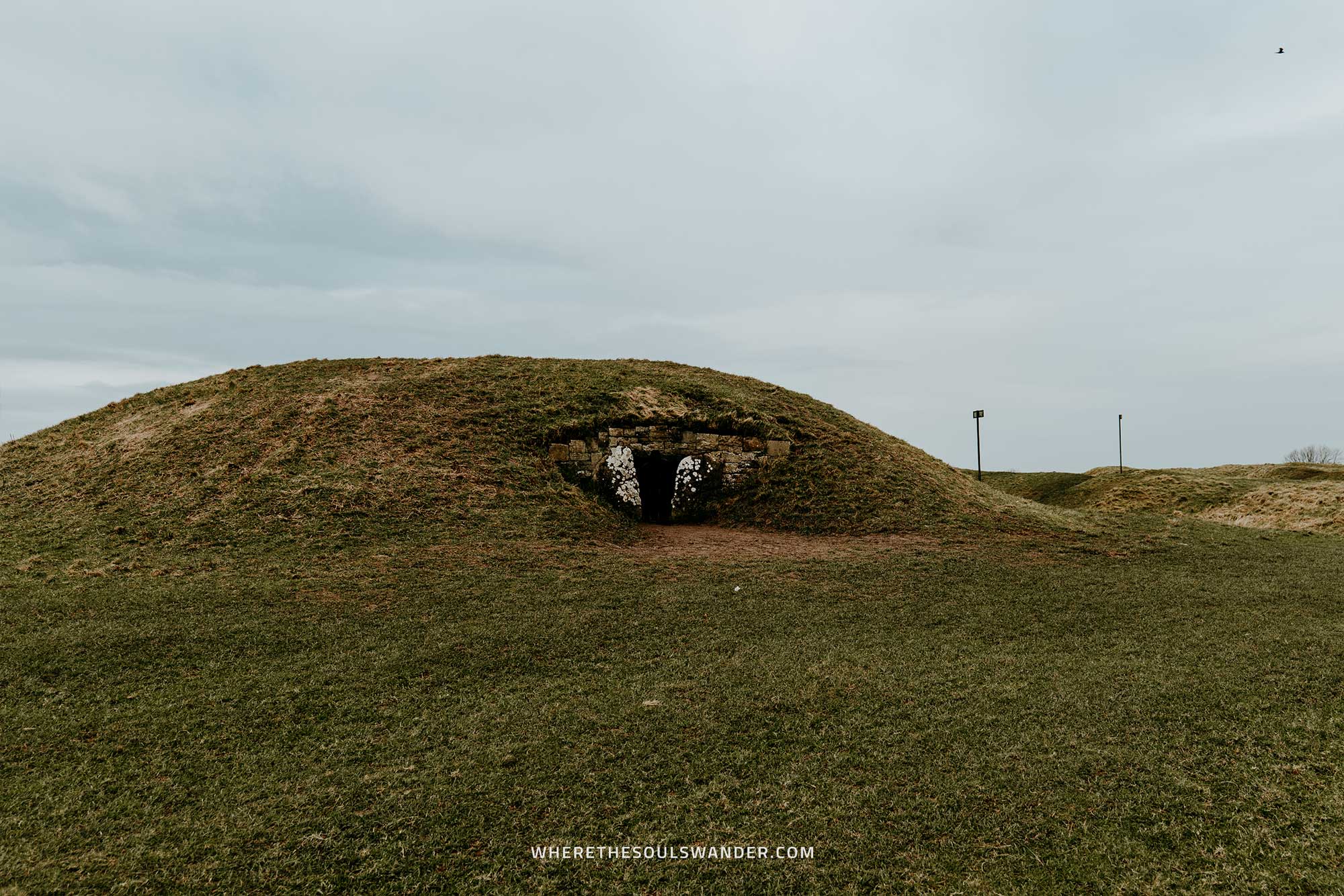
Where to stay In Dublin
For a relatively small capital, Dublin is packed with excellent accommodation options catering to all travel styles – from luxury hotels to family-run apartments to budget-friendly hostels.
Since there’s plenty of accommodation to choose from, I have narrowed it down to a few of my favourites, two of which are marked, these are the ones where I stayed.
+ Cassidys Hotel | Set within the heart of Dublin, Cassidys Hotel offers spacious boutique-style rooms, large double beds and an excellent ensuite bathroom with a rain shower. Given its excellent price-to-quality ratio and its prime location, you might want to book this one ahead.
Wren Urban Nest | Located only a stone’s throw away from Dublin’s popular Temple Bar, this brilliant hotel offers stylish modern-style rooms with a touch of minimalism. All rooms come with comfy double beds, air conditioning and an excellent private bathroom. If you value sustainable design or some extra comfort, make sure you check out their innovative rooms here.
+ Templebar Rooms | This is where I stayed, and I really had a pleasant stay here. This hotel provides comfortable rooms with stylish design right at the heart of the action. Double rooms at only €90,- a night make this one of the best options in the city centre of Dublin.
Marlin Hotel Stephens Green | Another great hotel at walking distance from all the best things to do in Dublin, Marlin Hotel Stephens Green is a great pick for those after some extra comfort. Think of a variety of stylish rooms, a prime location and all the modern-day luxuries to have a comfy. So, if you’re looking for a bit of splurge, be sure to check out the stunning Marlin Hotel.
Weather in Dublin | Best time to visit Dublin
The weather in Dublin, like all of Ireland, can be rather complicated – meaning all seasons could occur in one single day.
At one moment the sun is out, and half an hour later the skies are pouring with rain, so preparing yourself for these quickly fluctuating weather conditions is an absolute must when visiting Dublin.
In terms of the weather, I’d highly recommend the peak summer months of June till August, when the weather is way more steady and the streets buzzing with festivities.
If you prefer to avoid some of the crowds, while still enjoying relatively good weather, I’d suggest opting for the shoulder months of April, May, September and October instead.
During this time, the accommodation will be slightly more affordable too, which is another great upside of travelling during the shoulder period.
How to get to Dublin
PLANE | Dublin Airport is located only 20 minutes from the city centre, and hosts both European and International flights, meaning you will probably enter Ireland here.
For flights to Dublin, I would suggest you check out Skyscanner as they have a user-friendly website that makes it pretty straightforward to find good cheap flights.
From the airport, hop aboard the Dublin Express for a quick transfer to the city. The journey takes about 20 minutes and leaves every 30 minutes. A return ticket will cost you only €10.
Stay safe in Ireland | Travel insurance
While Ireland is totally safe for travellers, I always strive to have my travel insurance sorted out before going on a new adventure, and I highly suggest anyone else to do the same.
Where we prefer to assume that everything runs smoothly during our travels, in reality, an accident can happen at any moment – when that happens, it is better to be safe than sorry.
Heymondo | Whether you’re going on a 3-week backpacking trip, or planning a long stay somewhere abroad, Heymondo has excellent insurance options either way – plus full covid-19 coverage and a handy app with 24-hour medical assistance. Readers of WTSW receive 5% off any insurance policy, more information here.
World Nomads | If you’re an adventure seeker, backpacker, or planning your once-in-a-lifetime world trip, make sure you check out World Nomads, they designed the perfect travel insurance to help you travel safer and smarter. Do note that they’re not covering covid-19 related claims.
PLAN YOUR IRELAND ITINERARY WITH THESE ESSENTIAL READS
A complete guide to the Connemara National Park, Ireland
When doing research for my Ireland road trip itinerary, one of the experiences I was looking forward to the most was the Diamond Hill hike in the Connemara National Park.
Nestled in the heart of County Galway lies the Connemara National Park, one of the six natural parks in Ireland and home to some of the best hiking trails in the country, including the scenic Lower and Upper Diamond Hill trails.
Covering a whopping 2.000 hectares, the park houses a wide variety of natural features, including bogs, rolling hills, heathland and rocky mountain ranges, with Diamond Hill and the stunning Twelve Bens range at the core of it all.
By far the best way to sample all these stunning and diverse landscapes is by taking on the manageable 7,6-kilometre hiking trail to the summit of Diamond Hill.
My in-depth guide to the Diamond Hill hike in the Connemara National Park offers all the essentials to have an unforgettable experience – plus some of my favourite hiking tips too.
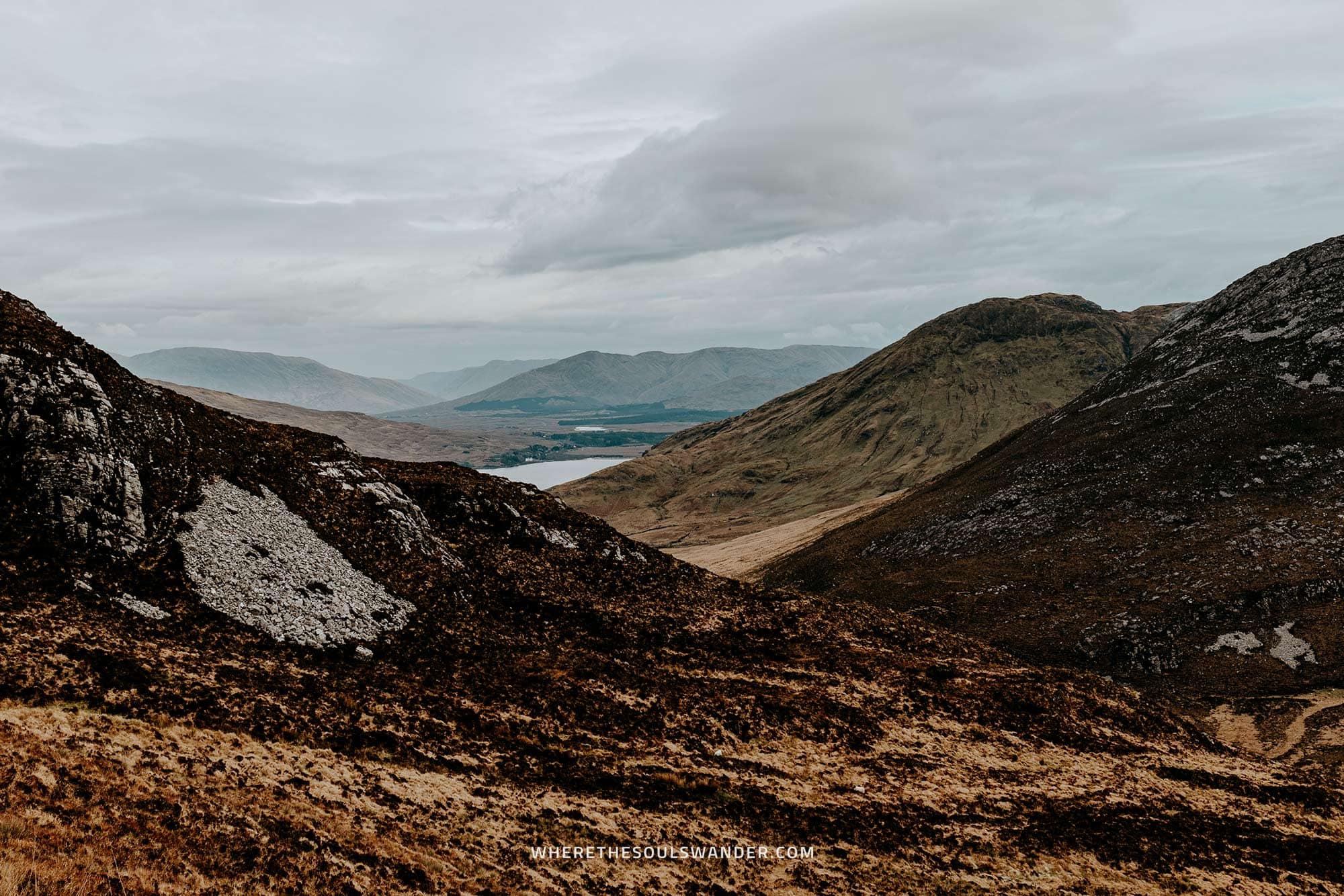
Where is the Connemara National Park
Covering a total of 2.000 hectares, the Connemara National Park is nestled in the heart of County Galway in the West of Ireland.
The entrance of the park itself is located on the Clifden side of Letterfrack, about 1,5 hour drive away from Galway.
Connemara National Park entrance fee
Situated in Letterfrack, a small village just off the N59, is the Connemara National Park visitor centre, your first point of call when it comes to information about the park.
At the moment of writing (March 22’), there’s no entrance fee for those visiting the Connemara National Park. On top of that, the parking area is also completely free of use.
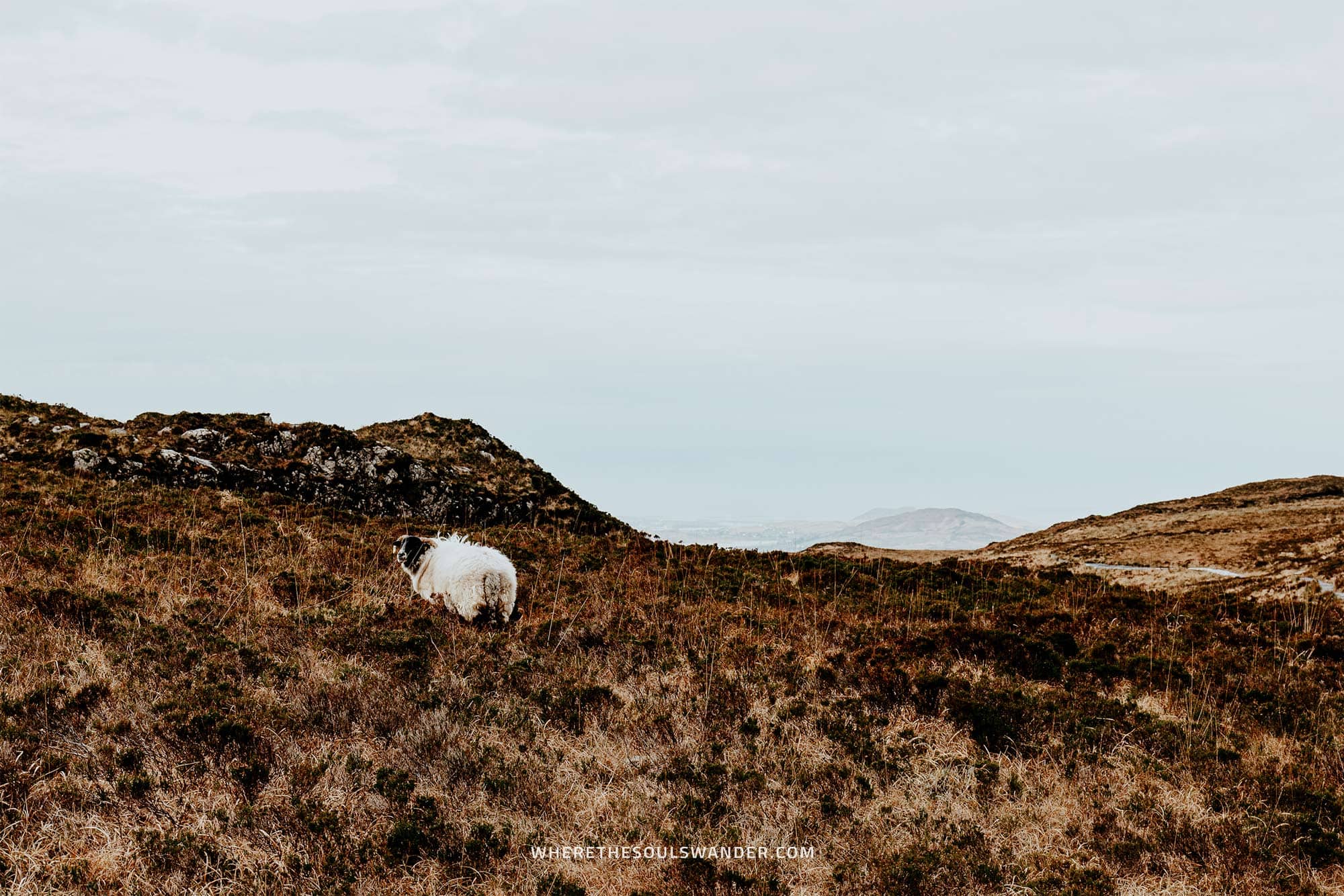
Opening hours of the Connemara National Park
In general, the Connemara National Park is open every day with no fixed opening hours.
However, given the ever-changing weather conditions in Ireland, the park closes for safety purposes when the weather warnings turn orange or red.
To avoid unexpected surprises, I’d highly recommend keeping an eye on the weather warnings, before planning a trip to the park.
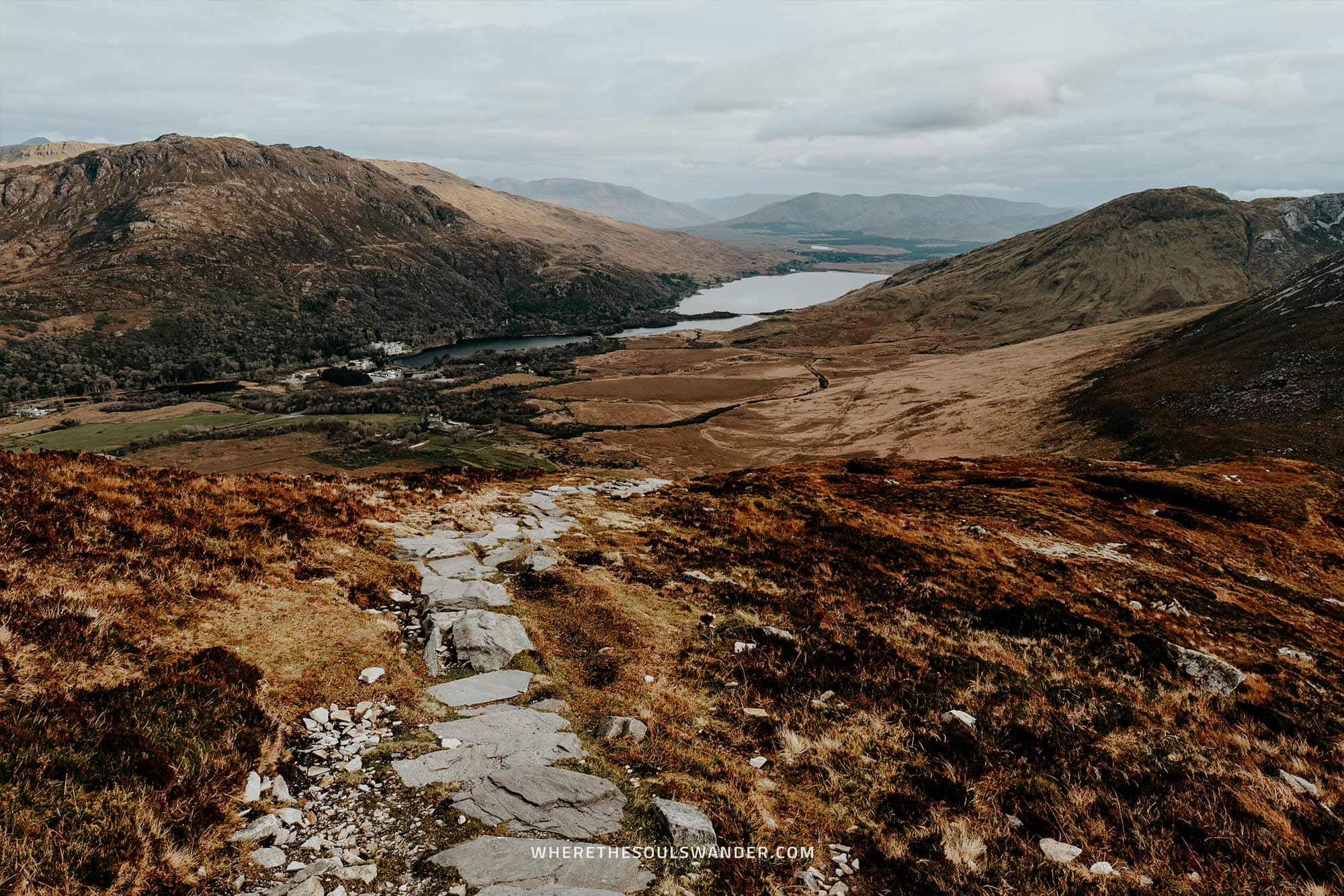
How to get to Connemara National Park
CAR | As with most tourist highlights in Ireland, the best way to get to the Connemara National Park is as part of a road trip.
By renting a car, you’ll have all the freedom to get to the park on your own terms, while it’s also significantly easier to get around the country in general.
If you’re thinking of renting a car yourself, make sure you check out rentalcars.com, as they have a broad range of cars on offer, additional insurance options, and brilliant overall service.
Upon arrival at the Connemara National Park, you’ll have free parking facilities
TOUR | Another great way to visit the Connemara National Park, is by joining this full-day guided tour from Galway.
What makes this tour interesting, is that you’ll be guided by an experienced local guide, who tells you about the region’s intriguing traditions, music, and language.
Add to that, that you have enough free time to explore the park and hike to the summit of Diamond Hill, and this tour is a great option for those without a rental car.
BUS | Alternatively, the Connemara National Park is also reached by public bus from both Galway and Westport.
For the route from Galway, jump aboard bus 923 in the direction of Letterfrack. For tickets and timetables, visit the official Citylink website. The journey takes around 1 hour and 50 minutes.
From Westport, opt for bus 423 operated by Bus Eireann with end destination Letterfrack. For tickets and timetables, visit the official Bus Eireann website. The journey takes around 1 hour and 10 minutes.
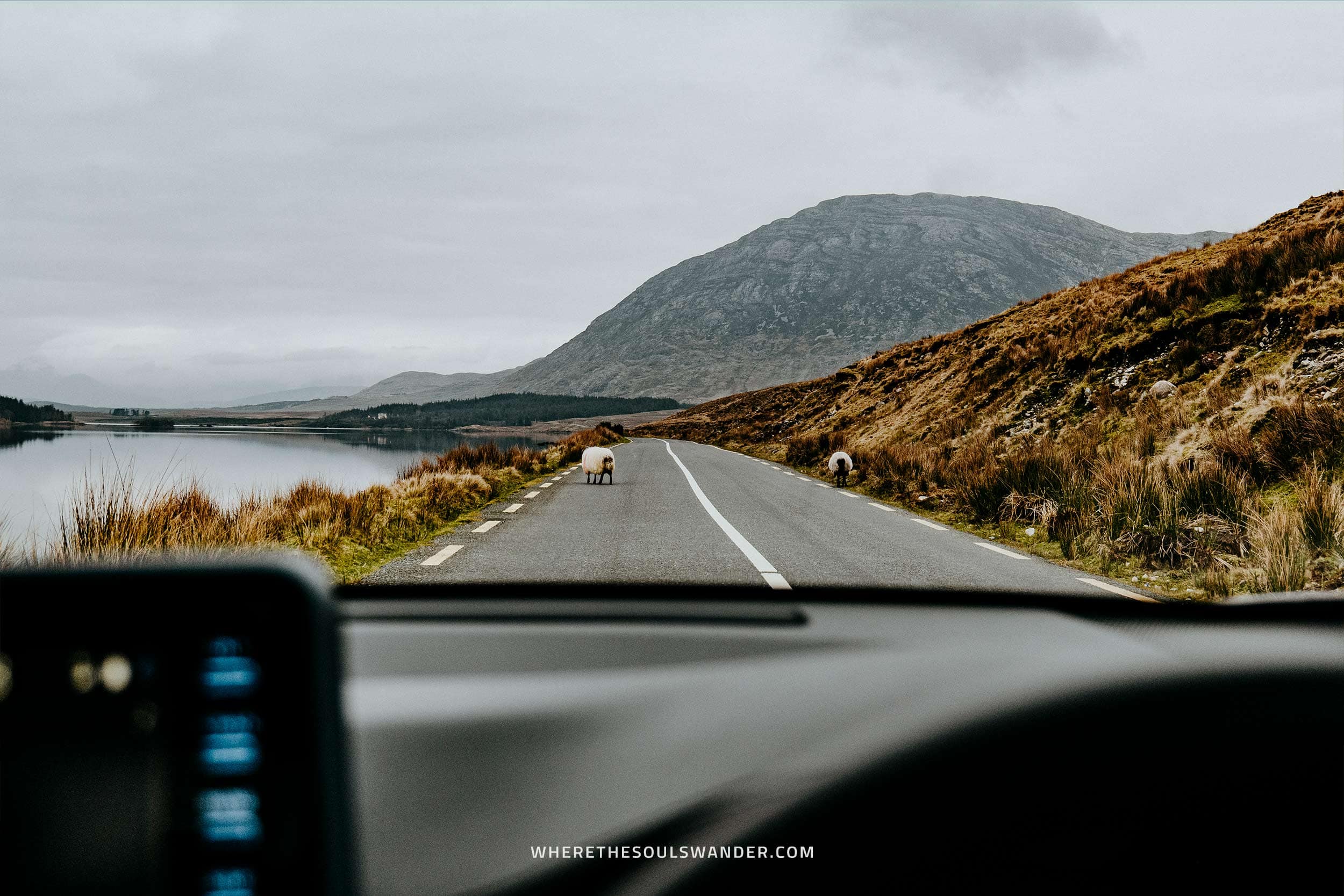
The details of the Diamond Hill Trail
Difficulty | Easy
Hike distance | 7,6 Kilometre
Hike duration | 3 hours
Elevation gain | 411 meters
Things to see and do at Connemara National Park
Lower Diamond Hill Trail
The first section of the famous Diamond Hill hike starts with the Lower Diamond Hill Trail, an easy-to-follow path that brings you along bogs, heaths, grasslands and forest.
Starting at the Connemara National Park visitor centre, the Lower Diamond Hill Trail is relatively short and it takes only 1,5 kilometres before it blends with the Upper Diamond Hill trail.
Depending on your fitness level, you can choose to continue the loop back in the direction of the visitor centre, or opt for a challenge, and hike to the summit of Diamond Hill via the Upper trail.
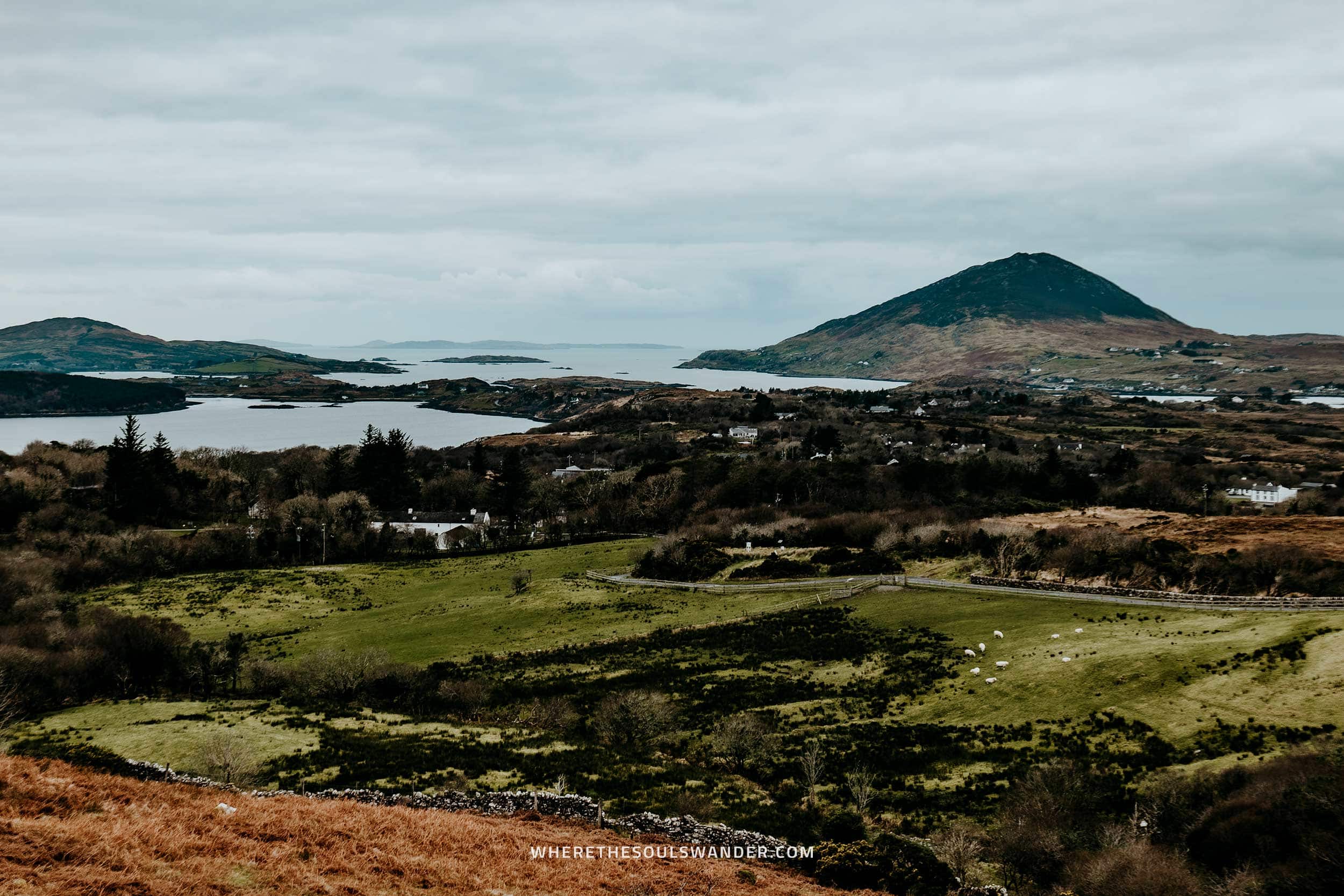
Upper Diamond Hill Trail
Upon arrival at the Upper Diamond Hill Trail, you’ll immediately notice the views, as they get better and better with stunning panoramic views of the surrounding region.
Though this part of the trail starts relatively easy, with comfortable boardwalks, it doesn’t take long before you stumble upon a dusty road that prepares you for the first real climb of the hike.
After about 20 minutes, you’ll come to the point where rocky stairs will lead you to the summit of Diamond Hill at 442m above sea level.
The final section of the trail is pretty steep and a tad sketchy, so make sure you take proper safety precautions, especially if it’s windy. Also, the summit is completely exposed, so be careful at all times.
Once arrived at the summit of Diamond Hill, you’ll be welcomed by the most stunning views of the Twelve Bens, a stunningly beautiful mountain range, with the Benbaun (729m) as its highest point.
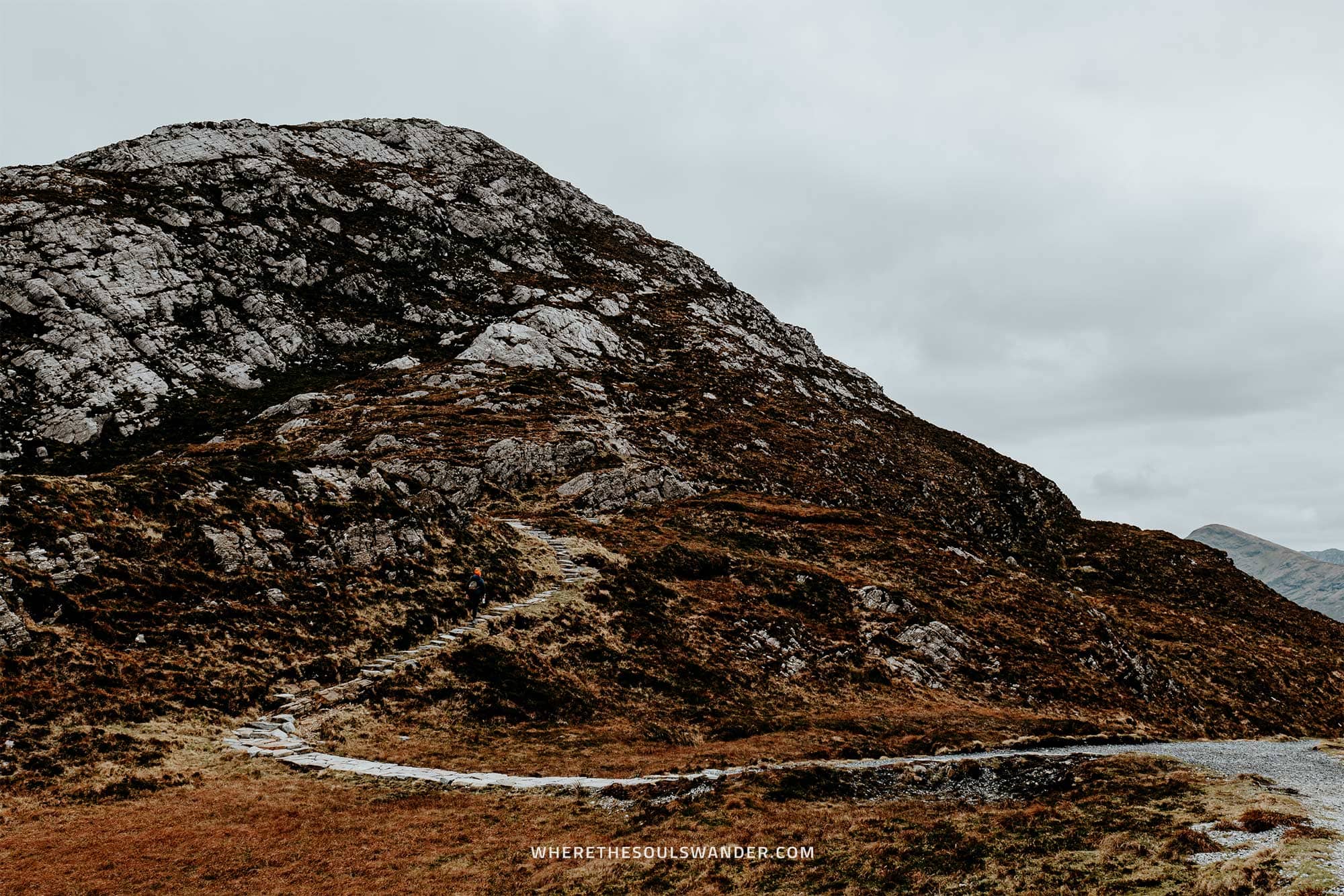
How to wrap up the Diamond Hill trail
After taking a short lunch break while taking in the incredible views from the top of Diamond Hill, it’s time to continue the hike.
Since the Diamond Hill trail is a loop walk, it’s pretty straightforward to get back to the visitors centre with a clear paved path down the backside of the hill.
Once you’ve finished the descent, the trail flattens out and takes you back to the visitors centre in Letterfrack in about 3,5 kilometres.
While this section of the hike sounds like a quick go-to-your-car route, it actually offers some insane views of the Atlantic, as well as the encircling surroundings.
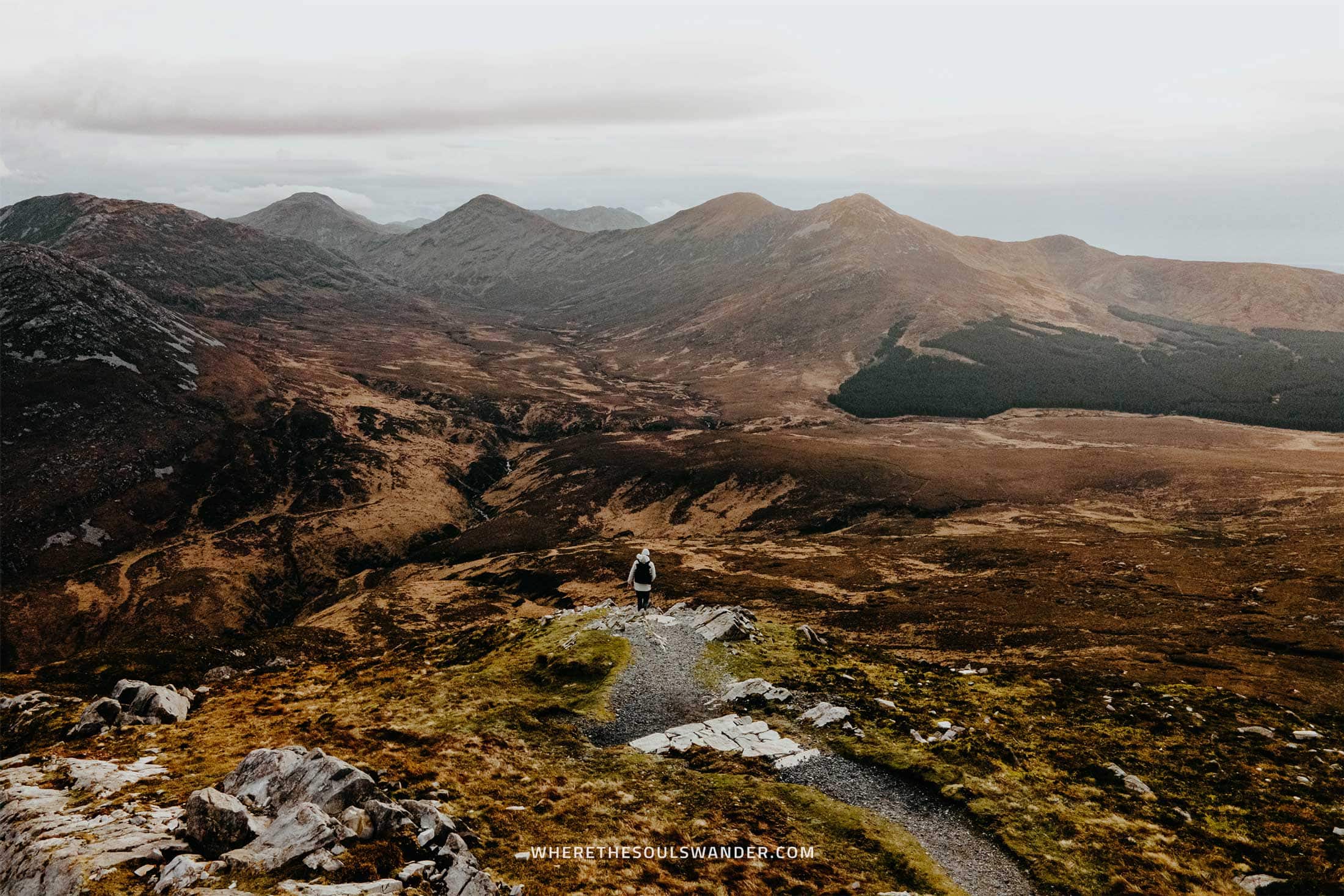
Where to stay near Connemara National Park
While visiting the Connemara National Park is an absolute must, there isn’t necessarily much else to do near the park.
For that reason, the Connemara National Park is best visited as part of a road trip through Ireland, meaning I’d recommend basing yourself in one of the region’s more popular cities of Galway or Westport, depending on the direction of your road trip itinerary.
To help you find the right accommodation, I’ve listed two excellent options per city below;
Galway
The Continental Boutique Residence | An excellent hotel suitable for solo travellers and families alike. Rooms are modern, clean and spacious, and are equipt with all the necessities. Continental Boutique Residence is also located only a stone’s throw away from the Galway city centre, which makes it one of the best budget-friendly picks in Galway.
The Lane – Boutique Residence | Another excellent budget-friendly option, the Lane – Boutique Residence is situated in the heart of Galway at only a 2-minute walk from Eyre Square. With spacious boutique-style rooms, comfortable double beds and a private bathroom with rainshower, this hotel is an excellent value for the money.
Westport
Westport Country Lodge Hotel | Situated in the historic village of Aughagower, at 5 minutes drive from Westport, this hotel combines elegant design with modern-day luxury and comfort. Doubles starting at only €81,- per night makes this one of the best options nearby Connemara.
The Wyatt Hotel | This excellent hotel is set within the heart of Westport and offers stylish and comfortable rooms, as well as free access to the Westport Leisure Park where you can use the swimming pool, hot tub and sauna. So, if you’re after a tad more comfort, look no further.
Best time of day to visit the Connemara National Park
Though you could visit the Connemara National Park at any time of day, I’d highly recommend visiting in the morning, especially if you’re planning to hike up to the summit of Diamond Hill.
As with any hike, the best time to start is usually about an hour before the sun rises.
I hiked Diamond Hill in Connemara in the morning and arrived at the summit just before the sun enlightened the Twelve Bens range in the distance – it was magnificent.
If you’re not quite an early bird, don’t worry, the Connemara National Park is also perfectly suitable for an afternoon visit.
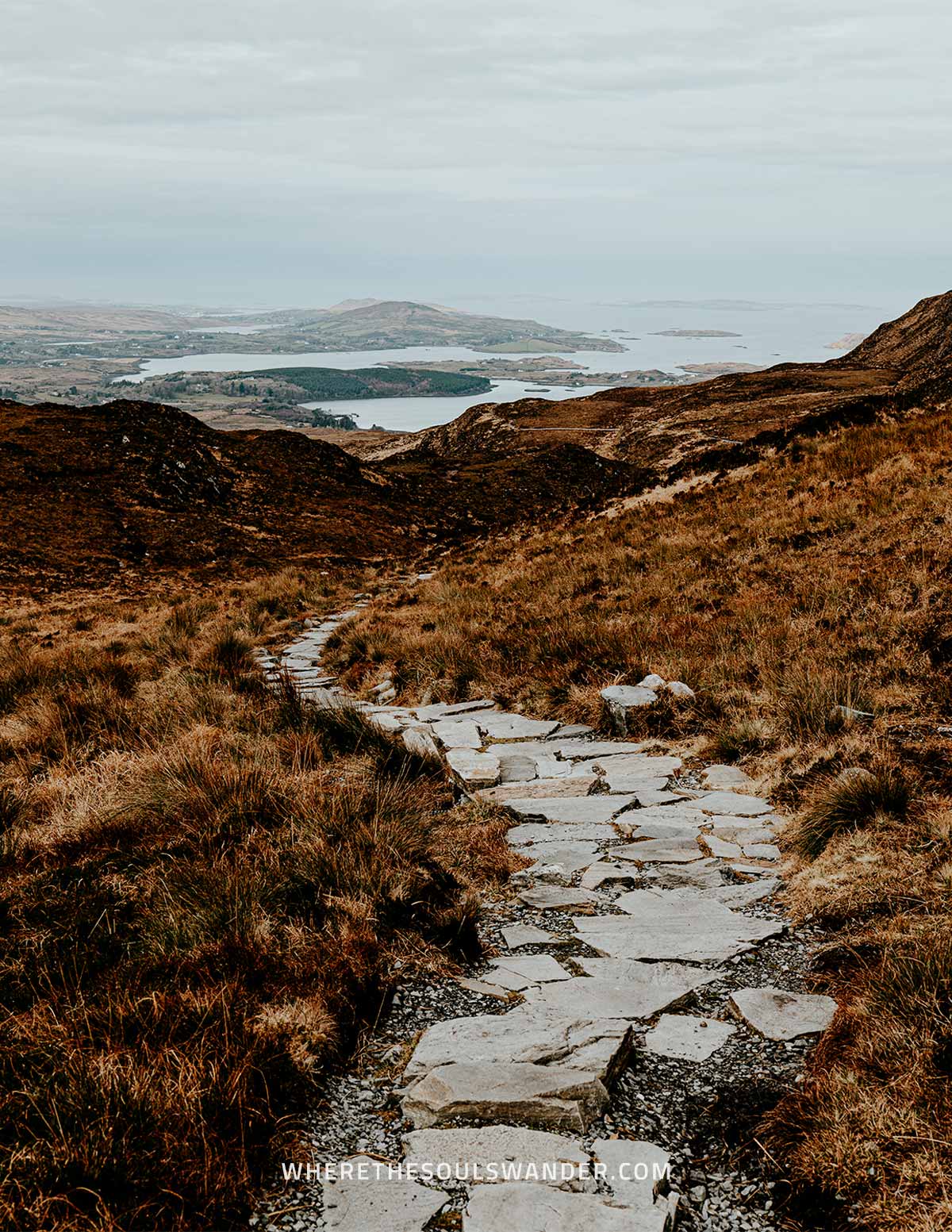

Best time of year to visit the Connemara National Park
This one is rather tricky/though, given the weather conditions tend to change relatively quickly in Ireland, meaning all four seasons could occur in one day, no matter the time of year.
Having said that, I believe the best time to visit the Connemara National Park is from May to Augustus, when the weather is great and the days lengthy for explorations around the park.
Additionally, opt for the shoulder months of March to May or September to November. During this time it’s significantly less crowded in comparison to the peak summer months, but still comfortable enough to do the hike to the summit of Diamond Hill.
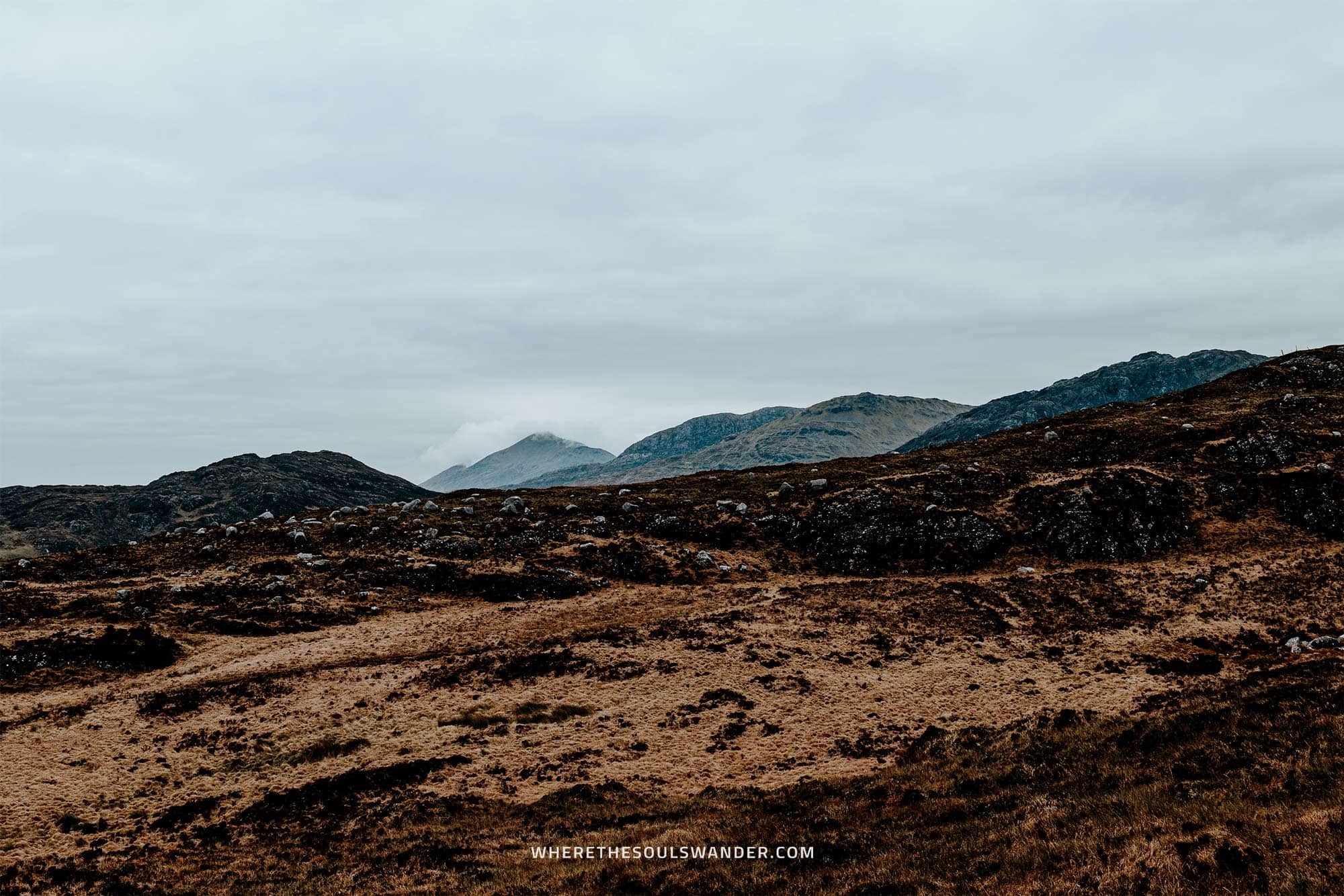
What to pack for the Connemara National Park hike
Before you start the Diamond Hill trail in the Connemara National Park, I believe it’s essential that you’re well prepared. For that reason, I’d highly suggest bringing the following equipment:
A REUSABLE WATER BOTTLE | One travel item that I carry with me at all times is the Grayl Geopress. This reusable water purification bottle allows me to fill up water from almost every water source, which makes it one of my best investments to date.
HIKING BOOTS OR A GOOD PAIR OF SNEAKERS | While hiking boots definitely provide more stability to your ankles, I believe you could easily hike Diamond Hill Connemara in a good pair of sneakers – just be sure that they have a firm sole with enough grip, so you’re supported when things get slippery.
LAYERS | Since the weather in Ireland is rather unpredictable, wearing layers is essential. While I had excellent weather during my visit, my hoodie and raincoat weren’t an unnecessary luxury, especially at the windy summit of Diamond Hill.
SNACKS | Whilst you can buy snacks and drinks at the Connemara Visitors Centre, I’d highly recommend bringing some fruits, nuts and protein bars to fuel yourself during the hike. Additionally, take enough cash to grab a coffee or a few snacks after the hike.
HIKING POLES | I did the Diamond Hill hike without hiking poles, but if you have weaker knees or prefer a little support during the more ascents and descents of the trail, I’d highly advise bringing a set of quality hiking poles. These Montem Ultra Strong Hiking Poles are light, collapsible, and a great value for the price.
CAMERA GEAR | If you’re into photography like me, don’t mind bringing your camera gear, as the Connemara National Park offers some of the best scenery in the region. I was glad to bring my drone with me, and captured some stunning shots – PS, see what’s in my camera bag.

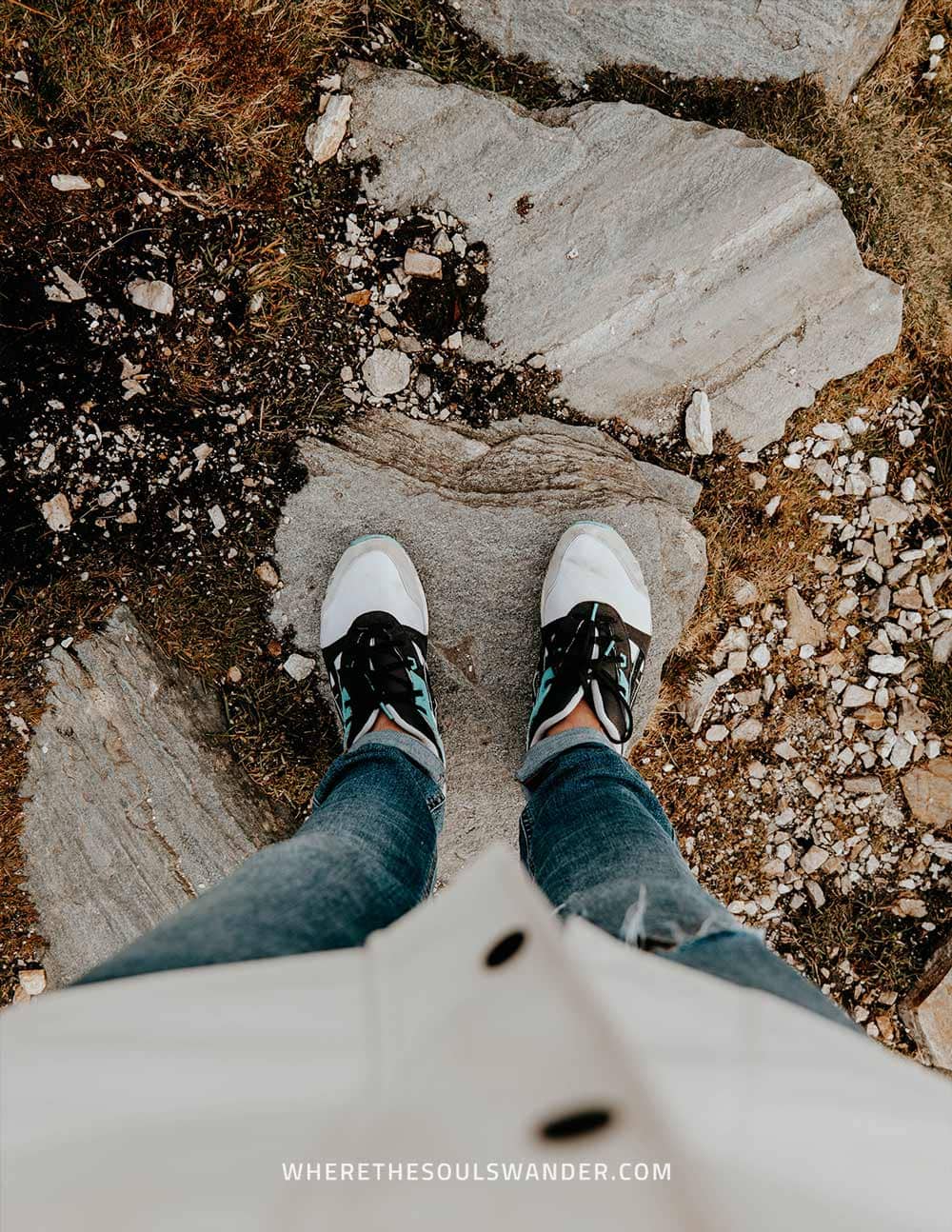
SAFETY IN IRELAND | TRAVEL INSURANCE
Since travelling in Ireland is all about the outdoors, I recommend everyone to sort out good travel insurance before setting out on their own road trip adventure.
Where we prefer that everything goes smoothly during our travels, something unfortunate can happen at any moment, whether it’s an injury during a hike, a stolen camera, or an accident on the road.
For travel insurance, I use Heymondo, as they offer full covid-19 coverage, as well as a handy app with 24-hour medical assistance. Make sure you check it out – readers of WTSW receive 5% off any insurance policy too. Additionally, I also recommend World Nomads.
PLAN YOUR IRELAND ITINERARY WITH THESE ESSENTIAL GUIDES
8 Wonderful things to do in Korcula, Croatia
With over a thousand islands, most travellers to Croatia find it a hard time deciding which island to visit, resulting that they often skip over some of the best, including Korcula.
I’m here to make sure Korcula ends up as one of the destinations in your Croatia itinerary.
In my opinion, Korcula Town is one the most authentic, and underrated places in Croatia, and therefore not to be missed.
The historic fortified town of Korcula is often referred to as one of the best-preserved medieval towns in the Mediterranean, and trust me, that’s for an excellent reason.
From the incredible Korcula land Gate to the winding alleyways of the old town, the intriguing ornate St. Mark’s Cathedral, to the alleged birth house of famous world traveller Marco Polo, this small yet incredible town sure knows how to charm and captivate.
Here’s my guide to Korcula, including the best things to do in Korcula, where to stay, when to visit, and how to get there, as well as essential information and tips that help you make the most out of your time here.
Love my photos? I’ve just launched my first ever print collection – receive 15% discount until the 1st of September using code; PRINT.
WHERE TO STAY IN KORCULA TOWN
There’s a whole myriad of excellent accommodation in Korcula Town, including luxurious hotels, homey apartments, and budget-friendly hostels, fitting any budget and travel style.
+ White House Apartments | Nestled in the lively streets of Korcula old town, White House Apartments offers a unique and authentic setting, while also providing superb comfort. The room comes with an excellent bed, air-conditioning, a private bathroom, and a kitchen with a washing machine – perfect for either short or long stays.
B&B Ghetto | Situated just outside Korcula Town is B&B Ghetto, a spacious apartment that provides comfortable beds, air-conditioning, and an excellent private bathroom. On top of that, it is fairly priced, as well as close to most of the interesting things to see and do in Korcula.
Alternatively, search for accommodations in Korcula Town on booking.com.
8 UNIQUE THINGS TO DO IN KORCULA TOWN
1 | ADMIRE THE VELIKI REVELIN TOWER | KORCULA LAND GATE
It is often said that Korcula is among the best-preserved medieval towns in Croatia, and the old town’s picture-perfect main entrance surely adds to this noteworthy reputation.
Dating back as far as the 14th century, the Veliki Revelin Tower is a medieval construction with an adjacent staircase, that is presently used as the town’s main entrance.
At first, the old town of Korcula was entered via a wooden drawbridge, before it was upgraded in the midst of the 18th century to the exquisite staircase we walk today.
Entering the old town from here is among the best things to do in Korcula, as it provides authentic, medieval feels – plus it makes an excellent backdrop for your next Instagram post.
• • •
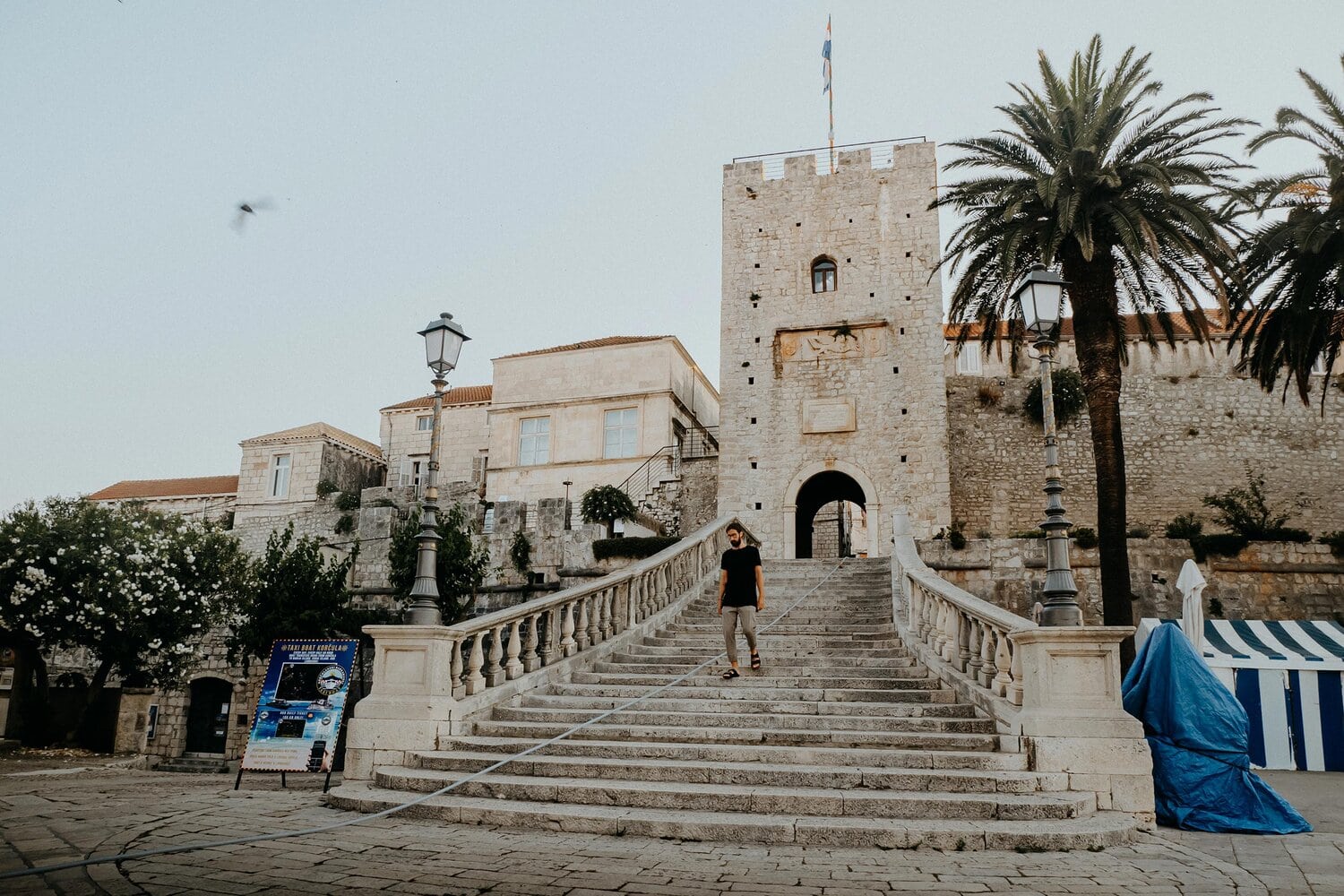
2 | VISIT THE MARCO POLO HOUSE
Although we’ll never know for sure, local legend has it that famous world traveller Marco Polo was actually born in the coastal town of Korcula, Croatia.
Given his exceptional reputation, it is little wonder that the Korcula locals embrace this (alternative) story with a large amount of pride.
Situated in the vibrant streets of Korcula Town lies a small, yet charming house that is alleged to be the birth house of Marco Polo, one of the best explorers the world has ever seen.
At present, the house is open to visitors, though it’s probably far from its old grandeur.
Recently, the Korcula Town Authority bought the rights to the property, with a clear mission to restore the building to its former glory, as well as turning it into the Museum of Marco Polo.
Honestly, I believe the Marco Polo House is not worth the entrance fee at the moment of writing (August 2020), but I do see that it has great potential in the near future.
If you do however plan to go inside, make sure to visit the loggia on top.
Additionally, you could visit the Marco Polo Museum just outside Korcula Old Town, costing 75 HRK (€10,-) per person.
• • •
Where | Marco Polo House, Korcula Town
Opening hours | Daily 11:00 – 21:00
Cost | 20 HRK (€2,65) per person
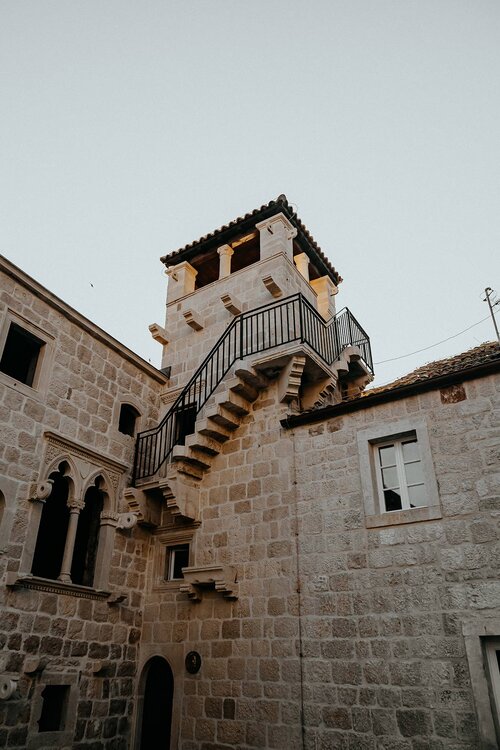
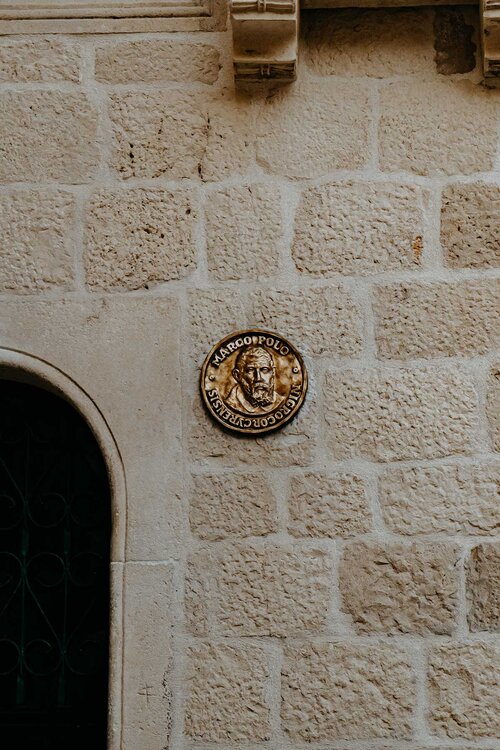
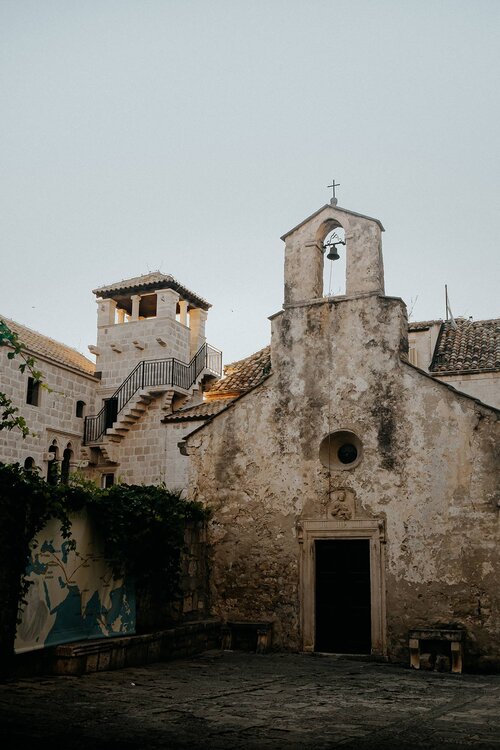
3 | SPEND A DAY AT ONE OF THE KORCULA BEACHES
It’s not only medieval splendour that characterizes Korcula Old Town.
No, Korcula is in fact home to a great selection of incredible beaches and awesome swimming spots sprinkled around the neighbouring coastline.
Whether you’re after a quiet stretch of pebble beach, a local town beach, or a dock to lay down your towel, before taking a dive in the refreshing waters of the Adriatic, Korcula has you covered.
Some of my favourite Korcula beaches include:
BEACH ISPOD DUVANA
At only a 10-minute walk from Korcula Old Town lies Ispod Duvana, a picture-perfect stretch of beach that is without a doubt my favourite beach in Korcula.
As soon as you lay down your towel, you’ll be welcomed by the most iconic view of Korcula Old Town. The view genuinely gave me goosebumps, even though it was 34 degrees.
On top of that, this quiet stretch of pebble beach offers easy access to the Adriatic, making it an excellent place for an afternoon of swimming and relaxing.
• • •
Where | Beach Ispod Duvana, Korcula
ZAKERJAN BEACH
Located on the eastern edge of the old town, Zakerjan Beach is among the oldest swimming spots in Korcula and is popular with travellers and locals alike.
Zakerjan beach offers a small pebble cove, concrete platforms as well as a number of ladders and steps that provide easy access to the sea.
All this makes Zakerjan Beach the perfect spot for those wanting to stay close to their accommodation, while also having the possibility of enjoying the Mediterranean sun and sea.
• • •
Where | Zakerjan Beach, Korcula
BANJE BEACH
Considered the oldest beach in town, Banje Beach is a small pebble beach situated in the Borak area, roughly 15-minutes east of the old town.
The cove around Banje Beach is also home to a couple of excellent restaurants serving food and refreshments, making it perfect for families.
However, Banje Beach is one of the most popular local beaches near Korcula Town, and therefore more crowded than the aforementioned beaches, especially during the summer months.
• • •
Where | Banje Beach, Korcula
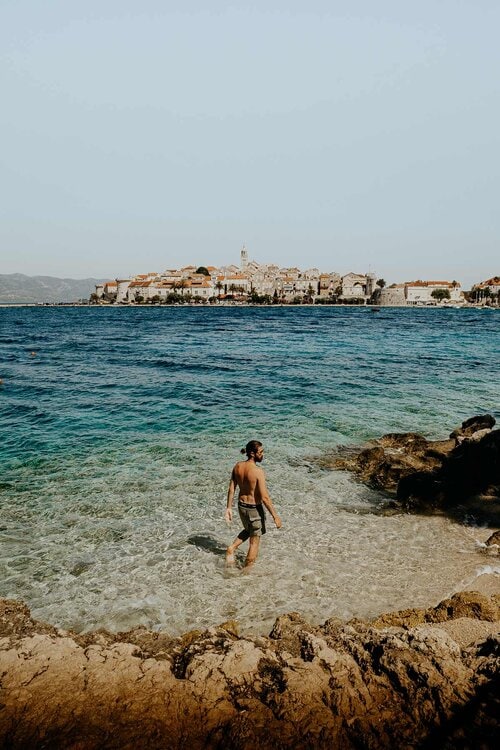
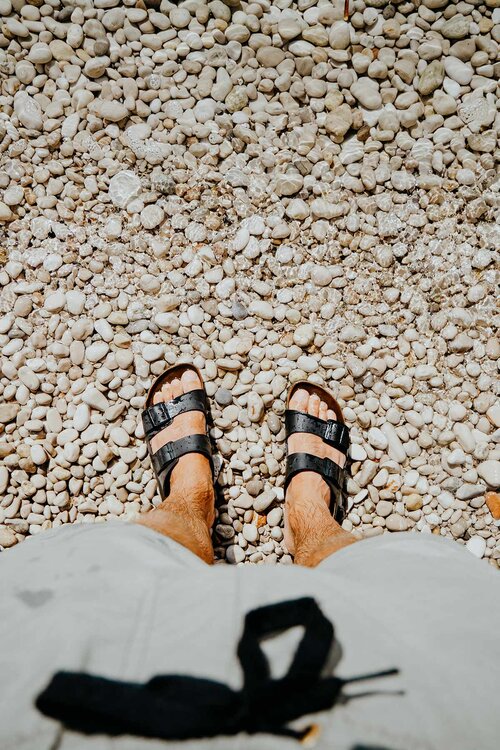
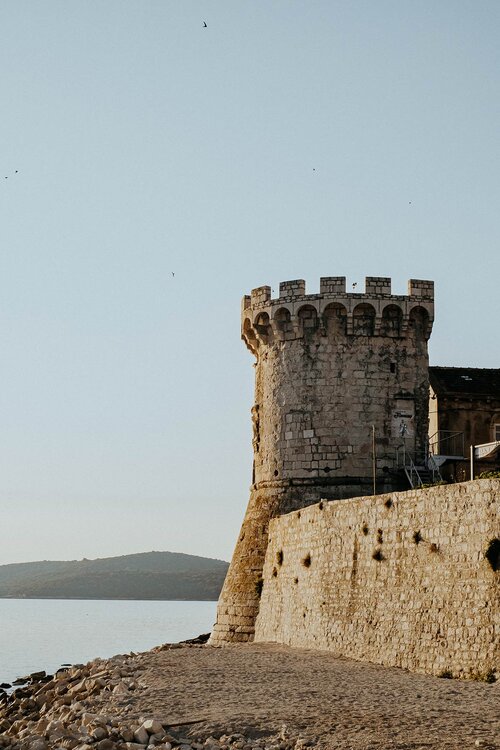
4 | SAMPLE DELICIOUS PASTRY AT AURORA SWEETS
If you’re a seasoned sweet tooth after a mouth-watering treat, I’m pretty sure this little gem is the recommendation you were waiting for.
Tucked away in one of Korcula’s charming alleyways lies Aurora Sweets, a small bakery that serves a great selection of cakes, cookies, and desserts, as well as excellent coffee and nourishing smoothies & bowls.
If it wasn’t for my decision to walk the old town one more time before leaving for Dubrovnik, I would have never stumbled upon this cosy dessert cafe, which would have been a disaster.
But fortunately, I did.
After a short chat with the friendly lady behind the counter, I selected the Shrek Mint pastry, an excellent cake that was perfectly crafted around the subtle, yet refreshing flavour of mint.
However, what I liked most, and why I would go back, is the fact that most of their pastries are based on natural ingredients, resulting in a great array of vegan, refined sugar and gluten-free options.
• • •
Where | Aurora Sweets, Korcula Town
Opening hours | Daily 09:00 – 21:00
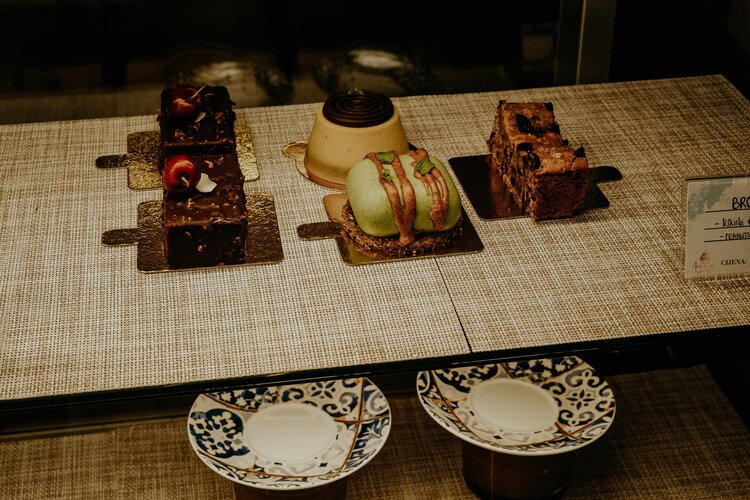
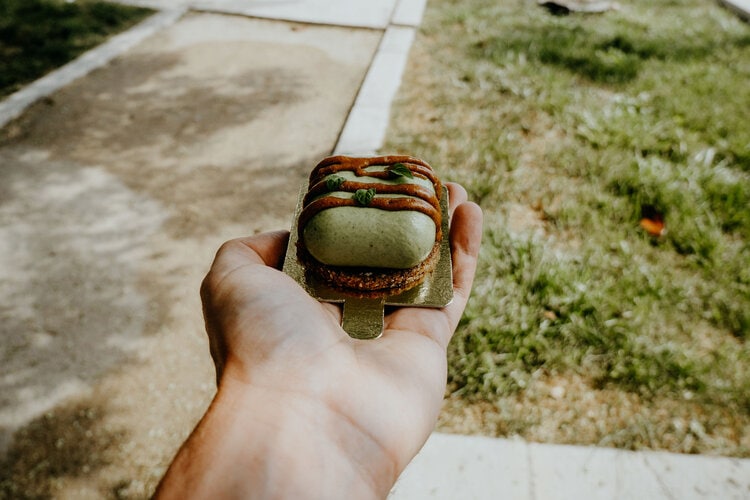
5 | GET LOST IN THE LANEWAYS OF KORCULA OLD TOWN
Said to be one of the best-preserved medieval towns in the Mediterranean is Korcula old town, a small coastal town that is easily among the most attractive town’s I’ve ever set foot in.
Korcula old town is, in fact, picture-perfect as if lifted straight from a traditional romantic movie.
For that reason, the best thing to do in Korcula is simply wandering through the town’s narrow cobblestone laneways, whilst taking in the beautifully elegant architecture.
Honestly, walking here felt as though I’d stepped back in time.
If you’re after an even better experience, make sure to walk the streets during sunrise, when there’s barely anyone awake, and the rustic buildings reflect the day’s first rays of sunlight.
One word, mesmerizing!
Although I spend only a day in Korcula, I wouldn’t mind spending a whole week, getting lost in Korcula Old Town’s enchanting little laneways.
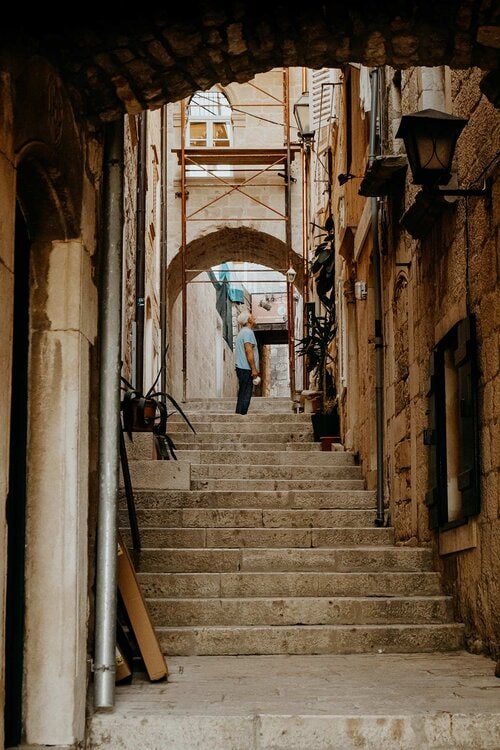
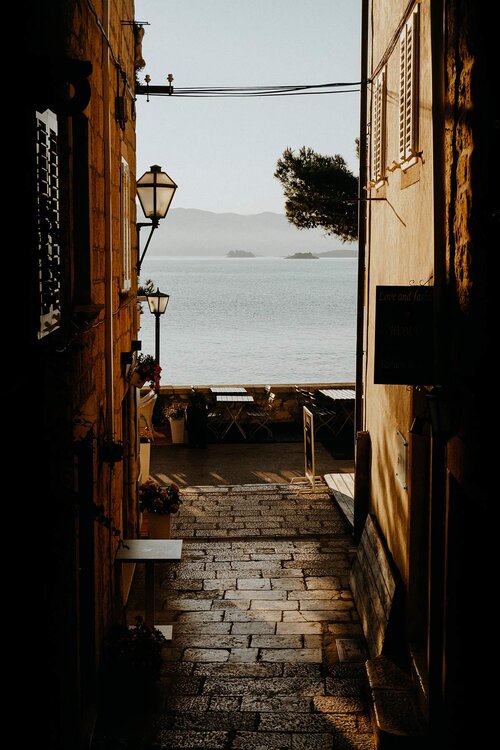
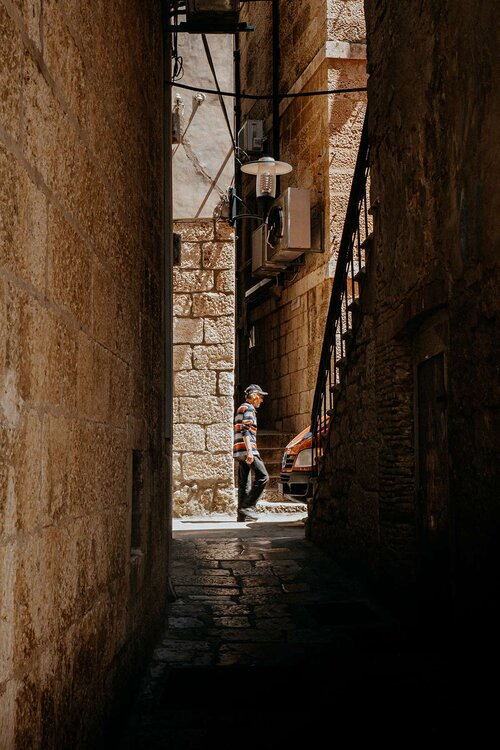
6 | VISIT THE ST. MARK’S CATHEDRAL
Situated on a small square in the heart of Korcula Town is the majestic St. Mark’s Cathedral, a towering construction that is charmed by its locally obtained limestone, intriguing details, and ornate Gothic-Renaissance style.
When the building was built in the 15th century (on top of an older church), both local and Italian artisans, gave significant importance to the cathedral’s facade, which if you ask me, is easily reflected in the church’s baroque details and sculptures.
But it wasn’t just the outside that left me in awe.
Inside, the cathedral has an elevated ceiling, a colonnade that is made by exquisite limestone pillars, as well as a handful of exceptional artworks, including a bronze statue of St Blaise, and a notable painting in the ‘Three Saints’.
If you’re keen on going to higher grounds, make sure you visit the belltower as well. Due to the church’s strategic position (highest point of Korcula Town), it provides the most stunning views of both Korcula and the Adriatic Sea.
• • •
Where | St. Mark’s Cathedral, Korcula Town
Opening hours | Daily from 09:00 – 21:00
Entrance fee | 10 HRK (€1,33) per person
Entrance Belltower | 25 HRK (€3,32) per person
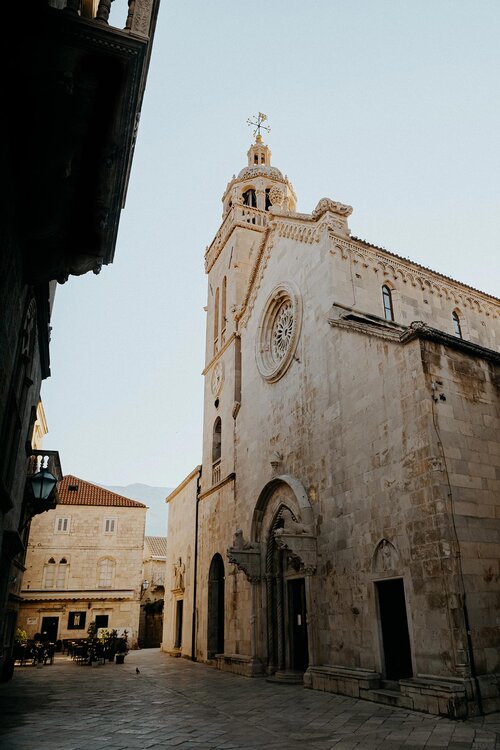
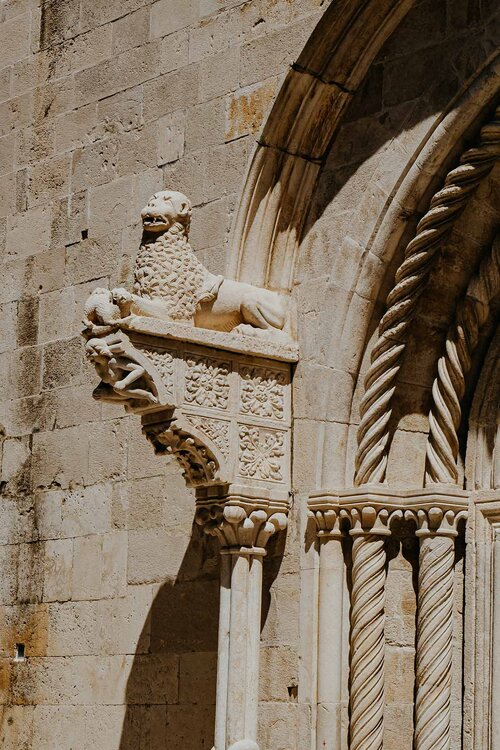
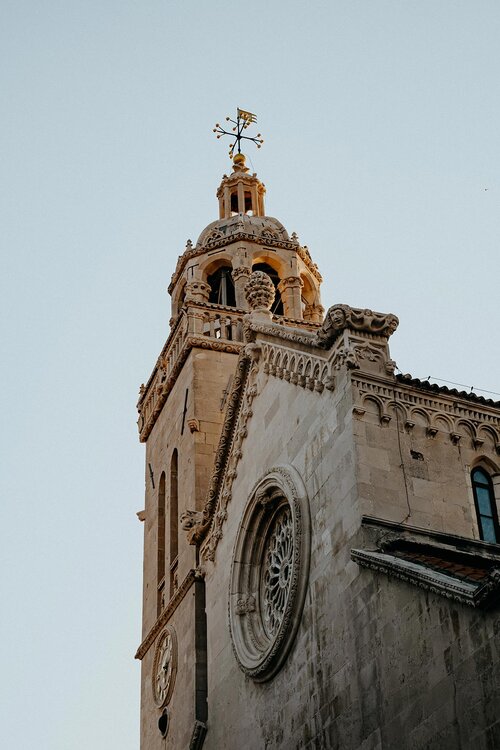
7 | WALK THE SEASIDE PROMENADE OF PUT SVETOG NIKOLE
Just west of Korcula Town lies Put Svetog Nikole, a palm tree-lined promenade that is hands down my favourite place to escape the sizzling Mediterranean heat in Korcula.
During the summer months, both locals and travellers enjoy going here for a lazy afternoon of swimming, relaxing, and tanning.
To me, that’s no surprise.
Along the entire promenade, you’ll find easily accessible swimming spots, mainly in the form of docks and concrete platforms, mostly providing ladders to enter the sea.
On top of that, there is Ispod Duvana, an excellent beach where you’ll easily find yourself chilling away an afternoon (or two) – so don’t forget to bring a good book.
But it is only when your afternoon of relaxing is over that the real charm comes to attention.
When walking back in the direction of Korcula, you’ll be welcomed by the most iconic view of both Korcula Old Town and the stunning Adriatic in the distance.
• • •
Where | Put Svetog Nikole
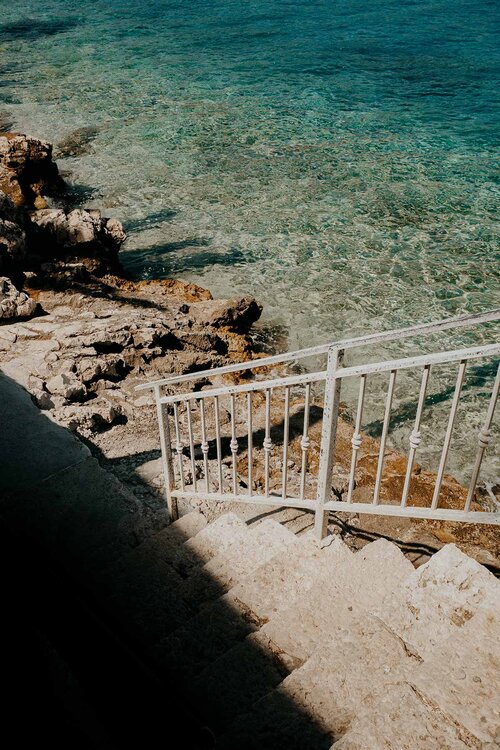
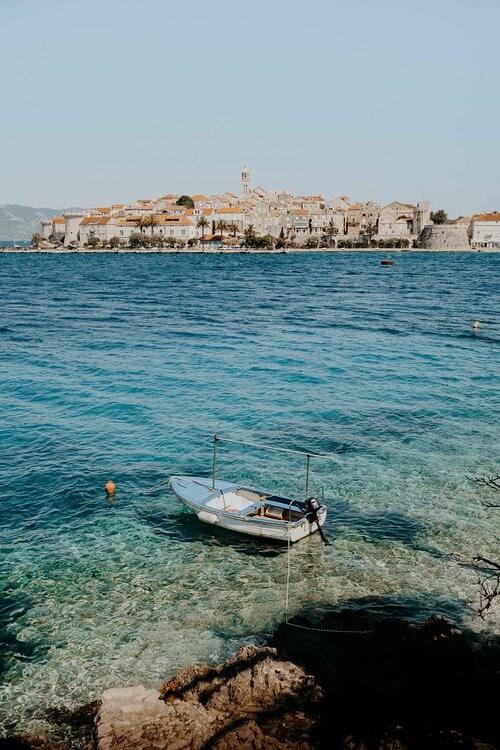
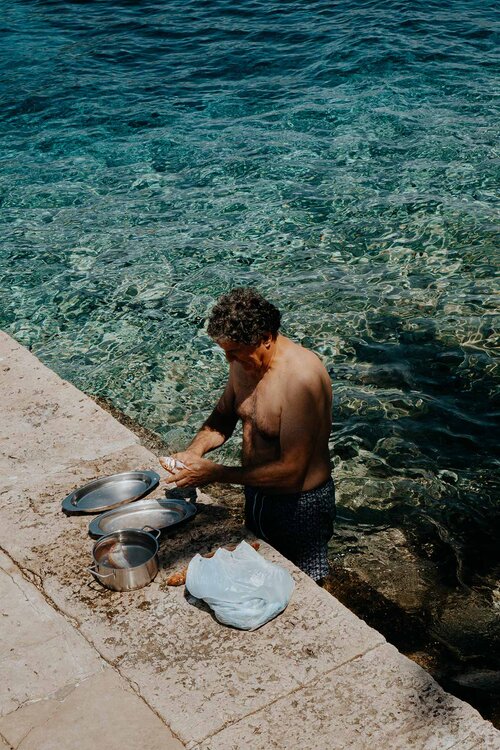
8 | DISCOVER THE KORCULA ARCHIPELAGO
Similar to the neighbouring island of Hvar, Korcula is home to an impressive group of islands, dotted throughout the Adriatic.
Charmed by 18 quaint islands, the Korcula Archipelago has clearly no shortage of pristine beaches and coves, that are ideal if you’re after swimming, relaxing and activities on the water.
The largest and best-known of these islands is Badija, an island that is known for its 14th-century Franciscan Monastery, fallow deers, and an array of excellent beaches and swimming spots.
Other great islands that are worth visiting include Vrnik and Stupet. These 3 islands, as well as Lumbarda, are easily accessible by using the water taxi or hop-on-hop-off speedy that departs from the main harbour in Korcula old town.
If you’re keen to go off the beaten path and explore the smaller, more secluded islands & islets, make sure to rent a small boat. Do bear in mind that you need a license to operate a motorboat in Korcula.
No license, no problem. Alternatively, there is the option to rent a boat including a skipper.
• • •
Where | Korcula Archipelago
Cost boat rental | Starting at 400 HRK (€54,-) | Including a skipper 800 HRK (€108,-)
Cost Hop on Hop Off | 200 HRK (€27,-) for a day ticket, book here
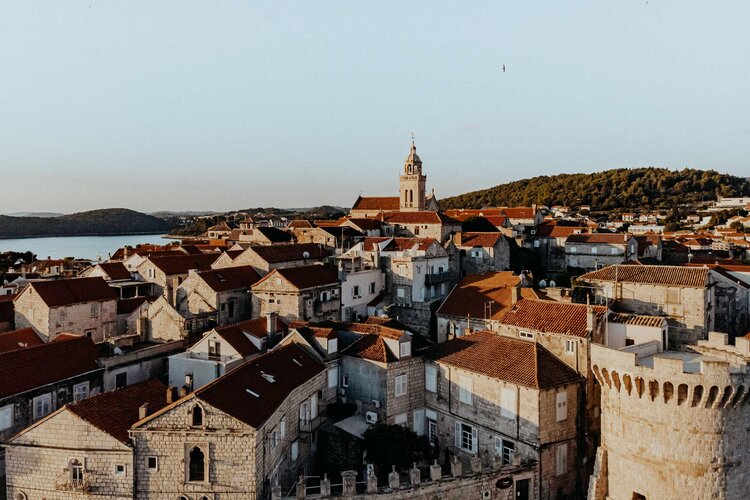
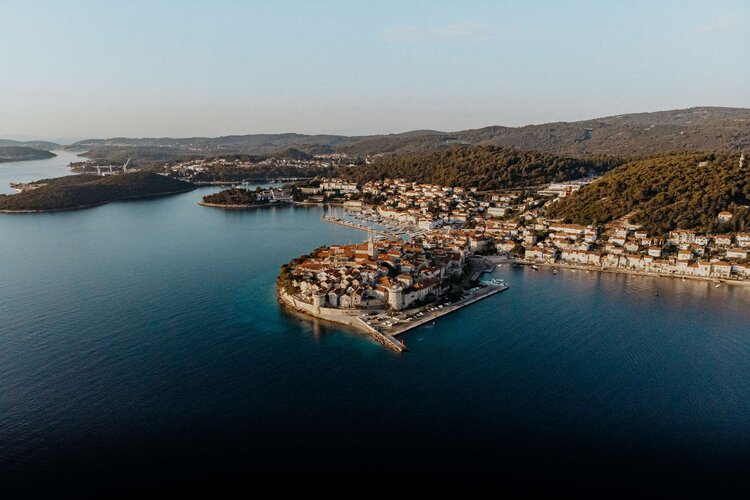
WEATHER IN KORCULA | BEST TIME TO VISIT KORCULA
Like most islands in the Mediterranean, Korcula enjoys great weather year-round. Accordingly, the summers are hot and lengthy, with July and August as the hottest months.
Personally, I think that the best time to visit Korcula is just outside those peak months, when temperatures are excellent, yet bearable, providing the best circumstances to explore Korcula and surrounds.
These shoulder months run from April to June and from September to October.
During these periods, the days are long, there is little to no rainfall, as well as smaller crowds and slightly cheaper prices, which is always a good thing right?
MY FAVOURITE DAY TOURS & ACTIVITIES ON KORCULA ISLAND
If you’re after an organized tour to discover Korcula and surrounds, here are some of my personal favourites.
HOW TO GET TO KORCULA TOWN
If you’re keen to visit the charming island of Korcula, you’ll have to step aboard of one of the ferries that operate between Split, Brac, Hvar, Korcula, Mjilnet and Dubrovnik.
There are two companies that service the islands, one for foot passengers only – Krilo, and one for both car and foot passengers – Jadrolinija.
The ferry services are among the best I’ve ever used, and operate the area frequently throughout the day – plus they are pretty affordable, comfortable, as well as strictly on time.
Both operators offer excellent services, and tickets are easily booked online or at the ticket booth in the harbour.
I would recommend booking your tickets in advance, especially during the busy summer months.
HOW TO GET FROM SPLIT TO KORCULA
The ferry from Split to Korcula departs from the first pier at the main harbour in Split and the journey takes roughly 2 and a half hours.
Make sure that you’re at the right terminal by checking the number that is indicated at the dock. If you’re not completely certain, don’t mind asking the ticket vendor.
Where | Split Ferry Port
Cost Split to Korcula ferry | 140 HRK (€18,50) one way
Travel time | Approximately 2 hours and 15 minutes
Split to Korcula ferry departure times | Daily 07:40 and 17:00
HOW TO GET FROM HVAR TOWN TO KORCULA
Hvar Town is basically built around its picturesque main harbour, therefore it’s pretty straightforward to find your departing ferry to Korcula.
As soon as you boarded the ferry, sit down, take it easy, and enjoy the epic sceneries along the way. The journey takes roughly 1 hour and 20 minutes.
Where | Harbour of Hvar
Cost Hvar Town to Korcula ferry | 110 HRK (€14,55) one way
Travel time | Roughly 1 hour and 20 minutes
Hvar Town to Korcula ferry departure times | Daily 08:50 and 18:10
HOW TO GET FROM DUBROVNIK TO KORCULA
If you’re after a trip to Korcula from Dubrovnik, you’ll have to go to the Dubrovnik ferry port, situated in Gruz, a neighbourhood at roughly 25-minutes of Dubrovnik Old Town.
Make your way to the ferry port by jumping aboard a local bus that leaves for Gruz from the Pile gate. Bus lines that operate this area include no 1a, no 1b, and 3. More information on the Dubrovnik bus lines here.
As soon as you leave Dubrovnik, it should take around 2 hours to reach Korcula.
One thing you should take into account is the fact that this route is operated exclusively by Krilo, and departs only once daily at 16:30.
Where | Dubrovnik Ferry Port
Cost Dubrovnik to Korcula ferry | 140 HRK (€18,50) one way
Travel time | Around 2 hours
Dubrovnik to Korcula ferry departure times | Once daily at 16:30
SAFETY IN CROATIA | TRAVEL INSURANCE
While Croatia is completely safe for travellers, I always aim to enter a foreign country with my travel insurance sorted out, and I highly advise anyone else to do the same.
Where we prefer to assume that everything runs smoothly during our travels, the reality is often that something can go wrong at any given moment – when that happens, it is better to be safe than sorry.
Heymondo | Whether you’re going on a 3-week backpacking trip, or planning a long stay somewhere abroad, Heymondo has excellent insurance options either way – plus full covid-19 coverage and a handy app with 24-hour medical assistance. Readers of WTSW receive 5% off any insurance policy, more information here.
World Nomads | If you’re an adventure seeker, backpacker, or planning your once-in-a-lifetime world trip, make sure you check out World Nomads, they designed the perfect travel insurance to help you travel safer and smarter. Do note that they’re not covering covid-19 related claims.
PLAN YOUR CROATIA ITINERARY WITH THESE ESSENTIAL GUIDES
A traveller's guide to Budapest, Hungary’s spirited capital city
Looking for things to do when spending a weekend in Budapest?
My guide to the best things to do in Budapest provides insightful travel tips, including where to eat, where to stay and what to see in Hungary’s charming capital city.
In the midst of our typical Dutch winter, we, once again, felt the strong desire to explore a new city. One thing led to another, and before we knew we were boarding a plane to Hungary’s vibrant capital city, Budapest.
Once arrived, Budapest’s unique character instantly fulfilled our desire.
Budapest is a creative and spirited city that combines trendy restaurants & cafes with authentic architecture and rich history.
From the famous thermal baths to its characteristic ruin bars, the capital city has something unique to do and discover for everyone – plus it’s relatively affordable.
To us, it’s surprising that Budapest is somehow, quite an underestimated city in Europe.
So if you’re seeking for a vibrant city break in Europe, Budapest will certainly pique your interest.
Here’s our traveller’s guide to spending a brilliant weekend in Budapest.
HOW TO GET AROUND BUDAPEST
It is surprisingly straightforward to explore Budapest on foot, and it is a great way to discover the city’s lively streets and buzzing districts.
However, we think for a city break, the distances between tourist highlights, can be quite extensive, therefore we believe it’s worth checking out the Budapest Card, which will basically be your key to the city.
The Budapest Card was designed to reduce expenses for travellers visiting Budapest. The card provides access to the city’s public transport, discount on top attractions (including the thermal baths) and grants free access to 19 highly regarded museums.
Depending on the length of your stay, the card is available for between 1-5 days.
Book | Reap the benefits and grab yourself a Budapest Card in advance
A TRAVELLER’S GUIDE TO BUDAPEST | 23 THINGS TO SEE AND DO
1 | ADMIRE BUDAPEST’S STUNNING CHAIN BRIDGE
Besides the undisputed fact that it was the first permanent bridge that connected the districts Buda and Pest, it genuinely is an iconic piece of architecture to both Budapest and Hungary.
Back in 1849, when the Chain Bridge opened, it was among the largest in the world and therefore entitled as one of the wonders of the world during that time.
Unfortunately, the bridge was unable to cope with the German explosions during the Siege of Budapest in World War II. With great luck, the towers remained unscathed, which eventually initiated a reconstruction of the Chain Bridge in 1949.
Nowadays, it is unlikely to get bored by the captivating bridge. We ourselves crossed it numerous times while switching between Buda and Pest, and were intrigued by the architecture again and again.
ESSENTIALS
Where | The Chain Bridge
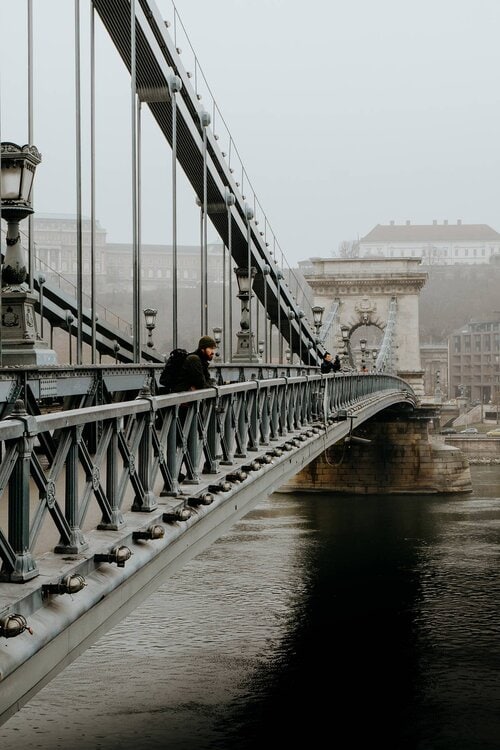
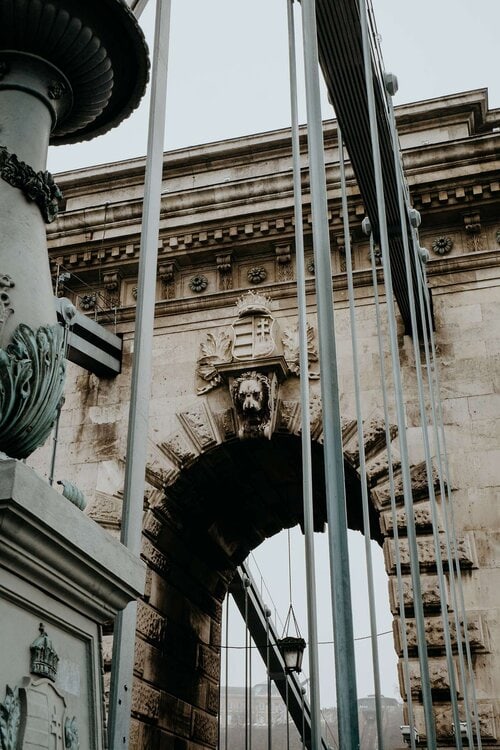
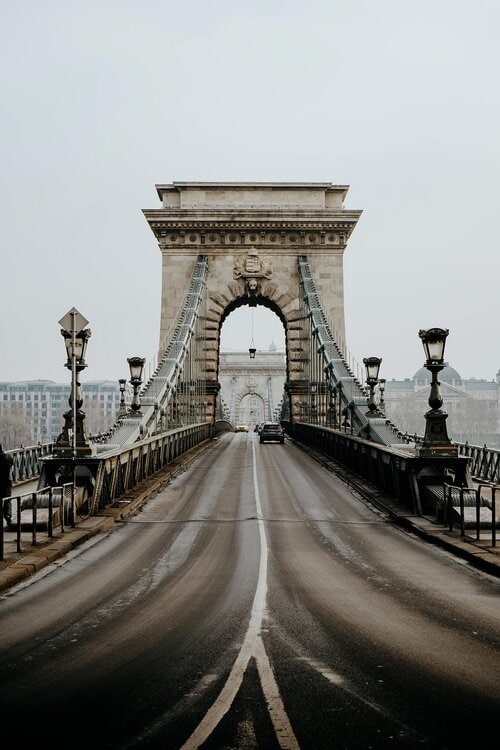
2 | WALK THE FISHERMAN’S BASTION
Established on the hill side of Budapest is the magnificently designed Fisherman’s Bastion.
With its breathtaking panoramic views over the entire city and its fairytale-like architecture, we quickly realized why it is one of the best known historical sites in Budapest.
Legend has it that the ornate Fisherman’s Bastion owes its name to a medieval guild of fishermen, who were held responsible for preserving this part of the city.
On the upper terrace, you’ll find seven Hogwarts-like turrets, which symbolize the seven Hungarian tribes that founded contemporary Hungary in 895.
To beat the massive crowds that pass the Fisherman’s Bastion from dusk till dawn, we recommend a visit well before opening time. Going outside the opening hours has one other significant benefit, it grants free access to the bastion’s upper terrace.
ESSENTIALS
Where | Fisherman’s Bastion
Entrance fee | 1.000 Hungarian Forint (€3,-) per person
Opening hours | Daily 09:00 – 23:00
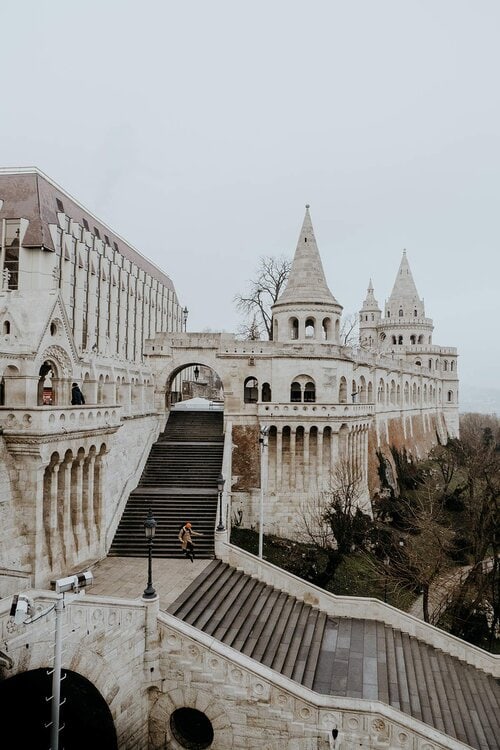
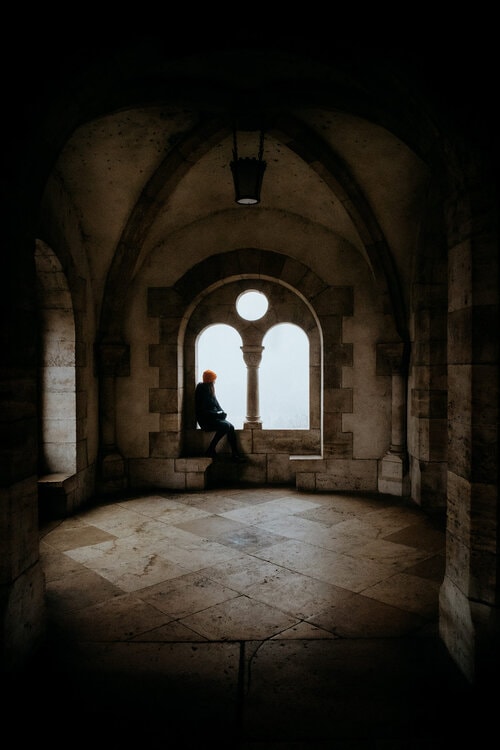
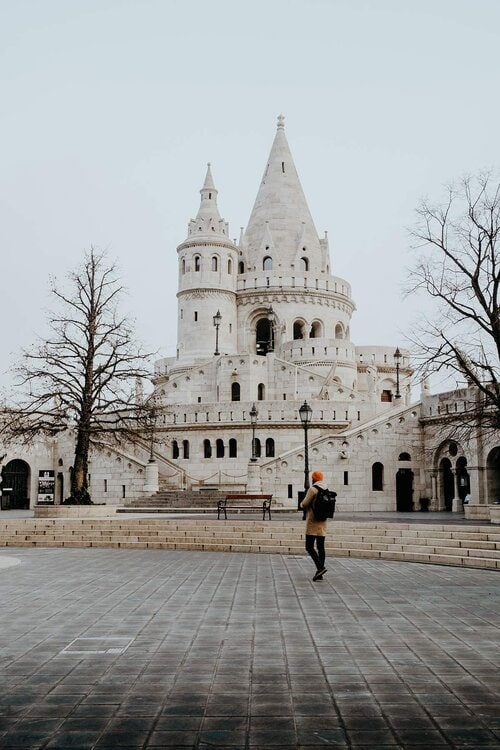
3 | MARVEL AT THE MATTHIAS CHURCH
One of Budapest’s finest churches is the towering Matthias Church, found directly after the aforementioned Fisherman’s Bastion in Budapest’s medieval castle district.
The splendour that characterizes the Matthias Church is largely acquired by the beautifully coloured roof tiles and its distinctive geometric patterns.
The florid late Gothic style church holds captivating stories from more than 700 years of history while also housing an impressive ecclesiastical art collection.
The interior of the church is defined by its ornate details and is decorated with fascinating frescoes, including pieces that respectively represents the Renaissance and Ottoman reign.
If you have enough time, we sincerely advise taking a look inside.
ESSENTIALS
Where | Matthias Church
Entrance fee | 1.000 Hungarian Forint (€3,-) per person
Opening hours | Monday to Saturday 09:00 – 17:00 and Sunday 13:00 – 17:00
Book | Guided Tour To The Matthias Church including Admission
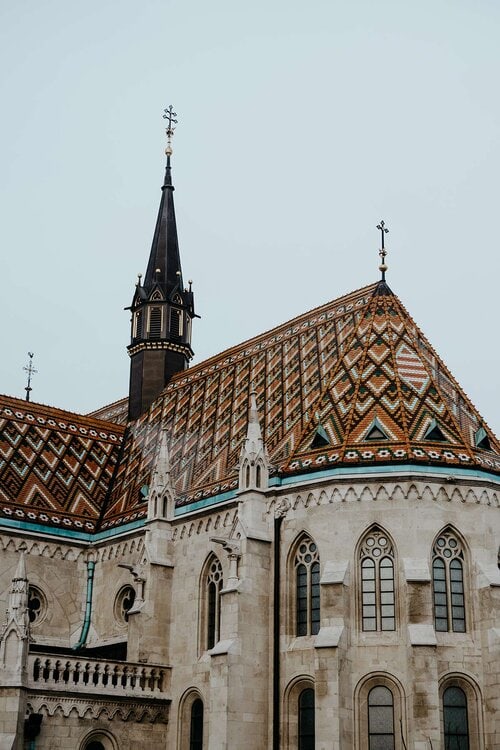
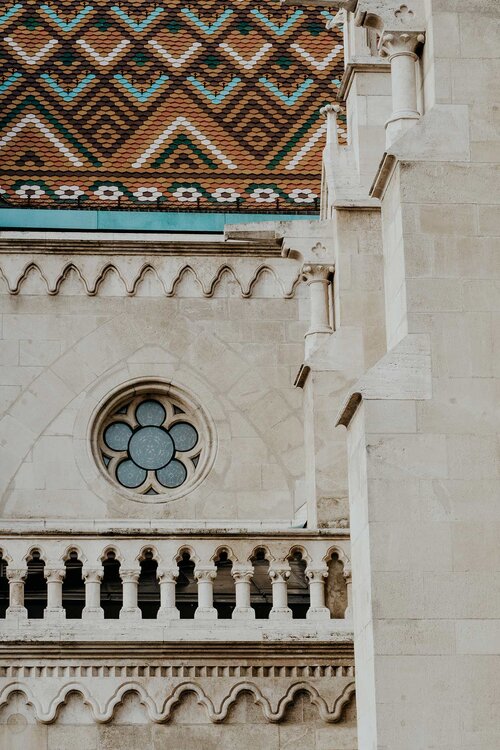
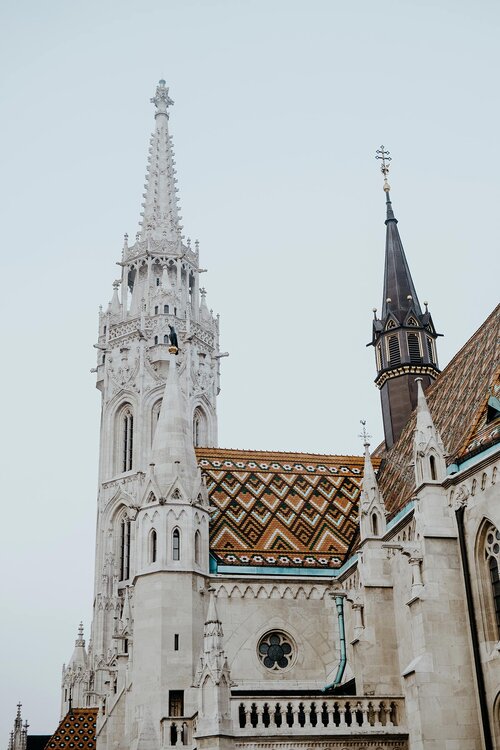
4 | HUNGARIAN PARLIAMENT BUILDING
Standing tall on the eastern shore of the Danube is the majestic Hungarian Parliament Building, that is often referred to as one of the most attractive government buildings in the world.
Although the Hungarian Assembly still gathers here regularly, the Parliament welcomes visitors that desire to admire the building’s impressive architecture and opulent interior.
The interior of the building is absolutely breathtaking; the ornate Dome Hall, marble-lined Grand Stairway and the Holy Crown of Hungary just to mention a few.
The only way to gain entrance to the Parliaments elegant interior is by joining a guided tour.
If you’re keen on joining a guided tour, we highly recommended to book your tour well in advance.
For those on a budget or tight schedule, the simple pleasure of roaming around the building is, without a doubt worthy of your time.
Therefore, we recommend to add it to your schedule of things to do in Budapest.
ESSENTIALS
Where | Parliament Building
Cost | Guided tours start at 5.400 Hungarian Forint (€16,-) per person
Opening hours | Monday to Friday 08:00 – 18:00 and Saturday to Sunday 08:00 – 16:00
Book | 45-Minute Guided Tour To The Budapest Parliament
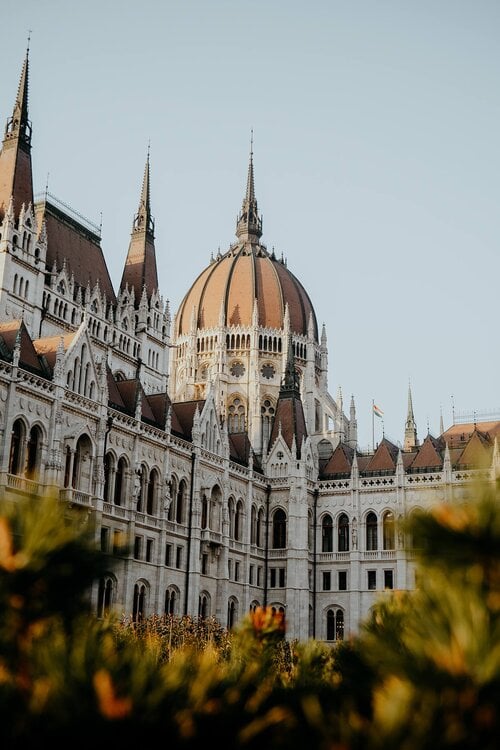
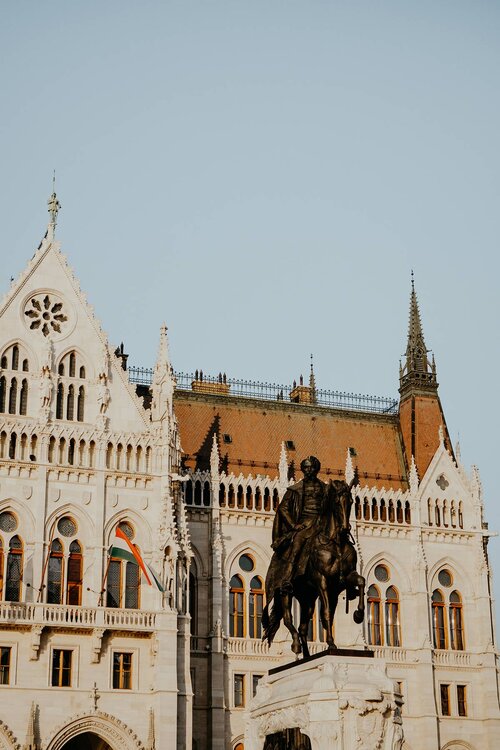
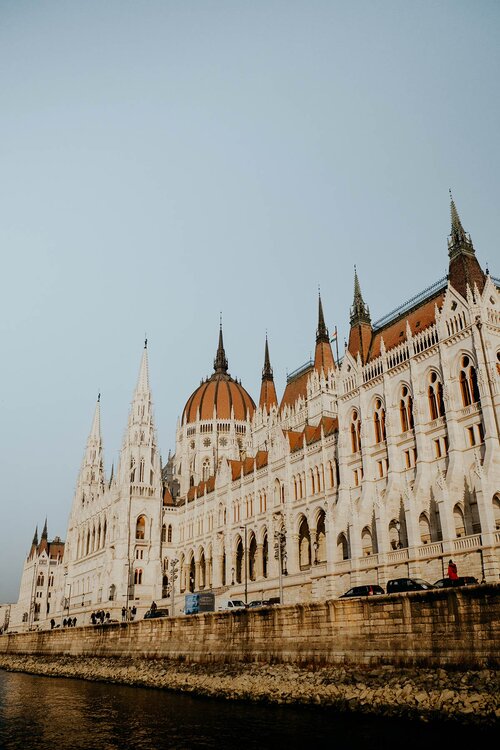
5 | SHOES ON THE DANUBE PROMENADE
For me, travelling is more than simply chasing beautiful destinations. I see it, in fact, as the perfect opportunity to learn, reflect and grow as a human being.
For that reason alone, I cannot emphasize it enough to pay a tribute to Budapest’s most touching monument.
On the banks of the Danube, you’ll find a memorial that reminds you of one of the most tragic events of the 20th-century, what therefore always remain a dark page in the history of mankind.
A trail of cast-iron shoes honours thousands of Jewish people that were forced to take off their shoes, before being executed during world war II.
Despite the cruel history that occurred along the riverbank, the sculptor succeeded to turn it into a serene place where people remember those who lost their lives.
ESSENTIALS
Where | Shoes on the Danube Promenade
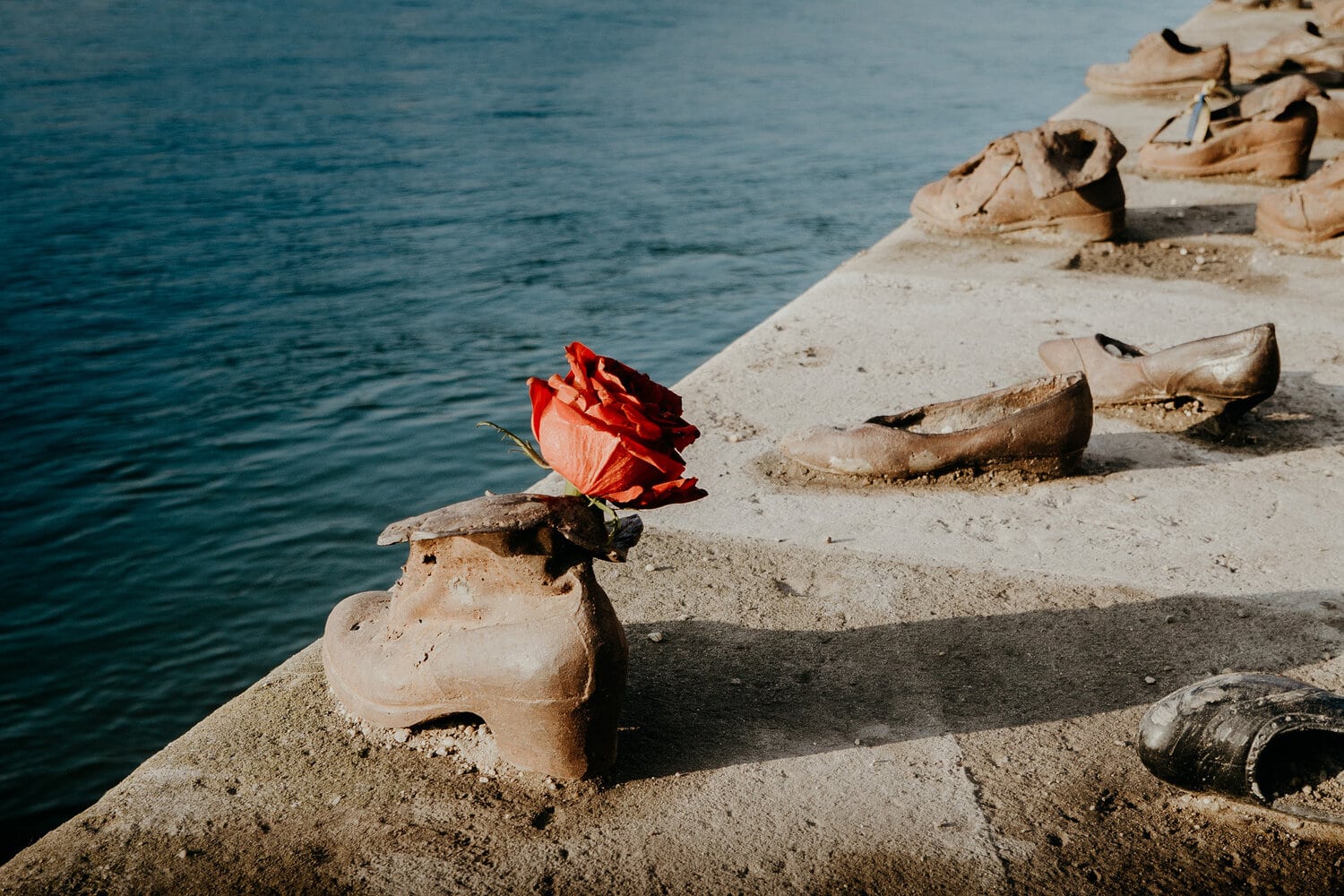
6 | ST. STEPHEN’S BASILICA
If you ask us, a trip to Budapest simply wouldn’t be complete without bringing a visit to Hungary’s most sacred Catholic church.
The St. Stephen’s Basilica is designed in Neo-Classical-Style and is incredibly impressive through the inside and out.
It is the panoramic view from the church’s central dome, its valuable mosaic artwork and detailed frescoes, that ensures it to be one of the most significant tourist attractions in Budapest.
The church’s central dome reaches a height of 96 metres, which is exactly the same as the Budapest Parliament Building.
The equivalence of these significant buildings symbolizes that worldly, religious, and spiritual thinking, have the same value in Hungary.
This specific height also sets the tone for other buildings in Budapest, as it manifested the rule that buildings cannot be built higher than the aforementioned structures.
ESSENTIALS
Where | St. Stephen’s Basilica
Entrance fee | Free, a donation of 200 Hungarian Forint (€0,60) is suggested at the entrance
Opening hours | Monday to Friday 09:00 – 17:00, Saturday 09:00 – 13:00 and Sunday 13:00 – 17:00
Book | St Stephen’s Basilica Tour with Tower Access

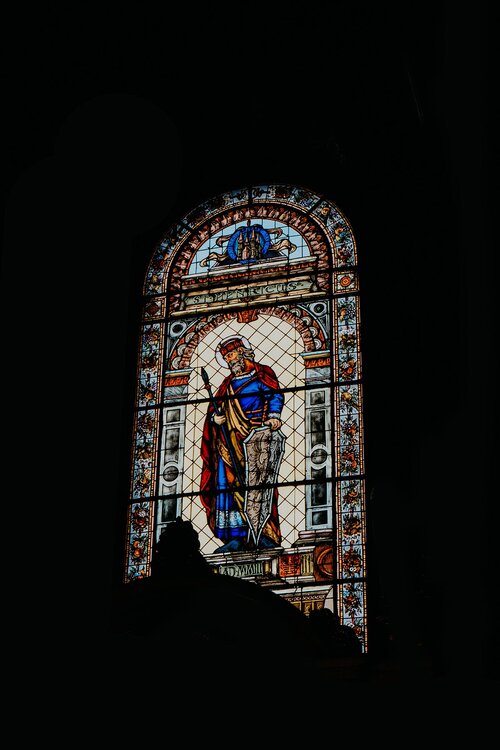
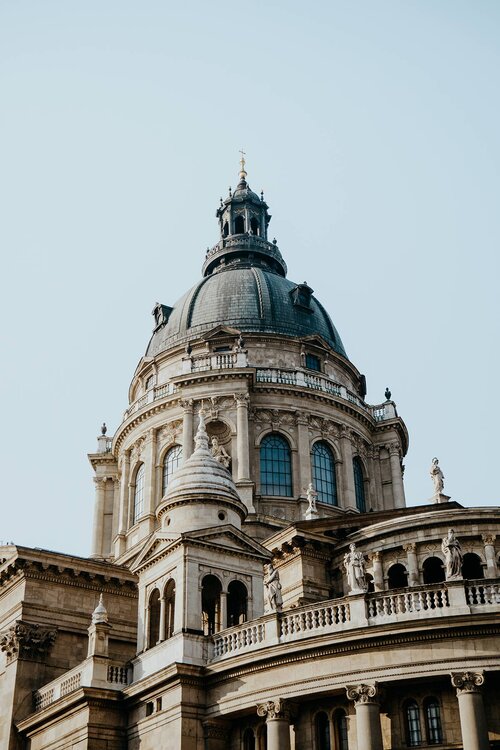
7 | TASTE MIDDLE EASTERN FLAVOURS AT MAZEL TOV BUDAPEST
Tucked away in the lively streets of the Jewish Quarter, awaits a serene courtyard that houses possibly the most trendy restaurant in Budapest.
Mazel Tov is an open-hearted Israeli restaurant, that serves creatively composed Middle Eastern fusion dishes, which if you tell us, are incredible yum.
We savoured a rich Yemen style chicken soup, spicy sweet potato wedges with green pesto tahini and a freshly cooked Shakshuka, and were positively surprised by the delicious and characteristic flavours.
Not to mention their smoothly mixed signature cocktail, the ‘Tel-Aviv Nights’, which is by far the most delicate cocktail Glenn drank so far.
Although Mazel Tov isn’t the traditional ruin bar you’ll expect in Budapest, it still houses the spirited atmosphere, and if you want to be sure of a table, we genuinely advise making a reservation in advance.
ESSENTIALS
Where | Mazel Tov Budapest
Opening hours | Monday to Wednesday 11:00 – 01:00, Thursday to Saturday 11:00 – 02:00 and Sunday 11:00 – 01:00
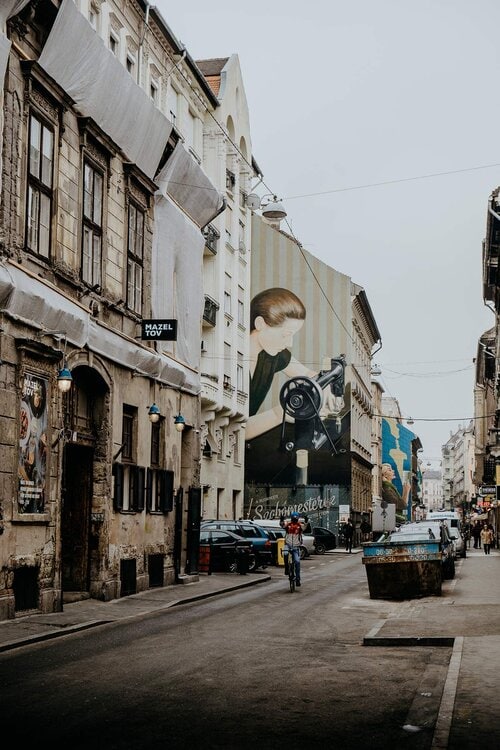

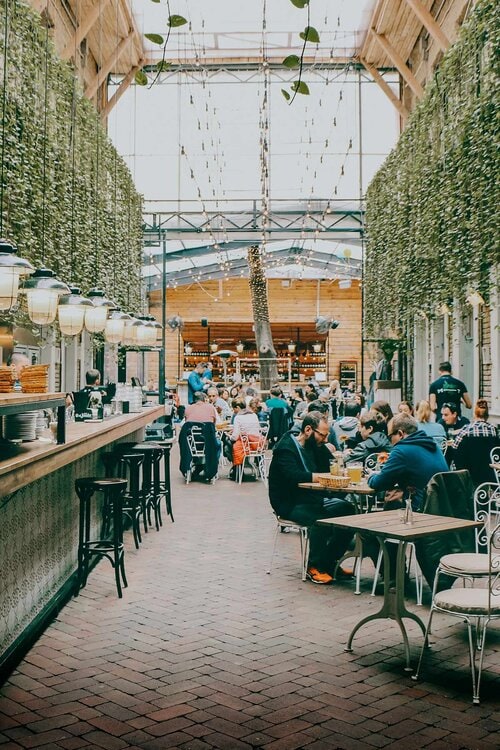
8 | UNWIND IN A THERMAL BATH
Budapest is often referred to as the ‘City of Baths’, which the city owes to the thermal baths that are fueled by approximately 120 natural hot springs.
Budapest’s rich bathing culture dates back as far as the 16th century, which is reflected in both the variety and abundance of mineral-rich thermal baths.
If you’re looking to unwind during your city break, there is no better way than a dip in one of the many mineral-rich thermal baths.
The best baths in Budapest include the Széchenyi, Rudas, Gellert, and Király baths, but there are more spread throughout the city.
ESSENTIALS
Book | Skip the Line: Széchenyi Spa Full-Day Entrance Pass
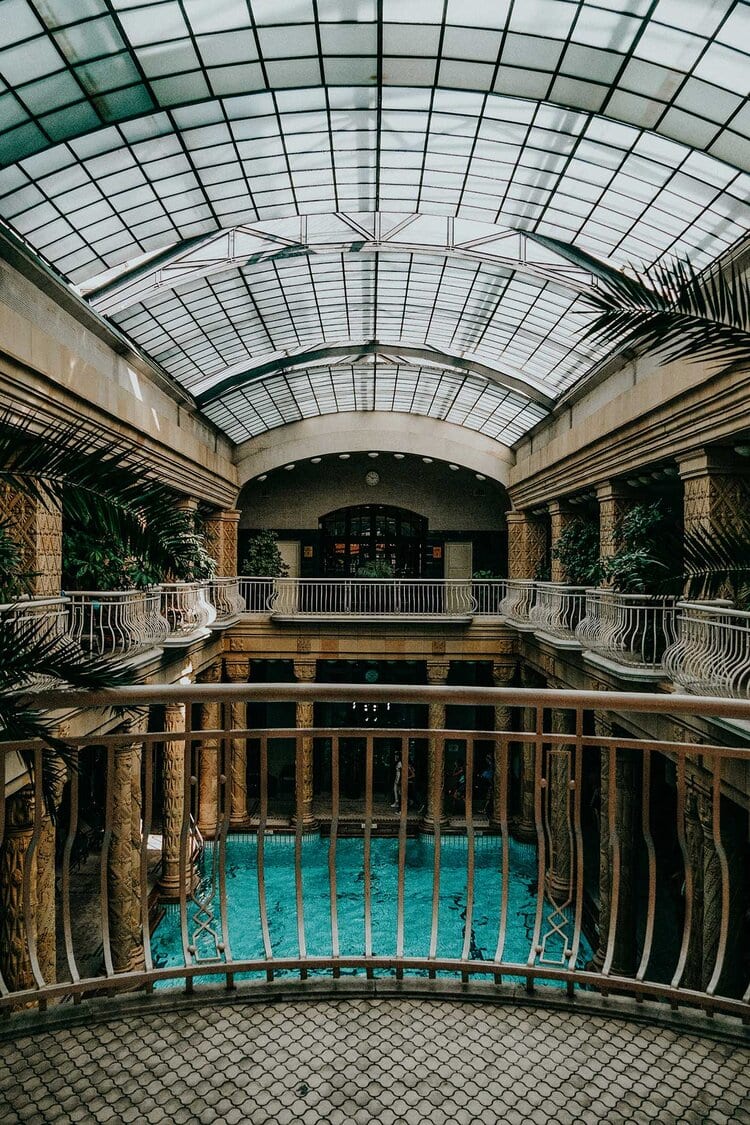
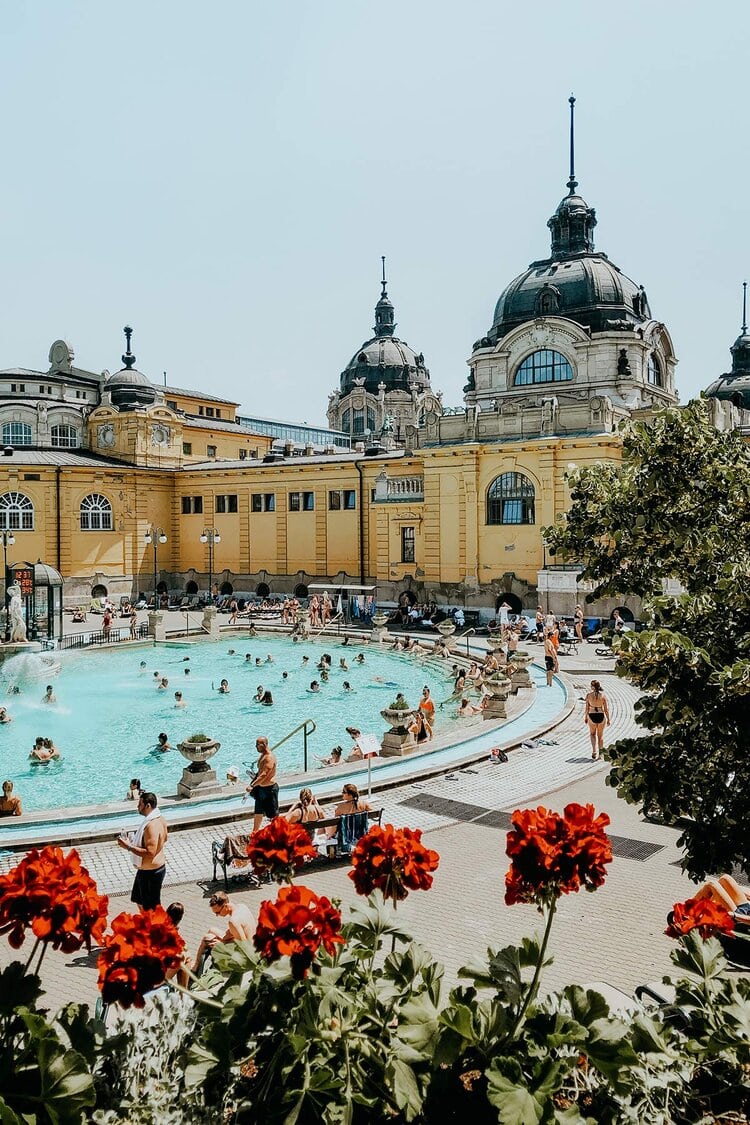
9 | WALK THE SZABADSÁG HÍD BRIDGE
The Szabadság Híd Bridge is the shortest bridge you’ll encounter in the city centre, and despite its size, we think the bridge is just as spectacular as its beloved brother, the Chain Bridge.
The marvellous bridge is designed in Art Nouveau style and was the first bridge that made it possible for trams to cross the Danube.
Present-day it connects two of Budapest’s well-known public squares, which are Gellért tér and Fővám tér. On these squares, you’ll respectively find Gellért Hill and the Great Market Hall.
Make sure you witness the yellow trams slowly crossing the Liberty Bridge – as it might results in one of the most iconic photographs of Budapest.
ESSENTIALS
Where | Szabadság Híd Bridge
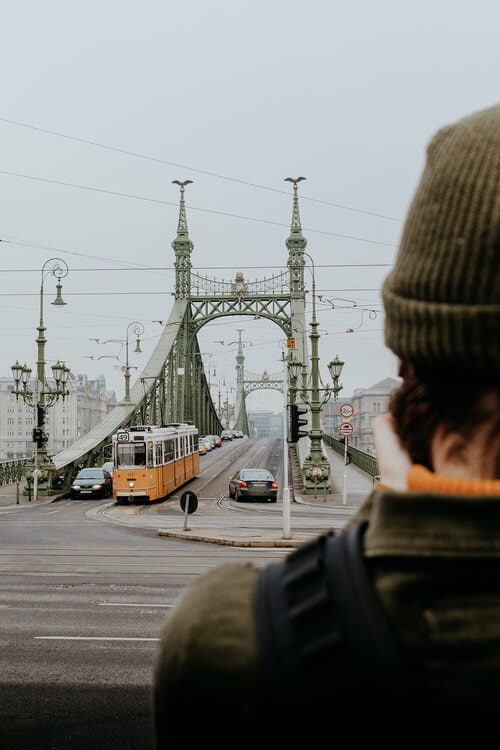
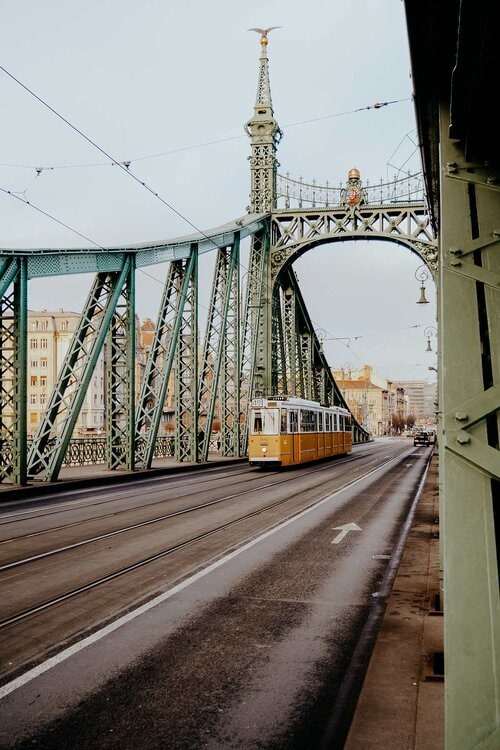
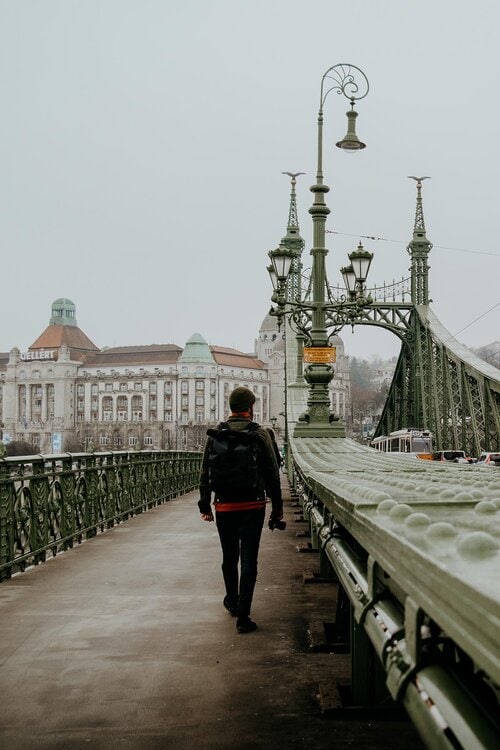
10 | STROLL THROUGH THE GREAT MARKET HALL
The Great Market Hall is a multi-story market that houses more than 100 perfectly aligned market stands, making it the largest indoor market in Budapest.
Even though the market is extremely popular among tourists, it somehow managed to preserve its authentic local atmosphere, which we think is quite charming.
While wandering around the market hall, you’ll notice a broad variety of locally grown produce such as fresh fruit, veggies, meat and traditional Hungarian delicacies – including lángos, Tokaj wines and Hungarian paprika.
On the upper section of the market, they sell handicrafts and typical souvenirs for prices specially designed for tourists, not our favourite part to be honest.
To us, the Great Market Hall is the perfect place to get a feel for the city and its folk.
ESSENTIALS
Where | Great Market Hall Budapest
Opening hours | Monday 06:00 – 17:00, Tuesday to Friday 06:00 – 18:00, Saturday 06:00 – 15:00, Sunday closed
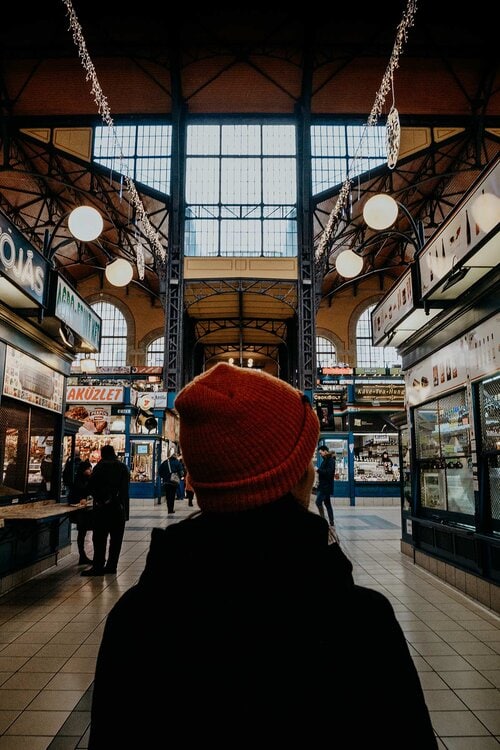
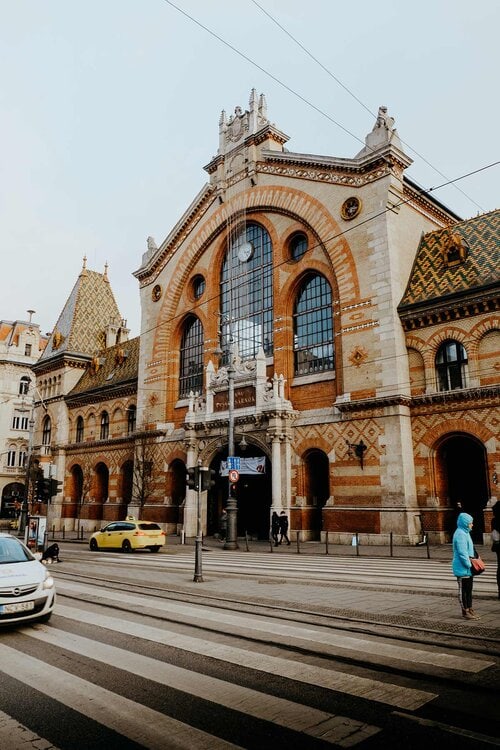
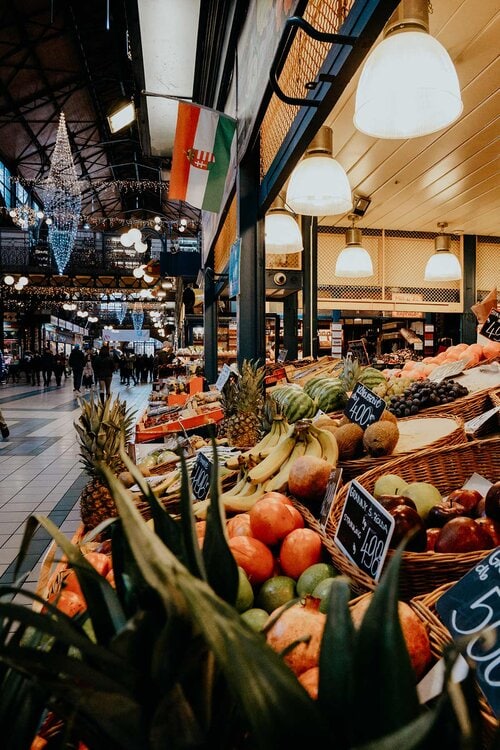
11 | MARVEL AT SZABÓ ERVIN LIBRARY
Although many information is published online these days, Budapest luckily still places significant value on its exceptional literature and elegant libraries.
The Szabó Ervin Library is said to be the most impressive library in Budapest, and after wandering among the bookshelves ourselves recently, we are safe to say it’s true.
Afore the Baroque building was transformed into Budapest’s largest public library, the building served as a private residence of the aristocratic Wenckheim family.
Since its opening in late 1931, the Szabó Ervin Library became of significant national importance and rose to become extremely popular among students, professors and academics.
The metropolitan library is still quite a hidden gem to those that travel to Budapest, and not only literally, also figuratively.
We, accordingly, had a pretty tough time locating the libraries authentic and well-preserved reading rooms, but once we finally did, we were left mesmerised.
ESSENTIALS
Where | Erwin Szabo Library
Entrance fee | 1.500 Hungarian Forint (€4,5) per person
Opening hours | Monday to Friday 10:00 – 20:00, Saturday 10:00 – 16:00, Sunday closed
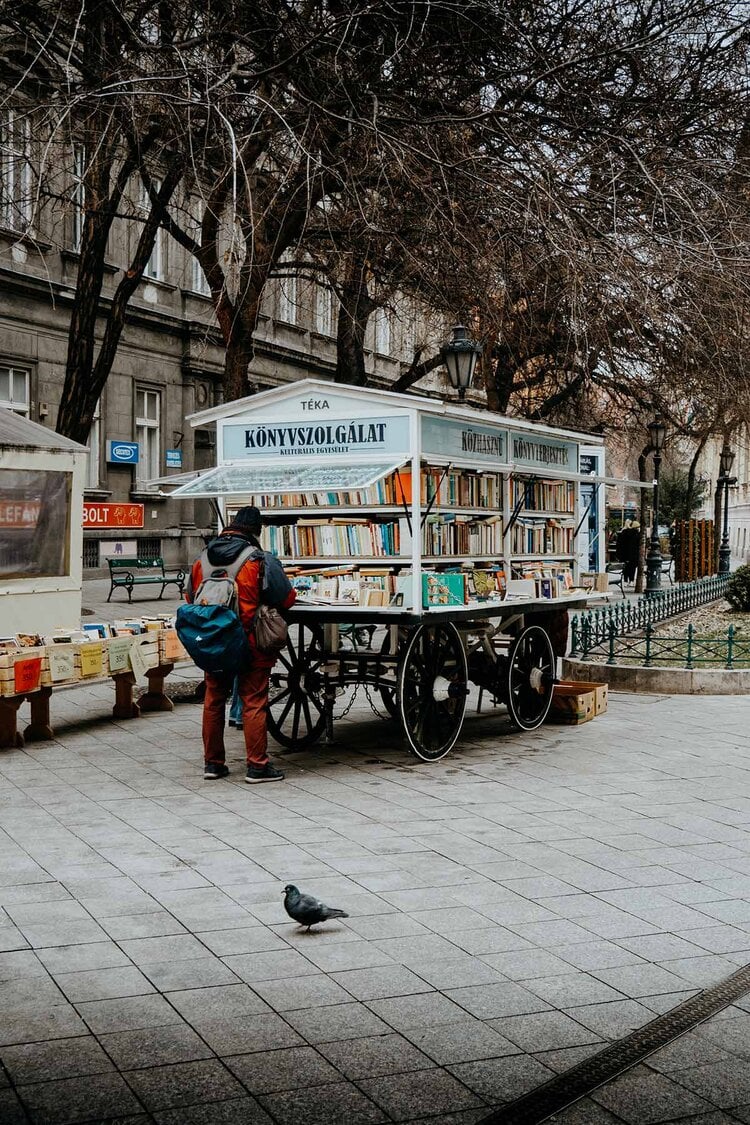
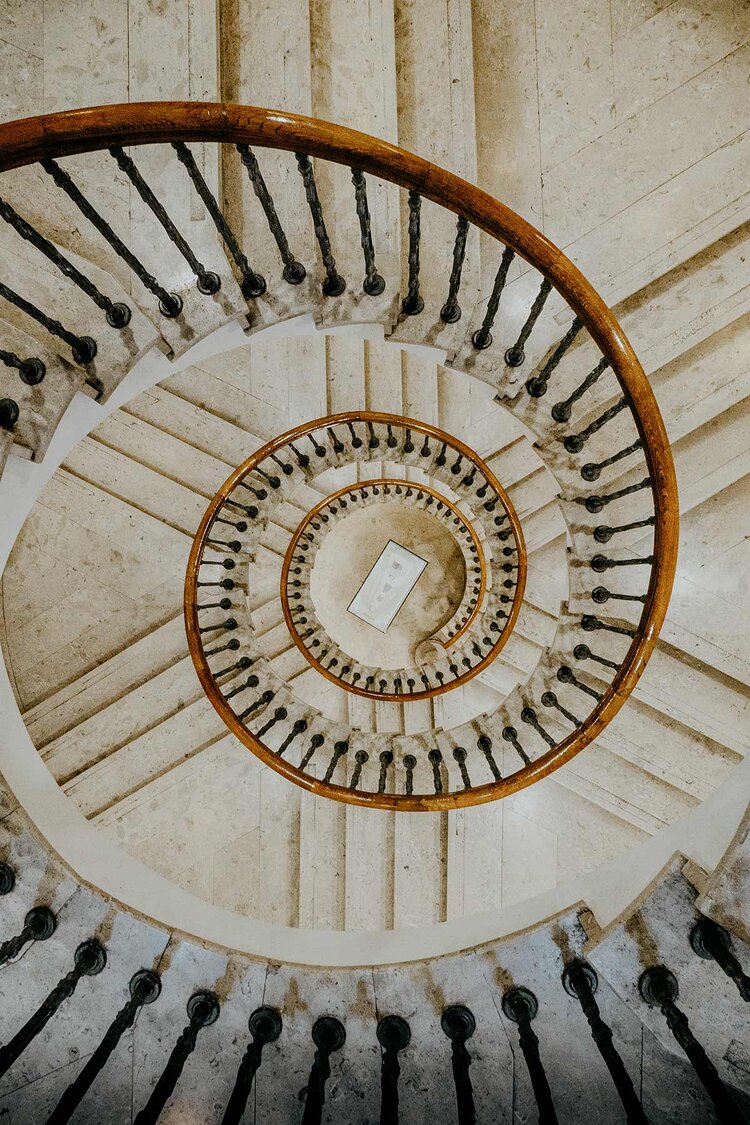
12 | METRO LINE M4 BUDAPEST
Budapest’s newest metro line is one of the world’s most innovative metro lines, while also being the city’s largest infrastructure project of the last decades.
Thanks to aforementioned acknowledgement, it managed to win the RIBA Awards for International Excellence in 2018.
The minimal yet progressively designed M4 line includes 10 ingenious stations that are, one by one characterized by their unique design and the ambience that accompanies it.
The fully automated M4 metro line operates with driverless trains, which basically means that you can take a seat in the front cabin if you wish.
If like us, you appreciate modern design and infrastructure, we deeply recommend having a look at some of these stations.
All of the M4 stations are easily accessible by using the Budapest card, including our personal favourites, Szent Gellért tér and Fővám tér.
The new M4 line also connects with the previously existing M2 and M3 metro lines.
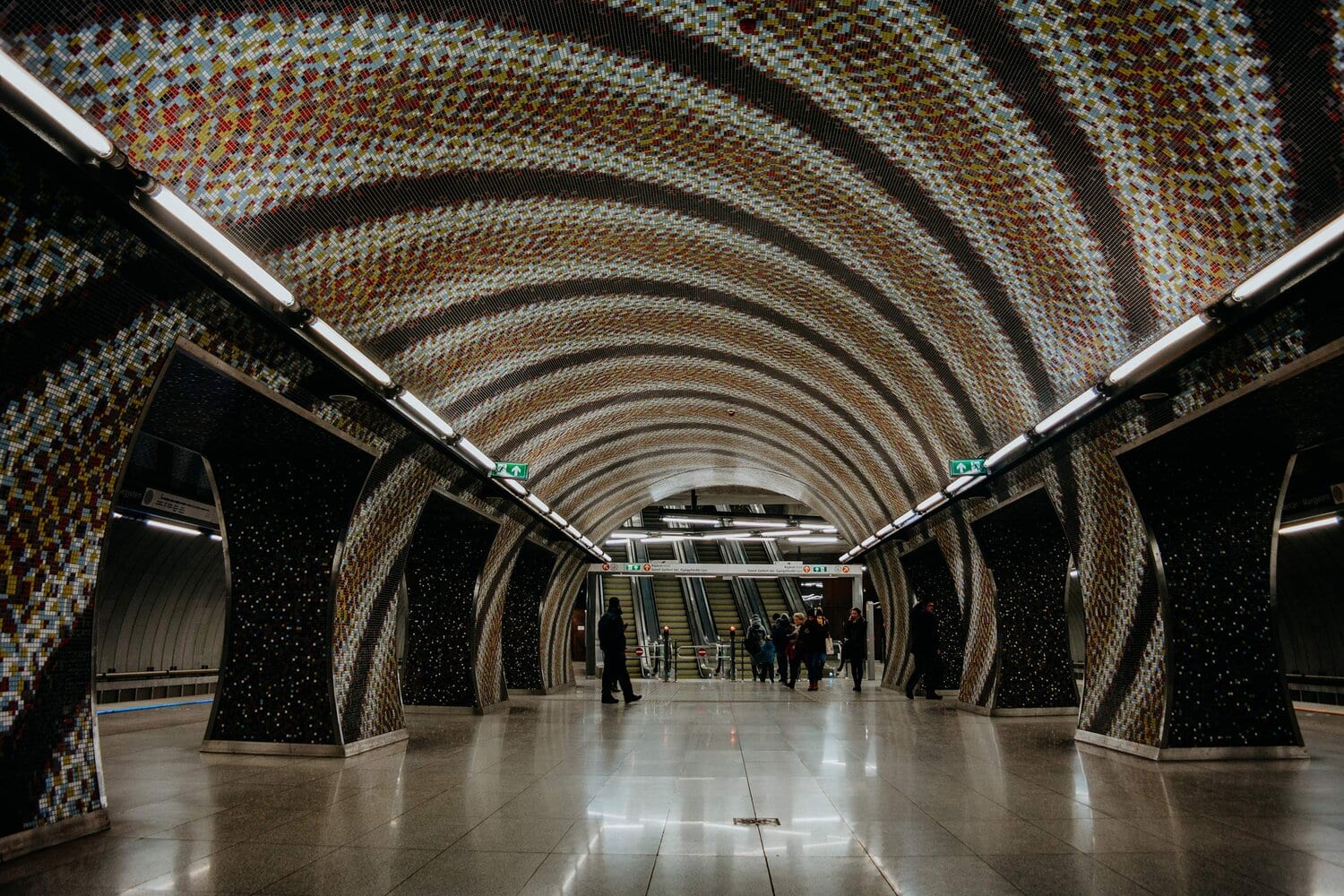
13 | HAVE A COFFEE AT THE NEW YORK CAFE
Budapest is home to the profoundly beloved New York Cafe, which is often considered the most beautiful coffeehouse in the world.
The extraordinary cafe that is designed in neo-Renaissance style, is situated within the luxury New York Palace Hotel and occupies almost the entire ground floor.
The historic coffeehouse was once the creative heart of Budapest and many writers, artists and editors gathered here to work on the most influential newspapers.
Today, the New York Cafe is admired by travelers from all over the world, and during our recent visit, we came to realize why.
Although the prices are relatively high, the cafe itself, with its marble columns, opulent interior and spectacular frescoes, easily lives up to its famous reputation.
It truly felt as if we stepped on a ’60s movie set and it was a delight to take in the vibe.
ESSENTIALS
Where | New York Cafe Budapest
Opening hours | Daily 08:00 – 00:00
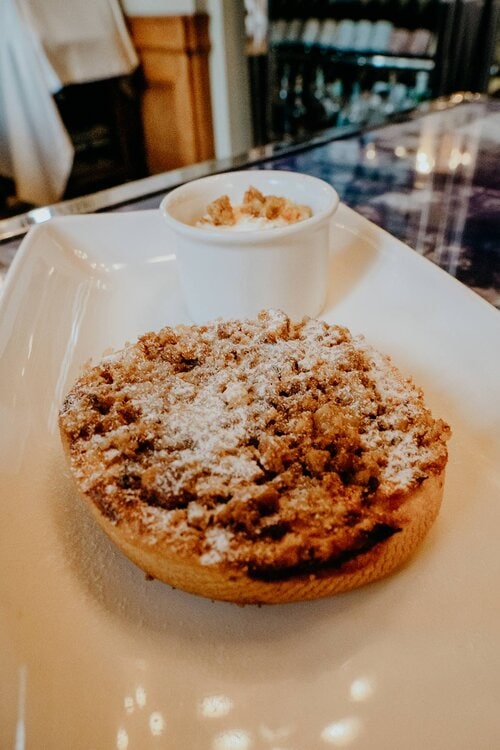
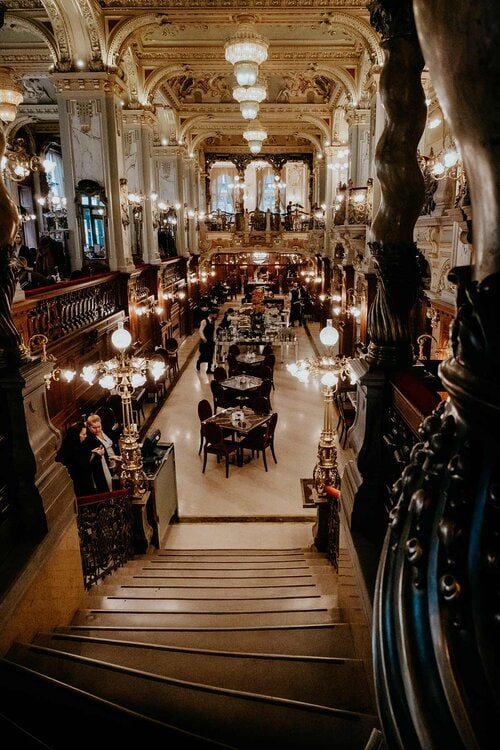
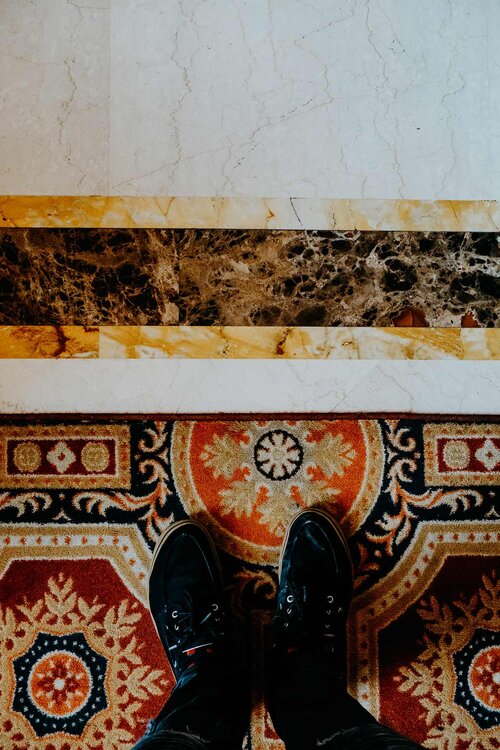
14 | TAKE THE FUNICULAR TO THE CASTLE DISTRICT OF BUDAPEST
At the foot of Buda Castle, you’ll encounter a historical cable car that transfers people from Adam Clarke square to the summit of the Budapest’s castle district.
The authentic Funicular is well-preserved and retained most of its original design, which dates back as far as the 19th-century.
Despite the fact that the funicular is extremely charming, we personally think that the 3-minute ride is too short to be enjoyed and therefore not worth the money.
Instead, you could take a gentle 10-minute walk that will easily take you to the summit of the castle district.
If you somehow do consider making use of the funicular, the cars run every 5 to 10 minutes.
ESSENTIALS
Where | Funicular to Budapest Castle District
Cost | One way 1.200 Hungarian Forint (€3,50) | Return 1.800 Hungarian Forint (€5,30)
Opening hours | Daily 07:30 – 22:00
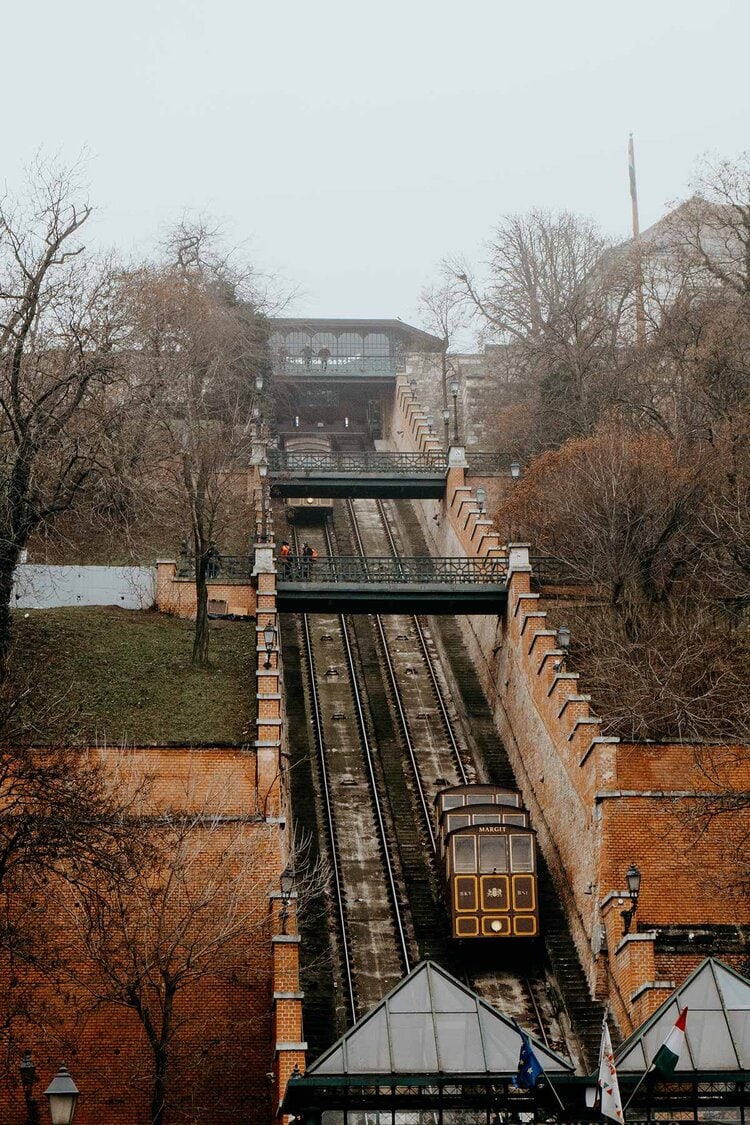
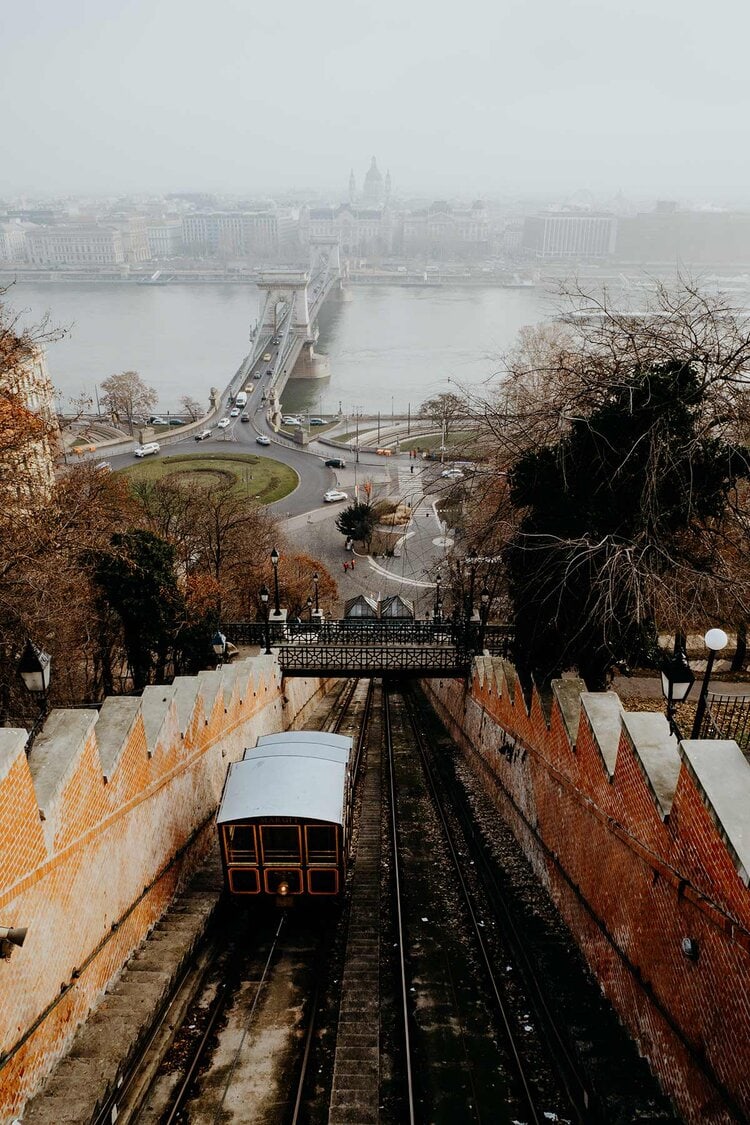
15 | VISIT BUDA CASTLE
Buda Castle is an eye-catching 13th-century palace that also happens to house the Hungarian National Gallery, the Castle Museum and the National Library.
If you’re willing to receive a glimpse of Hungary’s rich history, walk among the cobblestone pathways that guide you along various distinct architectural elements that date back from Medieval, Baroque and Modern times.
The sensational panoramic views from the summit, make sure that Buda Castle is one of the best vantage points in the city.
The amazing scene over both the Danube and Pest district is something you should definitely take in, especially during sunset.
ESSENTIALS
Where | Buda Castle
Entrance fee | Free, entrance to the Hungarian National Gallery and Castle Museum are free with a Budapest Card
Opening hours | The courtyards are open 24/7
Book | Reap the benefits and grab yourself a Budapest Card in advance
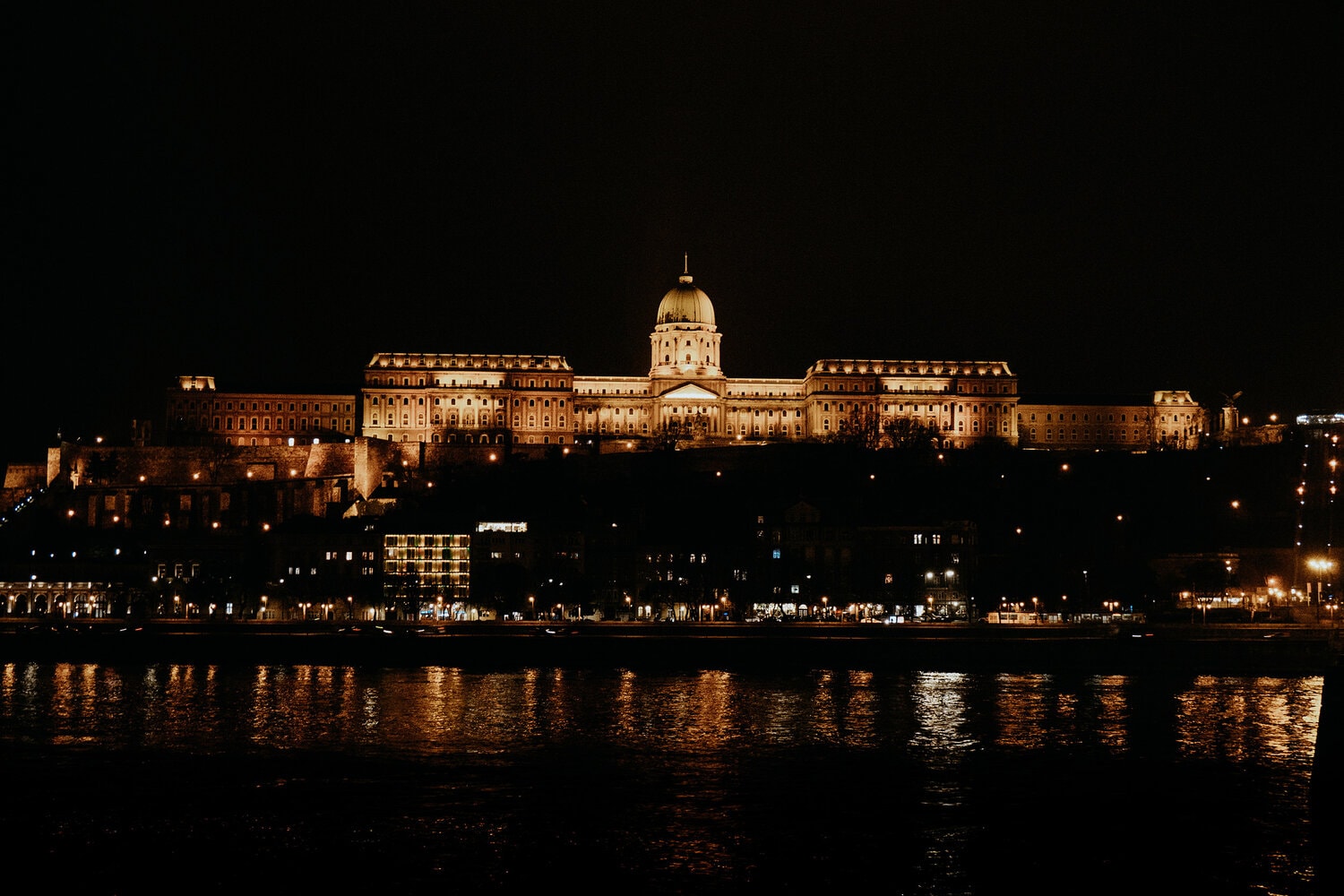
16 | EAT YUM MEXICAN FOOD AT TEREZA BUDAPEST
At the end of our first day in Budapest (which involved a lot of walking through the city’s picturesque little streets) we accidentally stumbled upon one of the finest Mexican restaurants in Budapest.
Those who follow our blog a little longer, probably know about the love we have for Mexican food.
It’s safe to say that we were extremely joyful when we settled at our table at Tereza Budapest.
Tereza has a genuine Hispanic ambience, which is at its peak during spring and summer when their high spirited urban garden is open.
We were positively surprised by not only the delicious Mexican food that they served but also by the wide variety of signature Mexican dishes and authentic flavoured Tequila & Mezcal.
Where most Mexican restaurants in Europe don’t serve our favourite dish, Tereza Budapest served us the best Taco Al Pastor we ate outside of Mexico.
Ooh, and if you take our recommendation serious, don’t forget to treat yourself to their freshly made guacamole.
ESSENTIALS
Where | Tereza Mexican Restaurant
Opening hours | Monday closed, Tuesday to Friday 17:00 – 00:00 and Saturday to Sunday 12:00 – 00:00


17 | WALK THE JEWISH QUARTER
The Jewish Quarter is unquestionable the liveliest and most dynamic neighbourhood in Budapest, and it’s still developing at a rapid pace.
The buzzing streets of the Jewish Quarter are home to an intriguing mix of trendy places, of which we can assure, pique your interest.
Situated throughout the entire neighbourhood are artisanal bakeries, trendy cafes, hip restaurants, impressive graffiti murals, and not to mention, Budapest’s notorious ruin bars.
We still think, the charm of wandering through its artistic streets and alleyways, was the main reason we fell in love with this exciting part of Budapest.
ESSENTIALS
Where | Jewish Quarter
Book | Budapest Grand Half-Day Jewish Heritage Tour
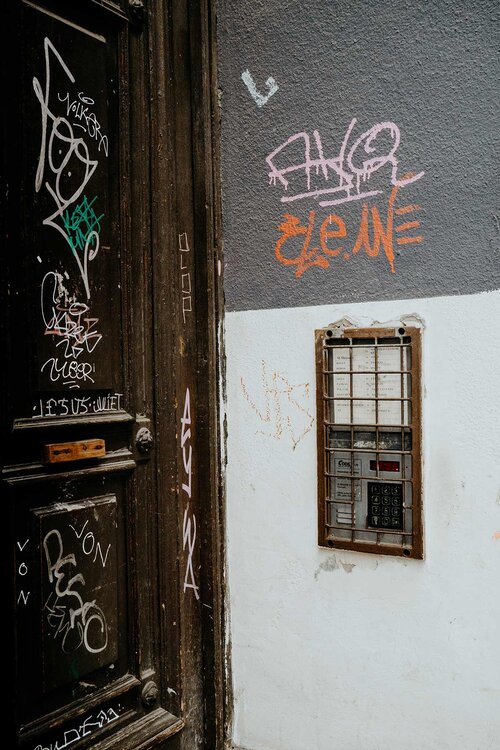
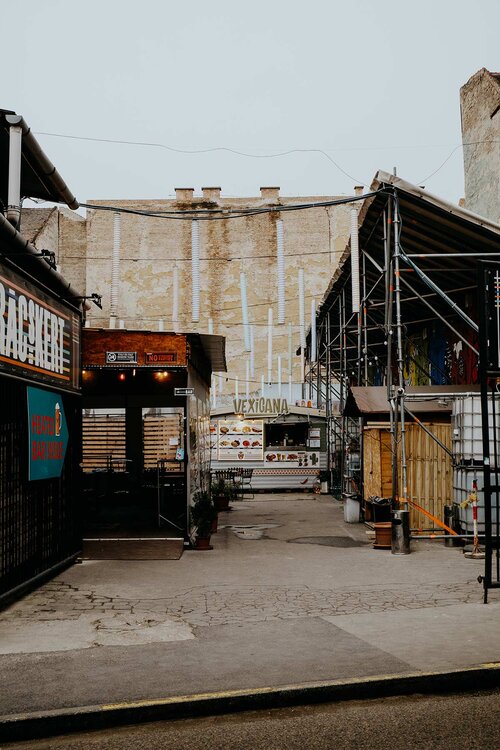
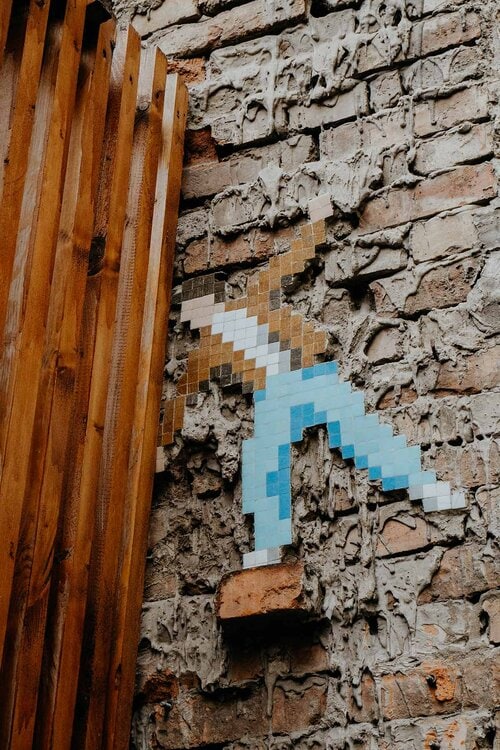
18 | ADMIRE BUDAPEST’S STREET ART SCENE
With amazing murals popping up on just about every corner, Budapest is rapidly becoming known for its refreshing street art scene.
The Jewish Quarter, in particular, is home to an abundance of creatively designed murals made by local and international graffiti artists.
The great thing about street art is that as you wander around the city, you might surprisingly notice a wall, fully covered by an amazing mural.
ESSENTIALS
Read more | A comprehensive guide to find the best street art in Budapest
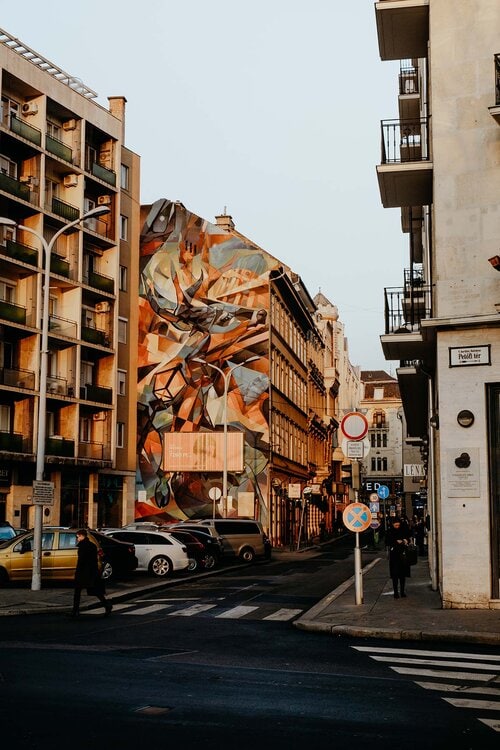
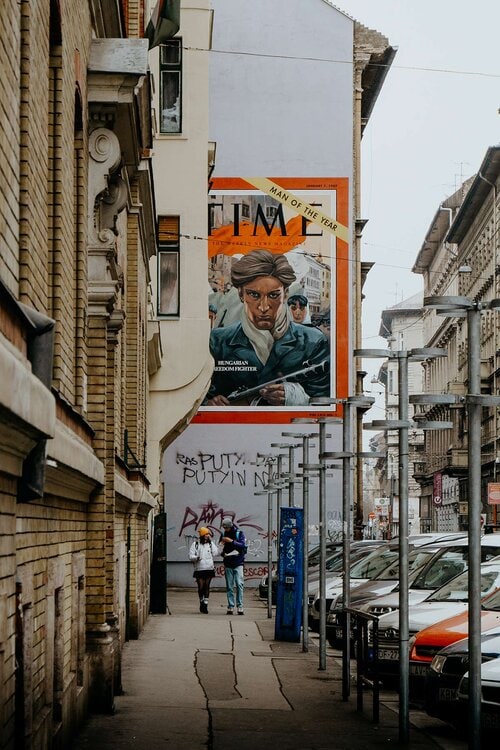
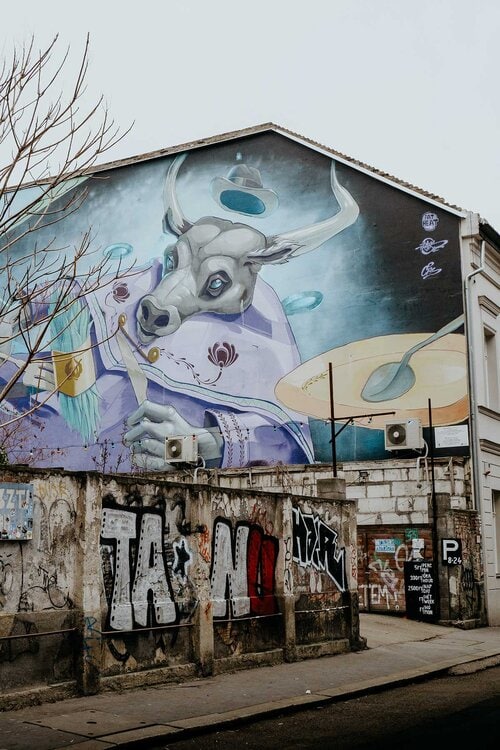
19 | GRAB A BEER IN ONE OF BUDAPEST’S CHARACTERISTIC RUIN BARS
Budapest is probably best known for its unique, characteristic ruin bars, and that’s for a good reason.
The city is home to a ton of contemporary bars that are established in abandoned residential buildings and urban decay in the 7th district.
These unique bars are filled with thrift-shop furniture, a young and creative atmosphere, and of course, lot’s of affordable craft beers to choose from.
Some of our favourites include:
SZIMPLA KERTMOZI
Szimpla was one of the first ruin pubs that opened its doors in the 7th district of Budapest, and until this day it is still by far the most authentic of its kind.
The atmosphere is mainly created by the mismatched interior that looks like it came straight from a flea market.
We think it’s great to visit Szimpla Kert during the day. You could take a beer, a quick bite (try their Black Sabbath burger, if you dare) and wander around the unusual building while admiring its characteristic interior.
It is incredibly picturesque if you ask us!
ESSENTIALS
Where | Szimpla Kertmozi
RED RUIN BAR
The Red Ruin Bar is a communism themed bar that tries to enlighten the country’s political past with a sense of self-mockery and humour.
The pub is decorated with red bricks, shining neon lights and humorous and sarcastic propaganda posters that refer to communism.
We think it’s both powerful and funny how they try to embrace the past and look at it from this perspective.
ESSENTIALS
Where | Red Ruin Bar
We hope to visit Budapest again sooner or later, there are so many exceptional ruin bars left to be discovered.
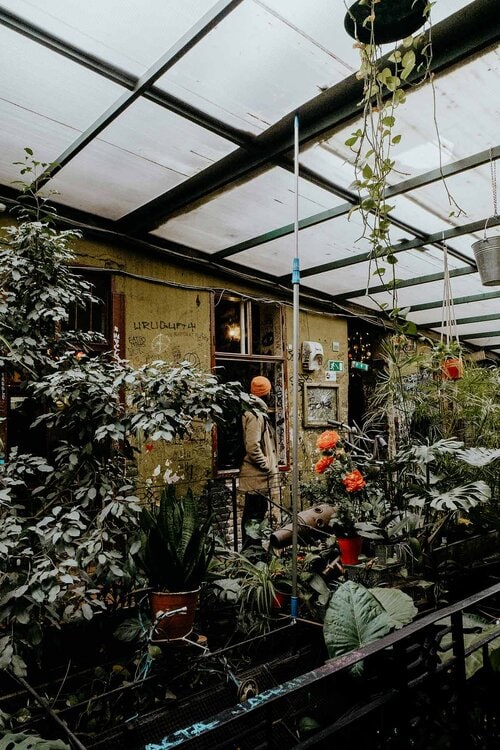
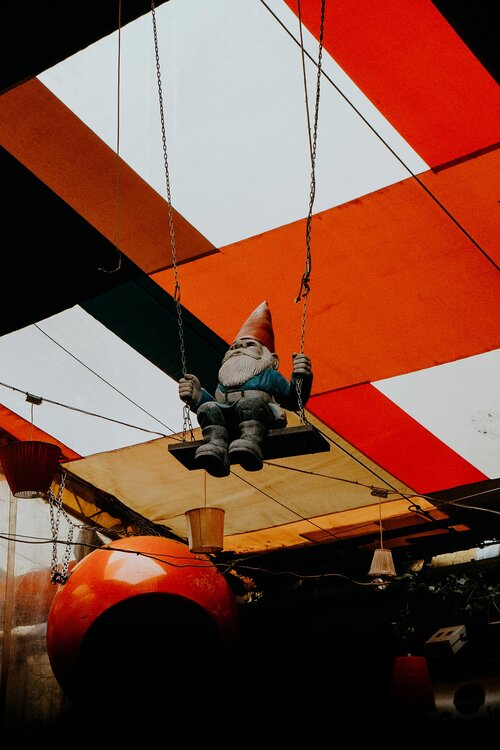
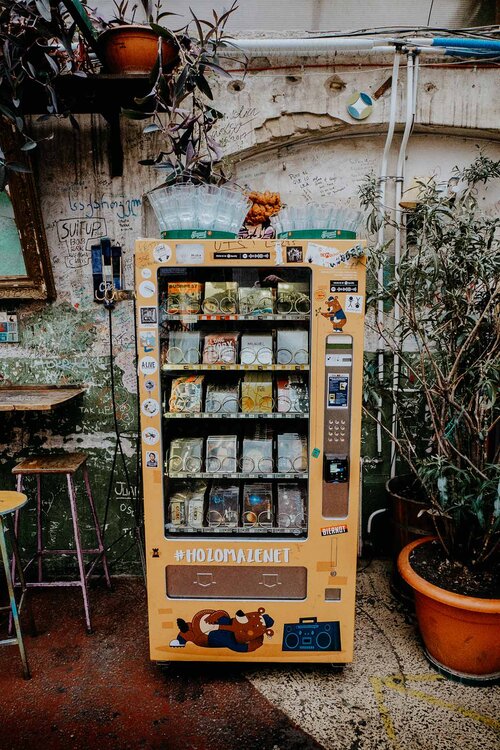
20 | VISIT THE DOHANY STREET SYNAGOGUE
The Great Synagogue on Dohany Street is Europe’s largest synagogue and is located directly at the heart of Budapest’s buzzing Jewish Quarter.
Although we’re not religious ourselves, we often admire the extremely detailed architectural aspects of spiritual and sacred buildings, and for that matter, Budapest doesn’t disappoint.
The main facade boasts exquisite brickwork, two exceptional polygonal towers and an elegant stained glass rose window above the entrance.
The synagogue has a mysterious, yet breathtaking interior, which combines Byzantine and Moorish elements, including the sumptuous organ and the impressive Holy ark.
ESSENTIALS
Where | Dohany Street Synagogue
Opening hours | Sunday to Thursday 10:00 – 16:00, Friday 10:00 – 14:00, Saturday closed
Entrance fee | 5.000 Hungarian Forint (€15,-) per person. You’ll get a 10% discount with the Budapest card
Book | The Great Synagogue Skip the Line Ticket
Book | Jewish Heritage Guided Walking Tour
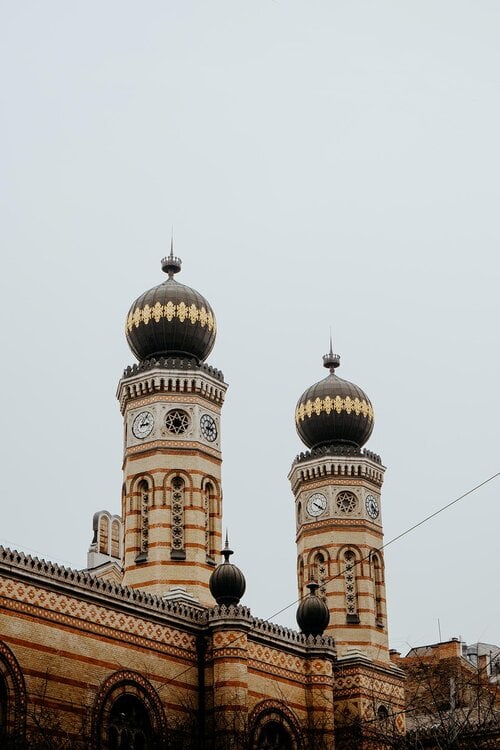
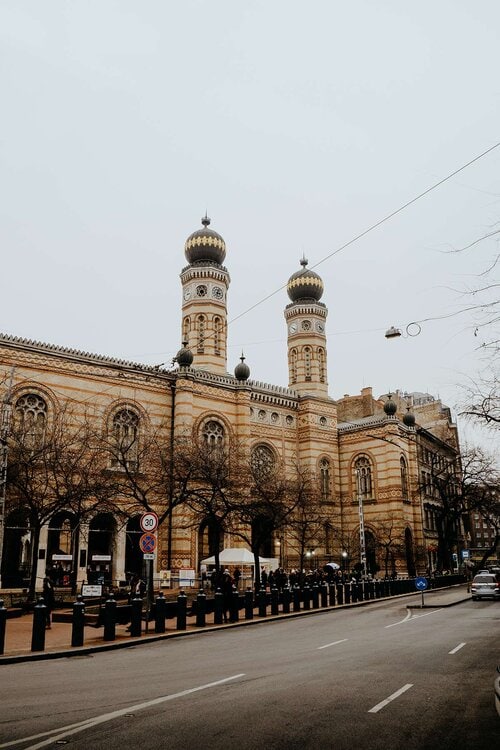
21 | HAVE A DRINK AT GOZSDU UDVAR
The Gozsdu Udvar is a buzzing area where food, entertainment and culture combine in a spirited, yet relaxing way.
However, we also started our blogging journey, to inform you about our disappointing travel experiences.
And, in that case…
Let’s say, without trying to be rude, that our food wasn’t close to what we had expected it to be.
We honestly think that the restaurants at the Gozsdu Courtyard are commercial and slightly overpriced, especially when compared to the other more sophisticated dining options in Budapest.
We still think that Gozsdu Udvar is the perfect venue to sit down, have a couple of drinks and unwind after a long day of walking.
ESSENTIALS
Where | Gozsdu Udvar
22 | CLIMB GELLÉRT HILL
It is said to be the most scenic perspective of the city as it reveals the entire skyline of Budapest, including the untamed Danube that separates Buda and Pest.
Perched atop of the 235-metre high hill and visible from multiple parts of the city is the towering Liberty statue.
The statue of a woman holding a palm leaf commemorates those who sacrificed their lives for the independence, freedom, and prosperity of Hungary.
Gellért Hill will definitely add a little extra value to your city break to Budapest, so make sure to climb the steep hill, especially if you have some unplanned time in your travel schedule.
ESSENTIALS
Where | Gellért Hill
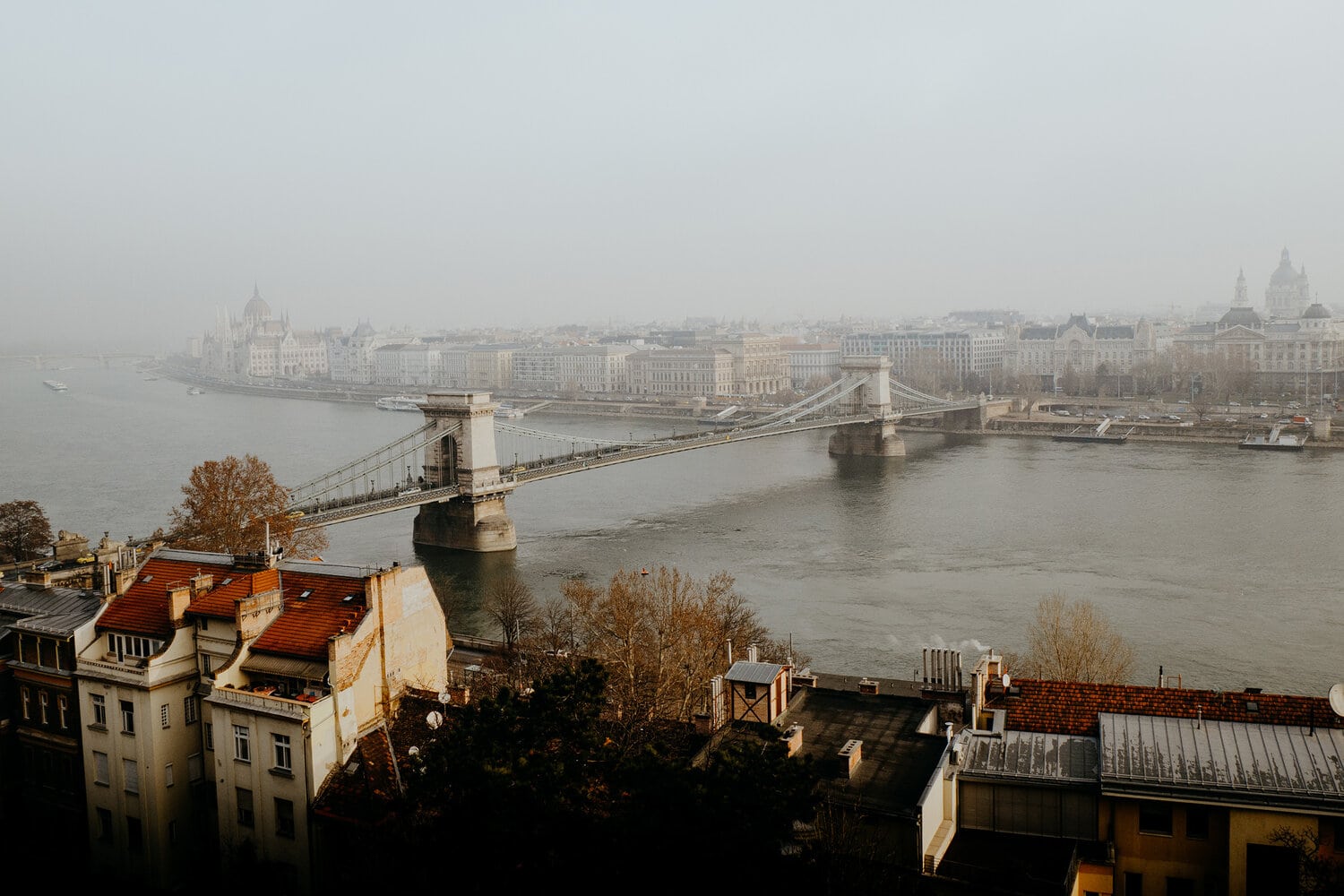
23 | WALK HEROES SQUARE
At the stretch of Budapest’s lush city park, lies the impressive Heroes’ Square.
The grand square is home to 14 impressive statues, that respectively honour the lives of those that were of significant importance throughout the rich history of Hungary.
In the centre of the square, you’ll mark the towering Millennium Monument, a 36-metre high column topped by a golden Archangel Gabriel, displaying the Hungarian crown.
The rich history that is found at the Heroes’ Square is enhanced by the creative company of the Museum of Fine Arts and the Hall of Art.
ESSENTIALS
Where | Heroes Square
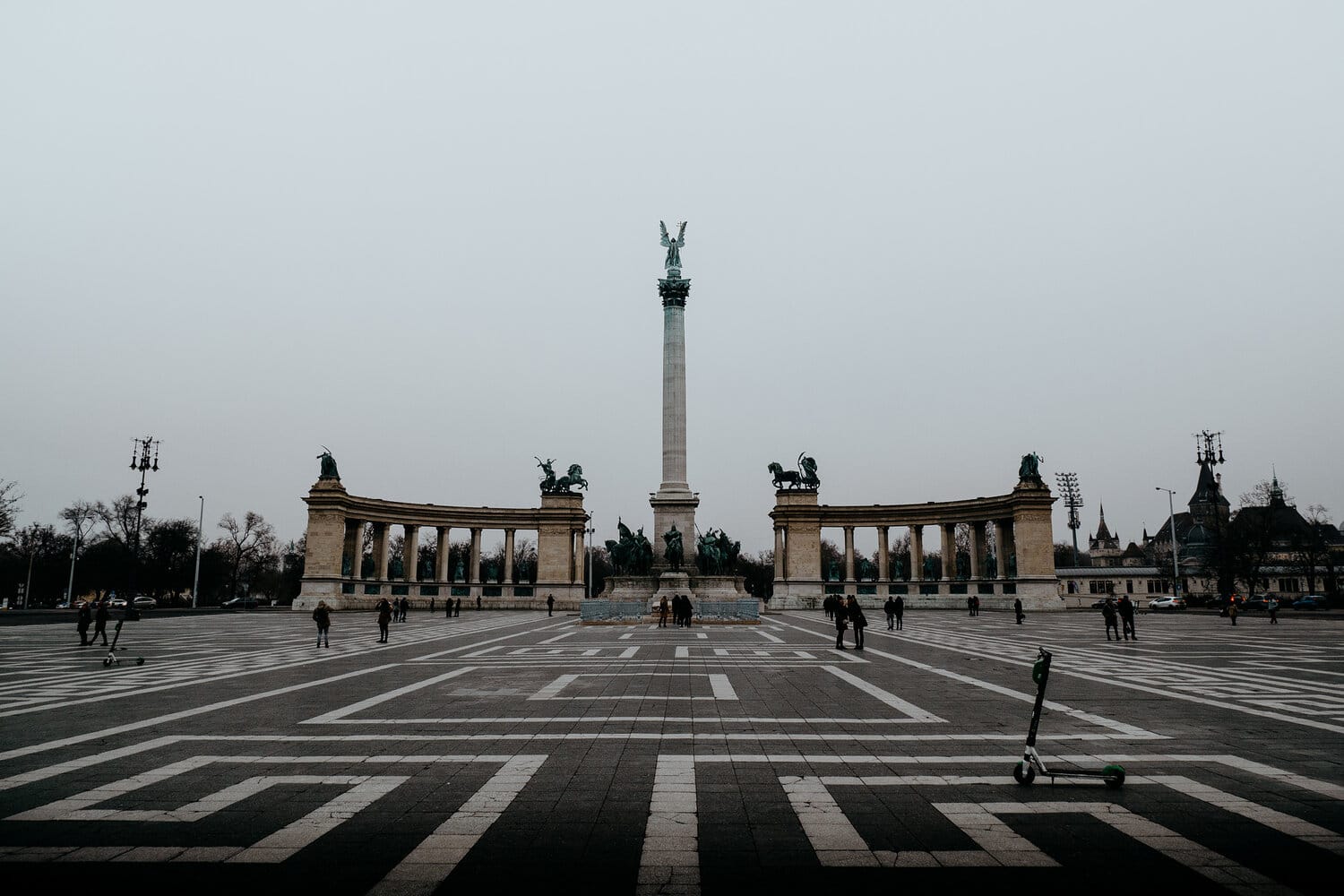
WHERE TO STAY IN BUDAPEST
Luckily, Budapest isn’t lacking when it comes to accommodations, in fact, there are options that suit all budgets.
It can, however, be quite a challenge to find accommodation that fits your travel style during high season, therefore we believe it is wise to book your stay a couple of weeks, or even months in advance.
Radisson Blu Béke Hotel | Exquisitely furnished rooms with air conditioning, a spacious bathroom ensuite and everything you need to unwind after a long day of sightseeing. On top of that, the hotel provides a pleasant bar and restaurant on-site – plus they happen to employ courteous and extremely accommodating staff.
BOX Studio in Ruin Pub District | A great spacious apartment that provides a private bathroom and a fully equipped kitchen. Located at the heart of Budapest’s lively ruin pub district and close to many popular points of interest.
The Loft Budapest | Uniquely designed rooms, large comfortable beds and a private bathroom with rainshower make this loft a steal when it comes to comfort. One extra benefit is its strategic location. The loft is located close to several good restaurants and cafes, three major metro lines and is surrounded by the top attractions of Budapest.
Economy Apartments | One of the great things we like about Budapest is that you’ll find comfortable rooms in every price range. The comfy Economy Apartments offer decent rooms and a private bathroom while it is located on a prime location – plus it doesn’t bust your budget.
Alternatively, search for accommodations in Budapest on booking.com.
MY FAVOURITE DAY TRIPS & TOURS IN BUDAPEST
If you’re after an organized tour to discover Budapest, here are some of my favourites
CURRENCY IN BUDAPEST
Even though Hungary is part of the European Union, they still use their own currency instead of the Euro, which is the Hungarian Forint (HUF).
The Budapest exchange rate at the time of writing is as follows, 100 Hungarian Forint is equal to €0,30.
We have noticed that the most reliable way to save on commissions, is paying with your credit or debit card.
CASH WITHDRAWAL
The very first thing that drew our attention when arrived in Budapest, was the amount of ‘independent ATMs’ that were established throughout the touristic area of the city.
We noticed, that it has become a trend for vendors to install an independent ATM outside their stores. It is generally known to be an easy way to earn money.
From our previous travel experiences, we learned the hard lesson that those machines charge an absurd withdrawal fee and hold your money until the exchange rate is in the owner’s favour, therefore we can’t emphasize it enough to ignore them.
Read more | How to avoid ATM charges and bank fees when you travel
HOW TO GET FROM BUDAPEST AIRPORT TO THE CITY CENTRE
It is really easy to get from Budapest Airport to the city centre with the public bus, this also applies the other way around.
Bus 100E | Bus 100E goes directly from Kalvin Ter M to Budapest Airport. The price for a ticket is 900 Hungarian Forint (€2,70) and can be purchased at the machines at the bus and metro stations.
Bus 200E | The second option can be done with your Budapest travel card and therefore free of charge. Take bus 200E to Nepliget and change there to the bus heading for Budapest Airport.
Both options work vice-versa. We deeply recommend being at the station 10 minutes ahead of the departure time, especially if you have a flight to catch.
A guide to Rotterdam, Holland's incredibly picturesque city
Thinking about a citytrip in The Netherlands? Don’t mind to visit Rotterdam. After the bombings of 1940 Rotterdam was rebuilt into a modern city that stands out in modern architecture. The lively city is a perfect weekend trip and has a lot of variation to offer. Walk along the Erasmusbrug, photograph the Kubuswoningen or relax at the Witte de Withstraat.
Keep reading this guide as we will tell you more about the things to do in Rotterdam.
A GUIDE TO ROTTERDAM, THE NETHERLANDS
1 | ARRIVE AT ROTTERDAM CENTRAL STATION
When you arrive at Rotterdam Central Station you immediately get a glimpse of the architecture Rotterdam has to offer. In 2014 the station had to go through a redesign because the old station didn’t have the capability to receive the average of 110.000 passengers it has daily.
The unique design makes it an interesting piece of architecture to visit. The combination of sharp edges and innovative materials combined with old elements make it a great asset for Rotterdam city. Photograph the shape in contrast with the sky and this building could make a stunning frame.


2 | WALK ALONG THE LUCHTSINGEL, YELLOW BRIDGE
Back in the days het Hofplein was the heart of Rotterdam, a few years ago nothing was left of that. So the city of Rotterdam raised money with crowdfunding to connect the city with a unique project called The Luchtsingel. With over 8.000 people that supported the initiative the 390 metre long yellow pedestrian bridge became a reality.
The bridge now functions to connect the central rail station with the forgotten parts of the city Rotterdam North and the Binnenrotte. In 2013 Luchtsingel won the Urban Intervention Award Berlin as an appreciation for this beautiful project that reconnects the city. If you walk along the bridge you will reach Luchtpark hofbogen where you can sit down and take a break.


3 | ADMIRE ROTTERDAM’S INCREDIBLE BRIDGES AND ARCHITECTURE
After the bombings of 1940, Rotterdam was rebuilt into a modern city that stands out in modern architecture. The city centre is compact so you get along excellent on foot. Walk over the Willemsbrug and have a look in the neighbourhood Kop van Zuid and walk back along the Erasmusbrug.
Or have a look at Post office POST Rotterdam that was built between 1915 and 1923. It is currently going through renovations as it will soon be functioning as apartments to match modern-day Rotterdam.
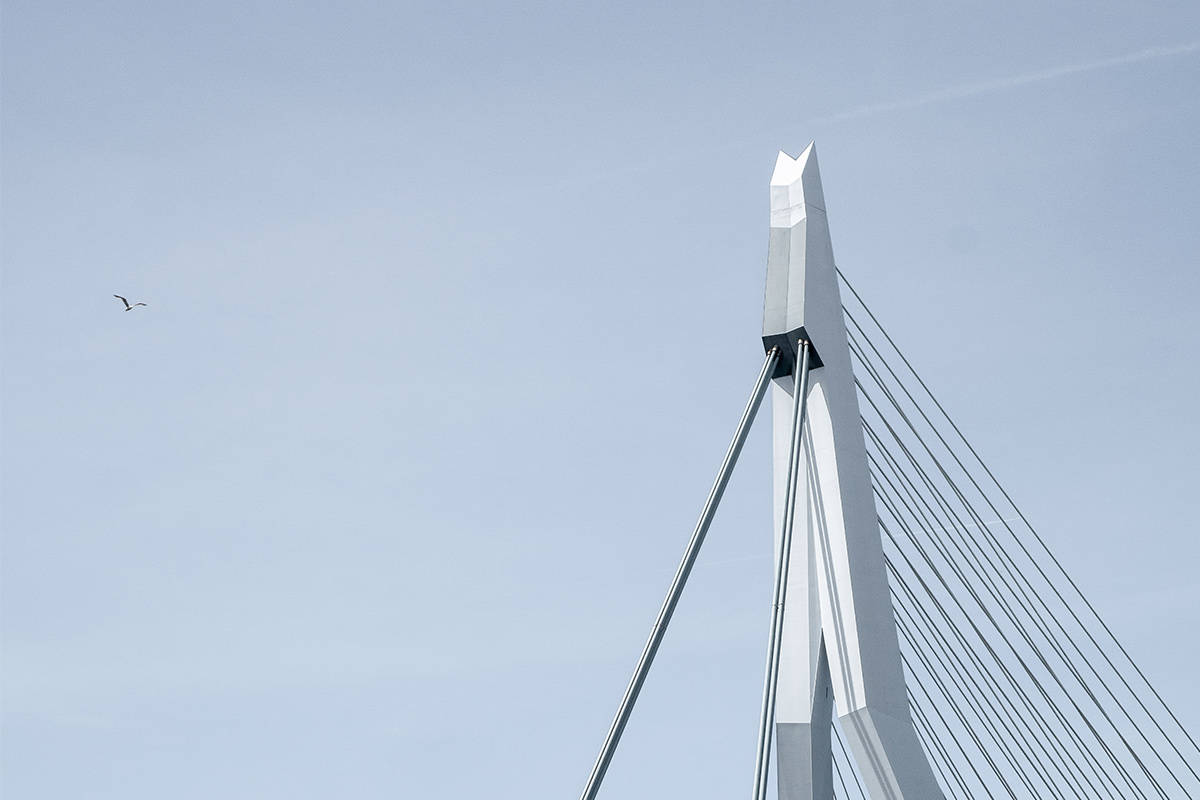
4 | HAVE LUNCH AT THE WITTE DE WITHSTRAAT
With all kinds of trendy cafés, restaurants and bars this truly is the place to be in Rotterdam. Witte de With is, without doubt, the place to simply relax while soaking up the atmosphere.
If you like Mexican cuisine you should have a taste at Supermercado, a cocktail bar-restaurant with Latin American kitchen that creates a street food vibe. Top it off with delicious ice cream at De IJssalon on the other side of the trendy street. They serve sorbets and dairy ice cream that will attack your taste buds.


Another place you might like is Nieuw Rotterdams Café which goes by the name NRC. This Metropole Café is one of the hotspots and transforms itself from café restaurant to bar every weekend. Enjoy funky, soul and r&b beats while drinking a cocktail.
Besides the booming restaurant scene, Witte is popular for her street art. As one of the places with the most graffiti in Rotterdam don’t mind wandering off to the side streets of Witte de Withstraat.


5 | ADMIRE THE CUBE HOUSES
The Kubuswoningen is a series of innovative Cube Houses designed by architect Piet Blom. Located between de Markthal and de Blaak you will find this piece of unique modern architecture. If you look at it from the outside you will question yourself if it is possible to live in one. If you want to have an impression of how the inside looks, visit the museum named ‘kijk-kubus’. The show cube is open every day from 11 am to 5 pm for an entrance fee of €3,-. Or book your stay here, to spend the night in one of the cubes and get the ultimate experience.
Try to plan your visit early in the morning, it is one of the most popular spots in Rotterdam.
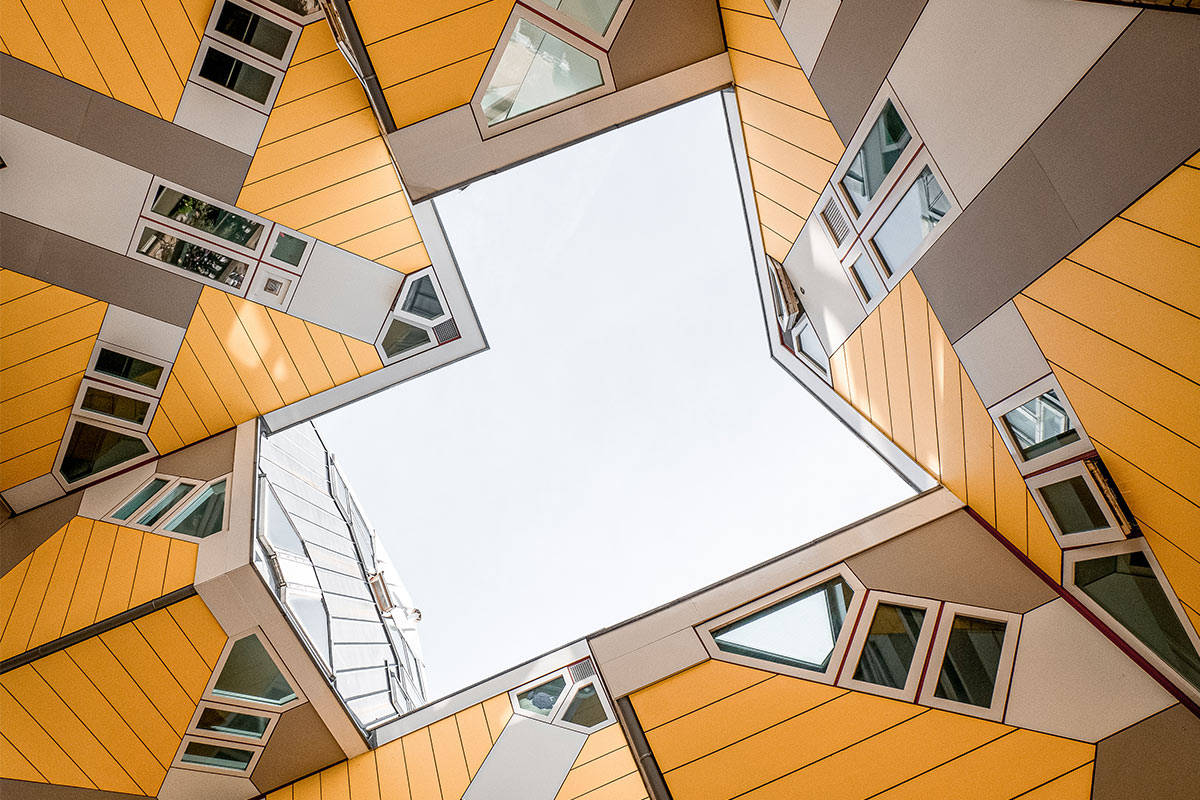
6 | EAT YOUR HEART OUT AT MARKTHAL
The Markthal in Rotterdam is the biggest one in The Netherlands. With more than a hundred food stalls and a building that is just as spectacular, The Markthal is a must-visit in Rotterdam. Try local cuisines such as poffertjes, cheese and herring or have a go on famous national dishes.
Besides the fact that the Markthal is a foodie Walhalla, it’s also a gigantic piece of art. The inner walls are covered with 4.000 tiles decorated with colourful artwork named Horn of Plenty by Arno Coenen and Iris Roskamp. An interesting thing about the Markthal is that it also functions as apartments, 228 to be exact.
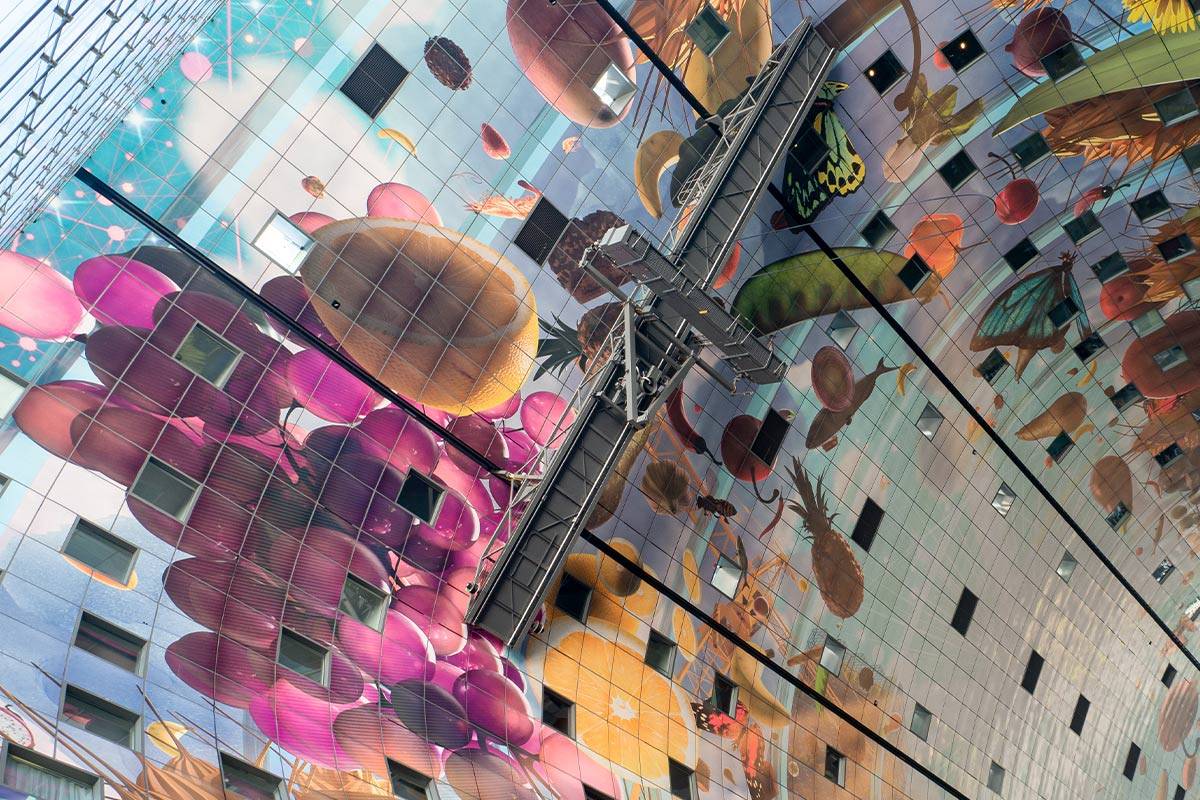
WHERE TO STAY IN ROTTERDAM
Ani & Haakien | Located close to the central station this hostel makes you feel at home while in Rotterdam. A modern-looking, clean and cosy place with a lovely backpackers vibe. The price is good and the Wifi even better.
CityHub Rotterdam | A high-tech private sleeping cabin that can be controlled by an app on your phone. All cabins have a king-size double bed and the shared bathroom has a rain shower and free toiletries. Perfectly located on the Witte de Withstraat close to the main tourist attractions of Rotterdam.
King Kong hostel | The most popular hostel in Rotterdam and the vibes are just amazing. The combination of the trendy and artistic interior makes this hostel a unique place to stay. The lively vibe that attracts you to the Witte de Withstraat translates itself perfectly into the King Kong Hostel.
StayOkay Rotterdam | If you are curious to experience how it feels to stay in a Cube House then this is your chance. The room is quite basic but the experience itself is just fun and exciting.


HOW TO GET AROUND ROTTERDAM
WALKING | Although the city centre of Rotterdam is really compact, it can be a little confusing finding your way. If you keep the Erasmusbrug as a start point it will be easier to navigate around the town. The best way to explore Rotterdam is by foot. All attractions in Rotterdam are within walking distance of each other.
BIKE | Another way to get along in Rotterdam is by bike. Donkey Republic is an easy service when it comes to renting a bike. But be careful, the traffic can be a bit chaotic in the Netherlands.
PUBLIC TRANSPORT | The easiest way to get around is with public transportation. The Rotterdam Welcome Card is a travel card that also provides a discount on a lot of tourist attractions in Rotterdam.
There are three options to choose from all of them coming with a city map and information about the discounts.
1 Day card | €12,50 per person
2 Day card | €18,50 per person
3 Day card | €23,50 per person


STAY SAFE IN THE NETHERLANDS | TRAVEL INSURANCE
When travelling this big wide world, I never go on an adventure without my essential travel insurance sorted out, and though the Netherlands is safe, I recommend anyone travelling here to do the same.
Though you rather don’t think about the things that could go wrong, there’s always a chance that something happens, and when that’s the case, it is better to be safe than sorry.
To help you find the right policy, I’ve listed two of my favourite options below:
Heymondo | Whether you’re going on a 3-week backpacking trip, or planning a long stay somewhere abroad, Heymondo has excellent insurance options either way – plus full covid-19 coverage and a handy app with 24-hour medical assistance. Readers of WTSW receive 5% off any insurance policy, more information here.
World Nomads | If you’re an adventure seeker, backpacker, or planning your once-in-a-lifetime world trip, make sure you check out World Nomads, they designed the perfect travel insurance to help you travel safer and smarter. Do note that they’re not covering covid-19 related claims.
USE THESE ESSENTIAL GUIDES OF THE NETHERLANDS
A guide to the Pyramide van Austerlitz, Utrecht’s very own pyramid
A guide to the Pyramide van Austerlitz, Utrecht
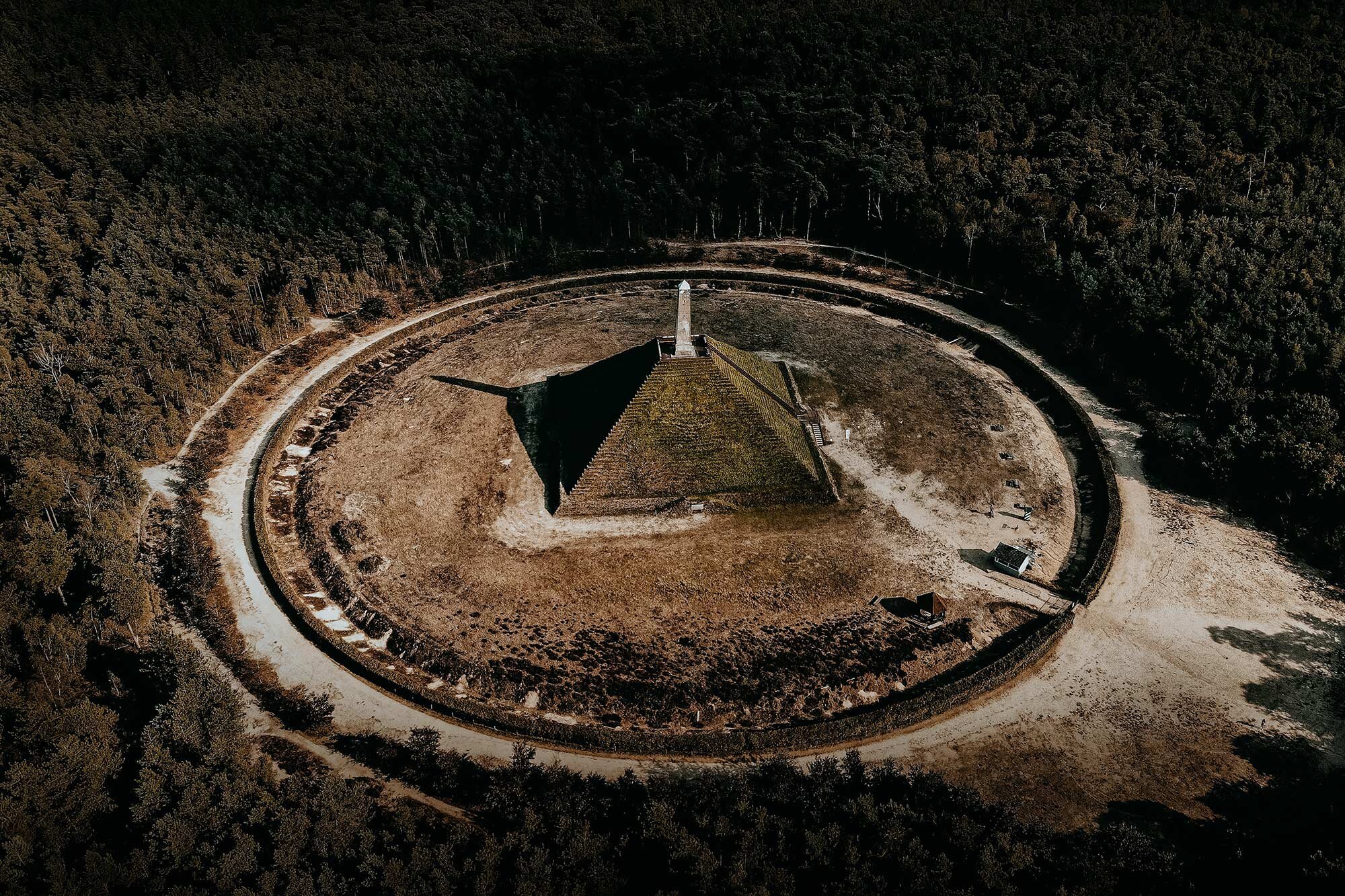
Did you knew there is a pyramid in The Netherlands? It is in fact, the only pyramid in Europe.
Even though we are both born and raised in The Netherlands, we didn’t knew as well. When we heard of it we did some research. There is a small town in Utrecht called Austerlitz. In 1804 Napoleon’s soldiers built a 36-metre-high pyramid which is now one of the highest points of Utrecht.
Although the Egyptians never made it this far north, they definitely inspired the soldiers with their architectural masterpiece. What to do in Utrecht? Visiting this historical place, isn’t that nice?
Take a look at this guide to find out more about the Pyramide van Austerlitz.
If you choose to use any of the links on this page, I may receive a small commission at no extra cost to you. By using these links, you’ll have a direct impact on WTSW and support my ability to continue to create free insightful travel content for you. If you find any of my tips useful, you can support me by buying me a virtual coffee here.
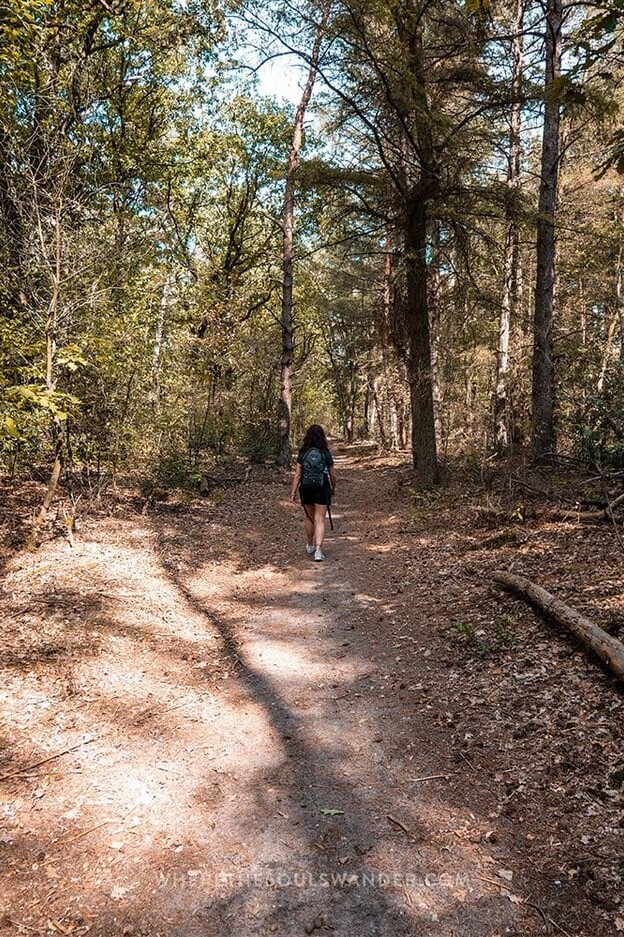
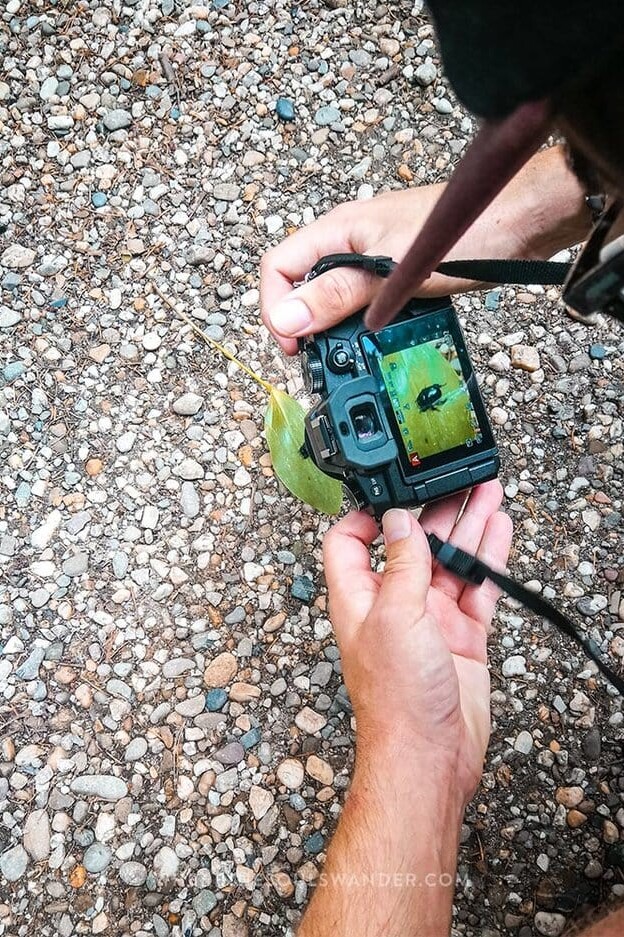
The Utrechtse Heuvelrug
When you have an interest in what to do in Utrecht, this is your read. When you plan to visit Utrecht it is really nice to have a walk through the Utrechtse Heuvelrug.
It is also possible to rent a bike to explore the area. It’s an oasis of calm just outside of the Randstad. With a vast natural environment and lots of historical locations, it’s lovely to spend the day, or even two. But that’s up to you!
There is no way around the Utrechtse Heuvelrug if you want to visit the pyramid.
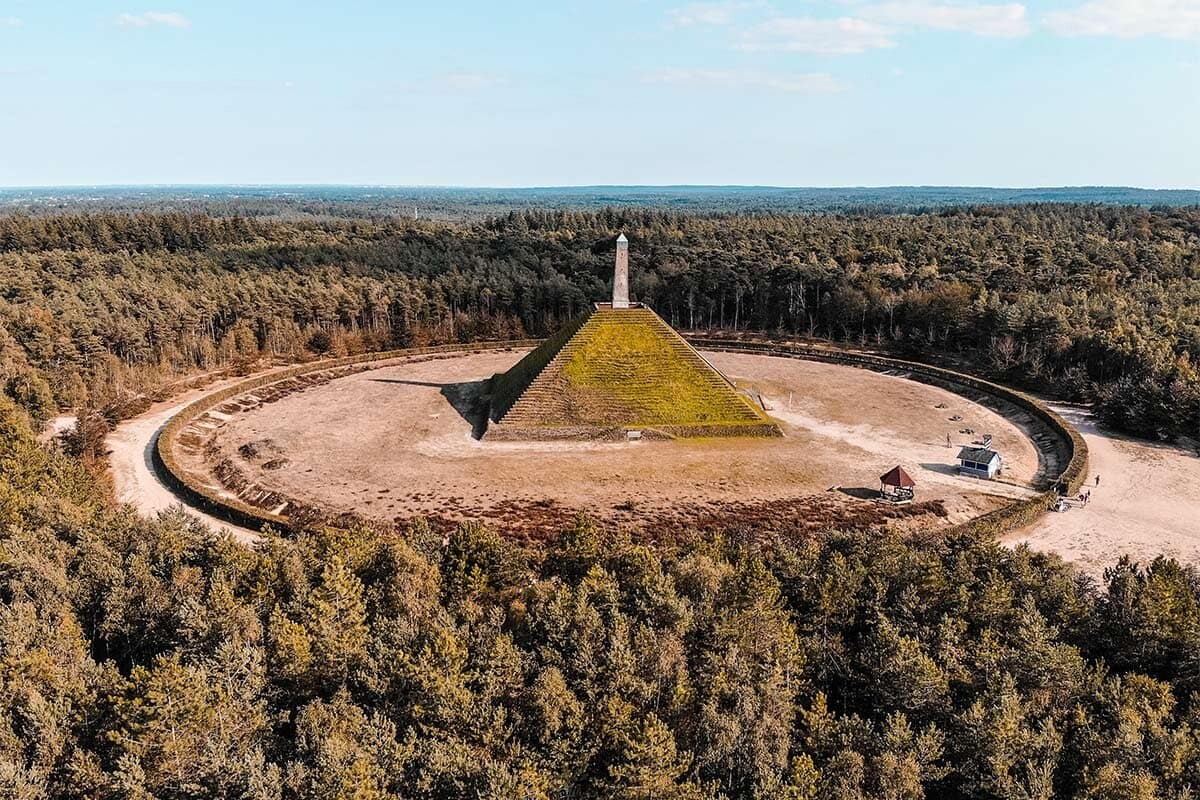
The Pyramide van Austerlitz
Start your trip at NS Station Driebergen-Zeist and walk your way to the small town of Austerlitz. To plan a trip with public transportation in The Netherlands it comes in handy to use OV9292 and the NS reisplanner. When you plan to walk to the pyramid keep in mind that it is a one and a half-hour walk. It eventually took us three hours of walking before we arrived. The reason it took us so long was that we just bought our drone and camera and in combination with the lovely vast natural environment it’s a guarantee for success. So if you have a drone, don’t mind taking it with you.
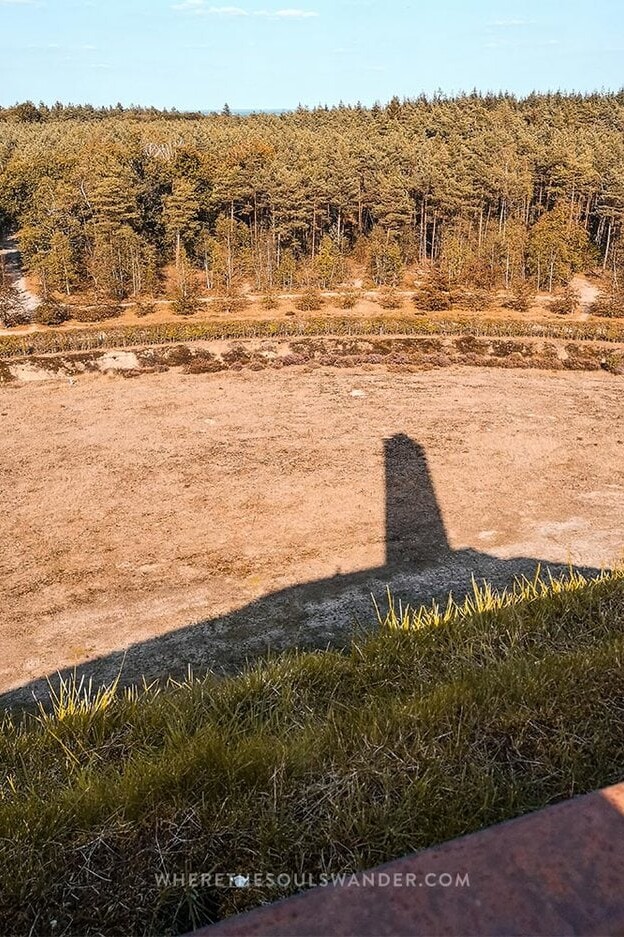
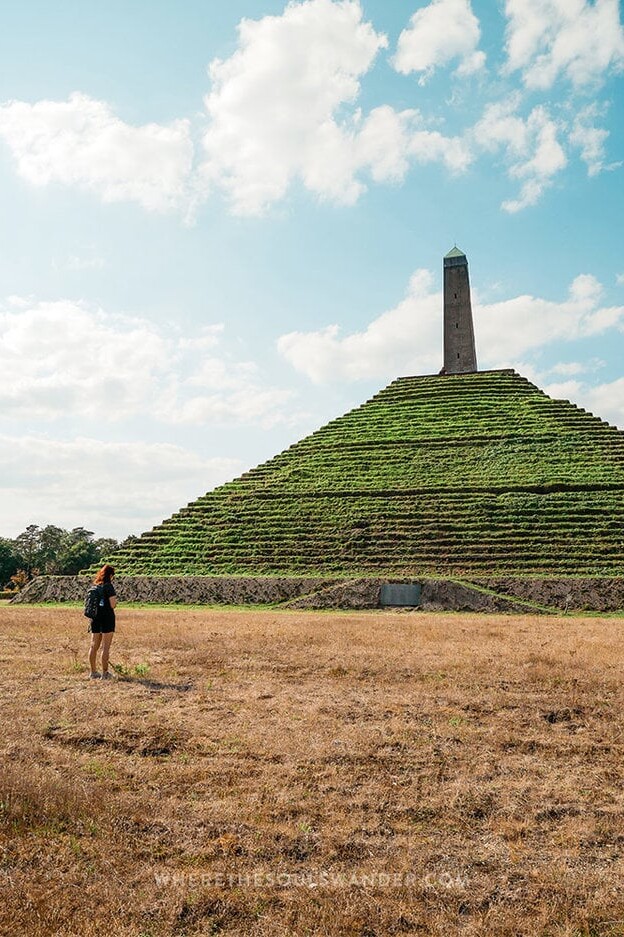
History of the Pyramide van Austerlitz
In 1804, the French General Auguste de Marmont established an army camp (le Camp d’Utrecht) in this central location in the Batavian Republic, the present Netherlands, where over a period of several months he forged together various battalions into a large, well-trained army, capable of beating the British enemy should there be any repetition of the invasion of 1799.
In the autumn of 1804, satisfied with the military power of the new army, and to occupy his bored soldiers, Marmont had his soldiers build an earth and turf monument inspired by the Great Pyramid of Giza, which Marmont had seen in 1798 during Napoleon’s Egyptian campaign.
Even the erosion-exposed stepped surface was imitated. Construction lasted 27 days. The pyramid hill was 36 metres high and surmounted by a 13-metre-high wooden obelisk. It was named “Mont Marmont” or “Marmontberg”.
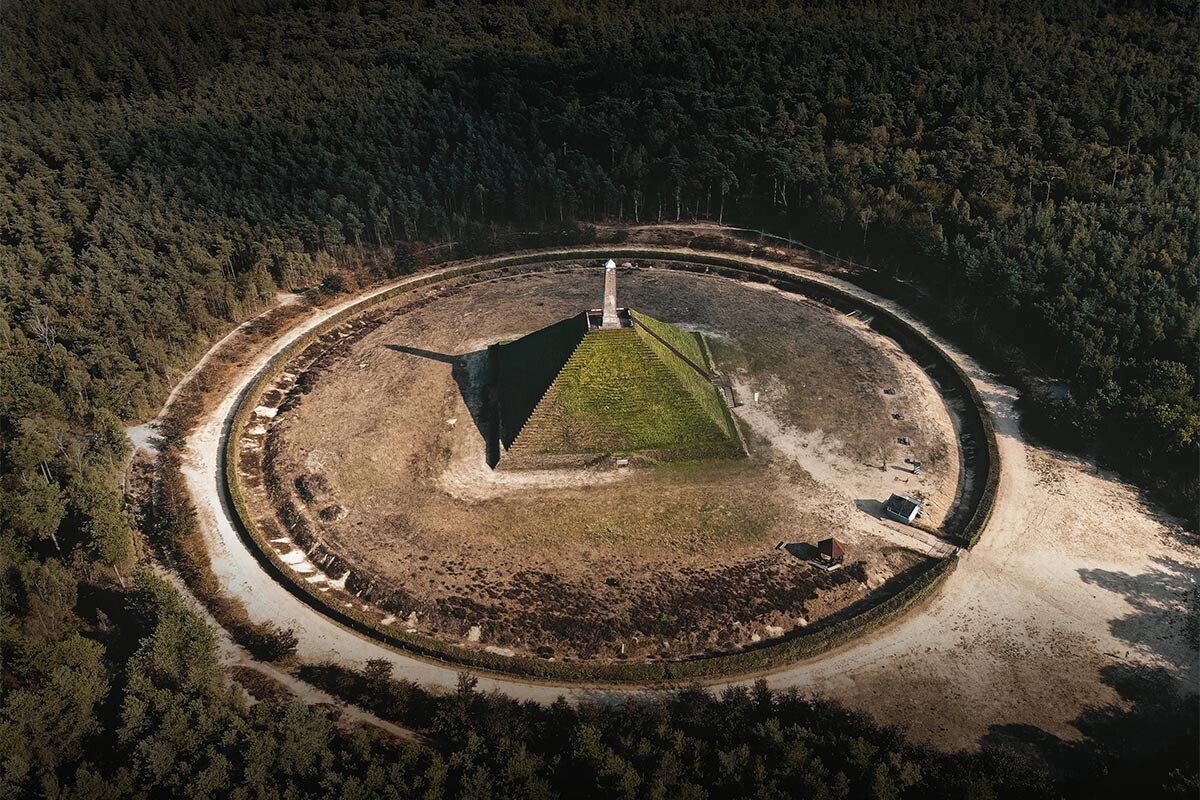
Entrance to the entrance to the Pyramide van Austerlitz
When arriving at the entrance it’s about a 300m walk till you reach the pyramid. Don’t forget to bring some cash with you. The entrance fee is around €3. They open at 10 a.m. and close at 5 p.m. and in the wintertime, they only open on Saturday. The winter season for 2019 is from the 29th of October till the 6th of April.
Even if it is closed it’s worth paying a visit, the only downside of that is that you can’t climb it.
If you are planning to visit the pyramid by car. There will be free parking spots available next to the entrance, in high season there is an opportunity it’s too busy.
More information about the Pyramide van Austerlitz can be found here.
Stay safe in the Netherlands | Travel insurance
When travelling this big wide world, I never go on an adventure without my essential travel insurance sorted out, and though the Netherlands is safe, I recommend anyone travelling here to do the same.
Though you rather don’t think about the things that could go wrong, there’s always a chance that something will happen, and when that’s the case, it is better to be safe than sorry.
To help you find the right policy, I’ve listed two of my favourite options below:
Heymondo | Whether you’re going on a 3-week backpacking trip, or planning a long stay somewhere abroad, Heymondo has excellent insurance options either way – plus full COVID-19 coverage and a handy app with 24-hour medical assistance. Readers of WTSW receive 5% off any insurance policy, more information here.
World Nomads | If you’re an adventure seeker, backpacker, or planning your once-in-a-lifetime world trip, make sure you check out World Nomads, they designed the perfect travel insurance to help you travel safer and smarter. Do note that they’re not covering COVID-19-related claims.


